
- Best Hikes In The World
- Appalachian Trail
- European Hikes
- Nepal Hikes
- Patagonia Hikes
- See All Hikes
- Mount Kenya
- Mount Kilimanjaro
- Mount Toubkal
- See All Mountains
- South Africa
- New Zealand
- Switzerland
- United Kingdom
- Packing Lists

Puncak Jaya – Climb One Of The Most Exotic Mountains In The World (Complete Guide)
Australia and Oceania , Climbs & Mountaineering , Seven Summits
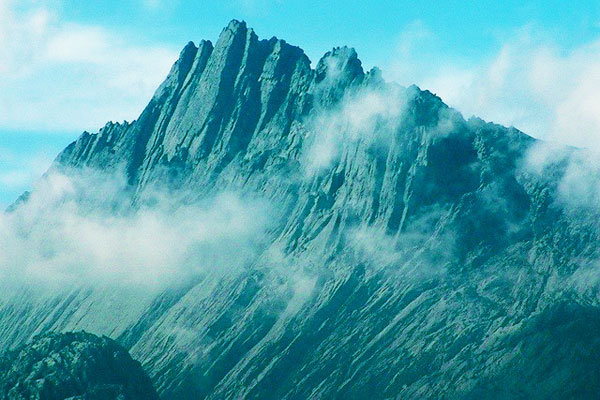
Are you looking for a serious physical conquest? If so, climbing Puncak Jaya or Carstensz Pyramid, one of the World's 7 Summits , may be perfect for you.
Read on for my guide on the Puncak Jaya climb, including route options and a typical itinerary, the best time to visit, how to get there and how to prepare for your climb.
Climbing Puncak Jaya
Puncak jaya overview.
The Carstensz Pyramid, also known as the Puncak Jaya, is the highest peak in the Australasian continent . The Carstensz name was given after Dutch explorer Jan Carstensz after he recorded his sighting of the glorious white peaks in the distance in 1623.
It is specifically located in the western central highlands of the Papua Province, Indonesia, amidst lush tropical jungle.
Altitude And Technicality
At 4,884m (16,024ft), it is considered one of the notorious Seven Summits , and as such is a rite of passage for serious mountaineers. Although it has the lowest elevation of the Seven, Carstensz is the only peak which is specifically a rock climbing peak and it has the highest technical rating.
Puncak Jaya History And Local Culture
The mountain was first successfully climbed in 1962 in an expedition led by Heinrich Harrer as well as three others. Its relative inaccessibility, government restrictions and political instability, as well as local tribal wars have meant that not many people have climbed it since this initial ascent.
Culturally, the region is almost unique. The Dani tribesman of the Beliem Valley first made contact with Westerners only in the 1960s, and many of the Stone Age Dani customs have been preserved.
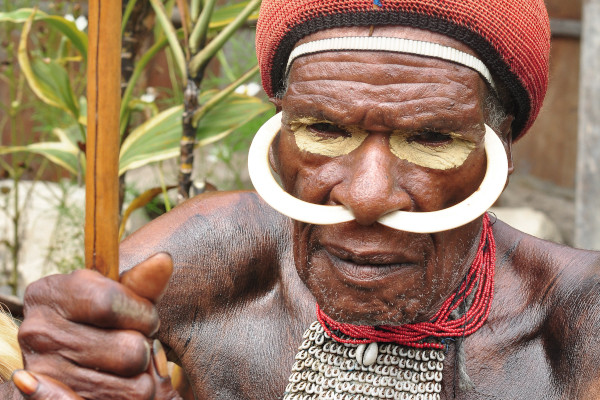
For example, traditional garb is still worn by men and women. Tourism has not significantly influenced the lifestyles of these people, so it is imperative that visitors are extremely sensitive to the importance of minimising their impact. For many mountaineers, it is the most exciting and interesting adventure of their lives.
Know Before You Go: Puncak Jaya
The “normal” route you will follow up Carstensz presents a series of gullies on 500m of solid rock on the north face of the mountain, after which you will break through onto the summit ridge.
Atop this ridge, you will scramble over uneven terrain for another 500m until you reach the summit.
It is important to remember, in planning this trip, that a high degree of flexibility is necessary. Political instability in the region and unpredictable weather mean that it is likely that you will have to accept a last-minute itinerary-change.
However, if you have the luxury of time, and are fascinated by new cultures and scenery, this magnificent climb is definitely worth it..
Puncak Jaya Climbing Routes
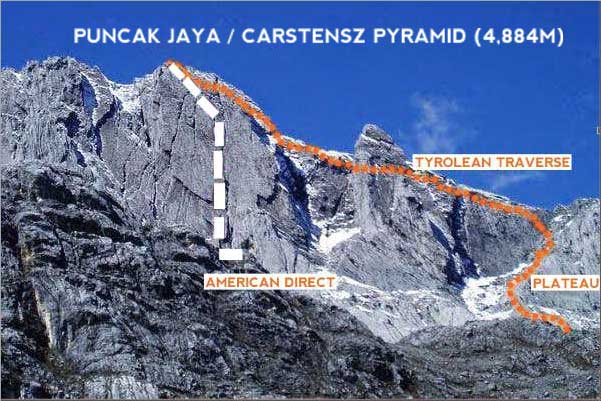
The first decision you must make before your climb is how to get to the mountain. Many tour companies offer a chartered flight to Timika , Papua followed by a helicopter to reach the Zebra Wall Base Camp .
From here, you’ll do a quick trek to the Lake Valley Base Camp where you’ll spend a day acclimatizing before you attempt your climb.
However, there is also the option of a 6-day, 67km trek from Ilaga or Sugapa (which you’ll arrive at by plane) through the heavy jungle. This trek is relatively strenuous and accommodation is in caves or tents along the way.
Check out the Itinerary below for more specific route information on the trek through the jungle.
Once your reach Base Camp, there are three different climbing options which lead to the summit of the pyramid. Using technical equipment, one of the routes is of “normal” or moderate difficulty, while the other two are significantly more challenging.
Normal Route (also known as Harrer’s Route)
In total, the ascent and descent on the Normal route takes 12 to 15 hours.
The route entails a 600m rock face to the top of a ridge. Just below the ridge and along the jagged cliff, there are fixed ropes to aid the climb. This section, just below the summit, is by far the most difficult.
One of the notches on the summit ridge is 20m deep and requires that one rappel the overhanging wall (VS, UIAA VI) pitch and leave the rope fixed to jumar on return. For the way down, you will need to manoeuvre on long ropes.
American Direct
This route, instead of including the traverse along the ridge, leads straight up the summit (see picture above).
This is the most exposed and difficult route – the most challenging section being the Carstensz headwall, again just below the summit.
The route lies between the normal and direct routes, with a long ascent and a lot of scrambling. Beware of loose rocks and tricky narrow sections on the East Ridge.
Typical Itinerary For Climbing Puncak Jaya
As mentioned above, there is the option of simply flying into Base Camp from Timika, instead of completing this strenuous hike through the jungle.
Below is a typical Itinerary for the Carstensz climb, including the trek to and from Timika, Papua.
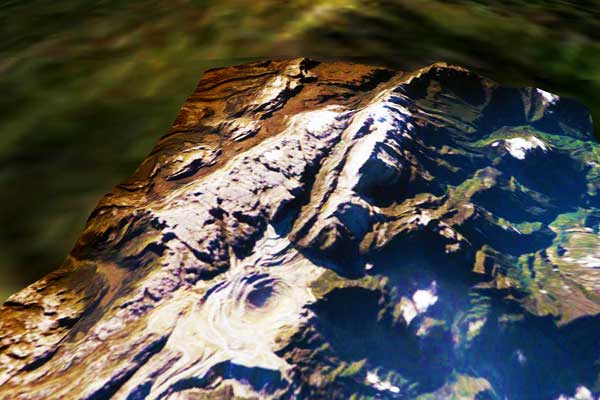
Day 1: Flight to Timika, Papua
Flight from Bali to Timika is approximately 3 hours. Here you will make the final preparations for your trek and climb. Overnight in a local hotel.
Day 2: Flight from Timika to Sugapa (2244m), and drive to Suanggama (2018m)
Quick, hour-long flight over the Papuan rainforest, landing in Sugapa. From here, you will hop on the backseat of a motorcycle to Suanggama.
Day 3: Suanggama (2018m) to Salt Factory Camp (2380m)
Distance: 15.5 km Duration: 6-8 hrs
From Suanggama, you will hike, loosely following the course of the river to a campsite in the middle of the jungle.
Day 4: Salt Factory Camp (2380m) to Indisaga Camp (3230m)
Distance: 17km Duration: 6-7 hours
Day 4 is the most strenuous trekking day. The path winds through thick jungle, over steep ascents and descents. Eventually, just before the Indisaga Camp, the rainforest abruptly opens up to a large clearing where we’ll set up camp.
Day 5: Indisaga Camp (3230m) to Ebay Camp (3584 m)
Distance: 11km Duration: 6-7 hours
The trek starts out through a light forest which opens up to a plane. You’ll continue onto a ridge, which marks the edge of another valley. You will set up camp on the ridge for the night.
Day 6: Ebay Camp (3584m) to Nasidome (3734m)
Distance: 13km Duration: 6-7 hours
On this day, you will descend the ridge into the other forested, ancient valley. You’ll cross the river on a natural stone bridge and wade through swampland before setting up the final camp before base camp.
Day 7: Nasidome (3734m) to Base Camp (4273m)
Distance: 8.64km Duration: 6-7 hours
The trickiest section of Day 7 will be the series of passes, the toughest is called the New Zealand pass, which is 50m long and can be quite slippery. You’ll then descend to the Base Camp at the foot of the Carstensz Pyramid.
Day 8: Ascent of the Carstensz Pyramid
You will start the day as early as 02:00, and, using one of the climbing route options mentioned above, summit the tallest peak in Australasia. After enjoying your success and the view from up top, you’ll return to Base Camp for celebrations by about 10:00 in the morning.
Note: Lingering for too long on the peak leaves you exposed to afternoon rainstorms.
Day 9-10: Hike back from Base Camp to Sugapa
Hike back to Sugapa via the same route. The way back should be quicker.
Day 11: Fly via Timika to Bali
Enjoy a well-deserved overnight stay in your hotel.
Reserve a few extra days, just in case, for bad weather or delayed flights.
Best time to climb Carstensz Pyramid
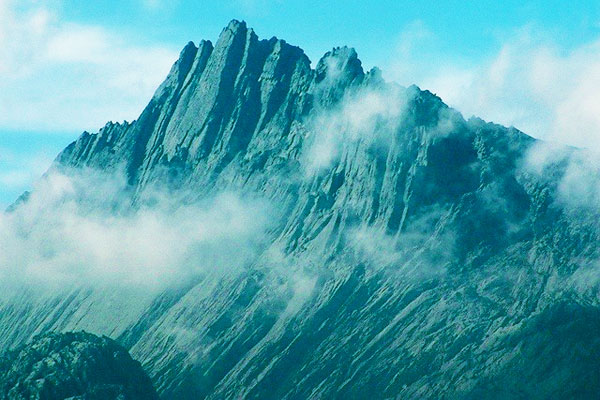
Unfortunately, the weather on Carstensz Pyramid is unpredictable and often bad. The good news is that there is no “best” time in the year for the climb, although most chose the dry season from April to November.
The weather is constantly changing at any time of the year and you should expect the worst (by that I mean, inundated with rainstorms, scorched by the sun, an even welcomed to the summit by an enthusiastic snowstorm 😵💫).
To avoid the majority of precipitation, most tour companies plan their ascent days in the early morning, when the chance of rain and snow is much lower.
It should be noted that these chaotic conditions are only really seen in the highlands, where the mountain is located. If you plan to trek to Carstensz through the rainforest, however, it would be prudent to choose the dry season – from April to November.
At all times of the year, in the rainforests, you can expect temperatures of around 77F (25°C) in the day time, which drop to about 41F (5°C) at night.
Even in the relatively dry season, you should be prepared for warm afternoon downpours. As you approach the base of the mountain, the likelihood of afternoon snow increases, temperatures drop below freezing, and strong winds are a possibility.
How Difficult is the Puncak Jaya Climb?
The trek to base camp is relatively strenuous, and requires that you are able to walk continuously with a 40-lb backpack for 6-7 hours per day, for days in a row.
This requires both physical and mental stamina. One of the most challenging features of the climb, however, is the exposure to chaotic weather which can often be overcome with careful and flexible planning, and with the right gear.
In addition to physical and mental resilience, the climb also imposes technical challenges, even on the Normal Route. Most experts consider the difficulty moderate, and many of the tour companies boast a nearly 100% success rate.
For the Normal Route, the climb is rated with an average difficulty of 3-4 UIIA, with most of the difficulty incurred just below the summit. The climb ascends a 600m wall, with a very steep final section.
At the bottom, the difficulty is graded VDiff (UIAA III) and at the top it increases to VS (UIAA V).
Fortunately, the rock is good and rarely loose. The difficulty varies with the East Ridge and the American Direct Route is by far the most challenging.
Is the Climb Dangerous?
Of course. Undertaking such a physical challenge always poses risks.
Although the number of fatalities are not strictly recorded, most are not the result of the climb itself, but instead are caused by heart conditions or other issues. Previous climbers have also expressed anxiety about the state of the fixed ropes on the mountain, which are notoriously shabby.
One of the most significant dangers of the expedition is not, in fact, the climb itself but that of navigating the surrounding region.
Although the area experiences periods of political calm, there have been incidents when visiting mountaineers have been at the brunt of regional tensions, been in threatening situations at the hands of local militants, and even had unpleasant encounters with an Indonesian SWAT team.
While the region’s remoteness adds to its allure, it also means that it can be very difficult to get out of an emergency situation, should things go awry. Chartered helicopters might be hired out elsewhere in the world, so it may be days before you can get out of the region.
We recommend that you monitor the political situation very closely, and speak to people who have been in the region recently to gauge how best to handle the situation, and whether the risk is foolhardy or reasonable.
For details on the conflict in the region see here .
Altitude Sickness
The effects of altitude sickness are commonly felt at anywhere over 3000m elevation above sea level. Because the Base Camp, and much of the trek, is significantly higher than this point, it is important that all potential trekkers are aware of the symptoms, potential effects and the ways of minimising the risk of experiencing these.
Firstly, it is important to note that it is impossible to predict the extent to which you will respond to high altitude as your response is not correlated to your fitness level, your age, or any other factor. Luckily, most mountaineers attempting Carstensz Pyramid will already have an idea of how well they fair at high altitudes.
Typical symptoms of acute mountain sickness (AMS) include fatigue, nausea and headaches. However, high altitude pulmonary edema (HAPE) and high altitude cerebral edema (HACE) can be fatal if left untreated.
To avoid altitude sickness, there are a number of tips that you should keep in mind:
- Acclimatise properly: tour companies incorporate enough time for acclimatization at Base Camp. This is especially important if you have opted to fly via helicopter into Base Camp instead of doing the 6-day trek
- Stay hydrated: drink about 3-4 litres of water each day of your expedition
- Avoid drugs or alcohol: even a sleeping tablet can cause you to have a raging headache
- Descend if you’re not feeling well: consult your tour guide to decide what the best way to deal with your symptoms are
Importantly, if you are concerned about the symptoms and have previously had difficulty at high altitudes, we recommend that you descend and consult a doctor.
Read our guide on altitude sickness here .
Gear Check List
The gear list is standard for a moderate-to-cold weather, multi-day hike and climb, with emphasis on waterproof and technical climbing gear. Because of the extreme weather changes, layering your clothes is important to be prepared for all potential conditions. And as always, avoid clothes made of cotton or denim.
Consult your tour company to decide what you need to bring from home and what you can rent from them. Click here for information on what the best brand options for various equipment are.
Permits & Costs
Many permits are necessary to climb and trek the mountain, which must be organised through the Indonesian government. It is recommended that you use a tour company, which will organise these logistics for you.
Most tour companies charge the same amount, regardless of whether you take a helicopter or trek to Base Camp.
The cost to climb Carstensz Pyramid is about $12,500-$25,000 per person. The range depends on the size of the group. Because of the risky logistics, we highly recommend that you do not skimp out and hire a cheaper company.
The inclusions and exclusions of the touring companies are also very important, given the political unrest in the region.
The cost of the typical expedition companies include: standard flights from Bali to Western Papua and back, accommodation during the trip, all meals, group camping equipment, climbing permits, porters and professional guiding support pertaining to the climb itself.
However, most expedition cost notably do not cover the costs of the (relatively likely) delays which are beyond the groups control. It also excludes the cost of a rescue mission from the region, should this become necessary.
Other costs which are not included in the flat rate are the significant cost of international travel, personal equipment, accommodation and meals in Bali and travel insurance.
To give an idea, a flight from New York to Bali is typically in the region of a further $1800.
Getting There
Most of the tour companies plan their itineraries to start in Bali. This way, whether you are planning to charter a flight and helicopter ride to Base Camp, via Timika, or are trekking there from Suanggama, you will not have to organise the intricate transport plans.
Training for Carstensz Pyramid
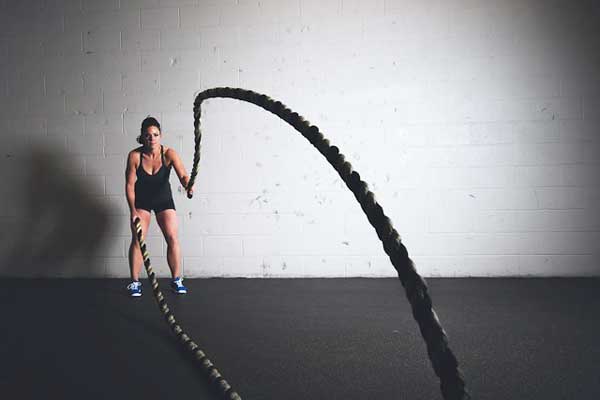
Although Carstensz Pyramid via the Normal Route is not a particularly difficult climb, you must be familiar with scrambling, working with fixed lines, rappelling and jumaring.
You should be comfortable with routes of a difficulty up to 5.8 (5.0 to 5.7 is considered easy, 5.8 to 5.10 is considered intermediate, 5.11 to 5.12 is hard, and 5.13 to 5.15 is reserved for elite climbers). Many tour companies offer short, alpine courses which can help you to gain skills and confidence in technical mountaineering.
In addition to technical proficiency, you will need to build your strength endurance as well as your cardiovascular capacity. Remember that being fit enough to run a marathon does not mean that you will be able to handle the challenges of a high-altitude peak. This is because pure aerobic fitness is not enough. Your training regime should focus on all of the following:
- Climbing conditioning: walking or hiking up hills or stairs carrying packs up to about 40 lbs
- Strength exercises: for lower body and core. This includes sit-ups, squats and lunges.
- Cardiovascular workouts: Aerobic and anaerobic, including cycling, running or swimming.
- Flexibility training: this decreases your chance of injury
Off a relatively solid baseline fitness, you should start training properly for Carstensz Pyramid at least 3 months before your trip.
Typically, your training strategy should involve increasingly difficult work-outs by ramping up your workout time, distance and elevation gain by about 10% each week. Be careful not to rush this process, as this may lead to injury or insufficient preparation.
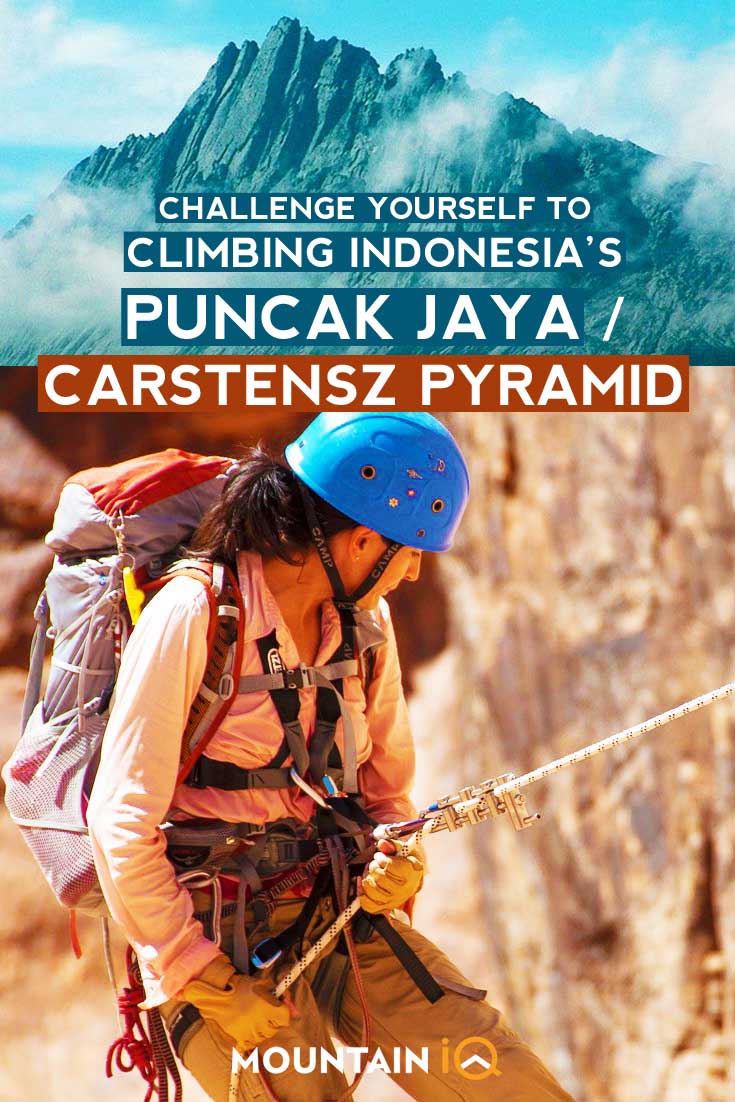
About the author
Mark Whitman
Mark has trekked extensively in Asia, Europe, South America and Africa. He founded Mountain IQ in 2014 with the sole aim to be the best online information portal to some of the most popular mountain destinations around the world. When not writing for Mountain IQ, Mark is out exploring the outdoors with his wife!
Leave a Reply
Your email address will not be published. Required fields are marked
love to do it again
I’d like to climb Carstensz and trek in from Suanggama but I can’t find a guide service that offers that. Could you recommend someone?
Hi Christian, I unfortunately don’t know any who offer that route. Have you tried Jagged Globe or Mountain Madness?
We work with local guides to offer great value adventures at unbeatable prices

- Mount Kilimanjaro
- Mount Kenya
- Mount Toubkal
- Mount Aconcagua
- Mount Everest
- Mera Peak and Island Peak
- Mount Kinabalu
- Himalayan Mountains
- Borneo treks
- Nepal treks
- Moroccan Atlas treks
- Treks in East Africa
- Trek in Europe
- Wildlife Safaris
- School Expeditions
- Family Holidays
- Medical Electives
- Volunteering
- Private Expeditions
- Indonesia and Papua
- Experiences
- Trip Finder
- Trip Leaders
- Sustainable Tourism
- Adventure blog
- Add a review
- Trip reviews
Ask Us A Question...

Climb Puncak Jaya or Carstensz Pyramid
- Carstensz Pyramid
Dates & Bookings
Puncak jaya (carstensz pyramid) indonesia, 4884m.
Carstensz Pyramid , also known as Puncak Jaya is one of the famous 'Seven Summits' situated on the Indonesian island of Papua New Guinea. This peak is the only of the Seven which is a rock climbing peak and it requires a trek in through remote jungle to reach the base camp. The peak is in west Papua (now named Papua province Indonesia) and was called Irian Jaya until 2005. It lies in New Guinea, which is the world"s second largest island.
Relatively few people have climbed Carstensz due to a history of political instability in the area and the difficult of its location deep in dense jungle. Conditions are very diverse and often challenging, so be prepared to trek in the heat of the jungle, and climb in snow. The rock itself is good climbing rock but very sharp so bring a good pair of gloves. It can be climbed all year round and is a very exciting and dramatic expedition, definitely one of the most difficult of the Seven Summits despite it being the lowest.
Getting to Puncak Jaya (Carstenz Pyramid)
Co-ordinates are S 04°04.733, E 137°09.572. The normal way to reach the mountain is a six day 67 km trek through the jungle from the village of Ilaga or Sugapa which is reached by a light aircraft from the town of Nabire. The height gain is 4000 metres during the trek and is quite strenuous requiring good balance on the fallen trees and along the trail which is heavily forested. Accommodation is in tents or in caves along the way, and it is common to experience tropical rain showers. Carstensz Pyramid stands out like a great fin of rock rising out of the jungle and its first sight has attracted many emotional reactions for climbers emerging from the dense undergrowth to be faced with such a dramatic sight.
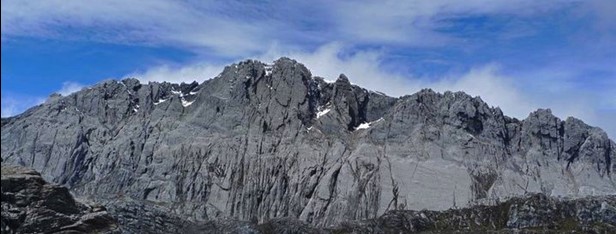
It is the only one of the Seven Summits to involve technical rock climbing and therefore members should have suitable experience with ropework and abilities up to Severe. In particular are several notches on the summit ridge which involve a dramatic Tyrolean traverse.
Climbing route on Puncak Jaya (Carstensz Pyramid)
The normal route is the one that Heinrich Harrer opened up, which ascends a 600 metre wall; it's imposing and sheer with the bottom half being easily angled and the final top section very steep. The rock is clean and sharp but the wall itself rarely presents a problem. Initially the grade would be a VDiff (UIAA III) with the top at VS (UIAA V). There are fixed ropes in place below the ridge and along the jagged edge to the summit. The crux of the climb is an overhanging wall (VS, UIAA VI) that can be crossed using the fixed lines and jumars or by setting up a Tyrolean traverse.
The whole summit day is about 12 hours and involves scrambling on sharp rock in the dark up narrow chimneys and gullies until you reach the summit ridge. One would expect a range of weather including rain and mist and wind, possible snow showers or potentially clear skies with great views from the top. Temperatures on the summit are often well below freezing, and Base Camp can be 12 degrees Celsius. The descent involves rappelling or abseiling down the fixed lines.
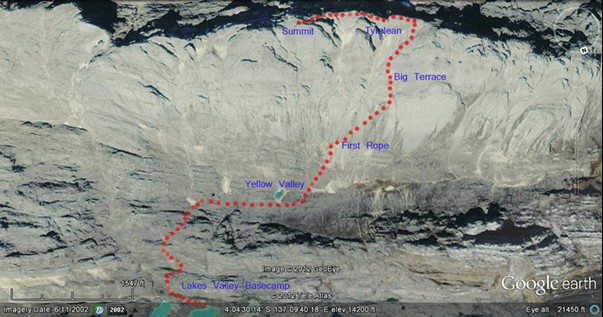
History of Puncak Jaya (Carstensz Pyramid)
The word Carstensz is often mis-spelt but the peak is actually named after the first European to see the mountain whose name was Jan Karstens. He was a Dutch seafarer who in 1623 brought news back to Europe about a snow-covered mountain on the equator (actually 4 degrees South of it). At the time he was not believed, a similar story to the first European to see Kilimanjaro. Nowadays the peak is also called Puncak Jaya which translates as Victory Peak and is popular name among Indonesian communists.
It was Austrian climber Heinrich Harrer who in 1962 became the first mountaineer to climb Carstenz and his book about the climb and life in Papua called 'I Come From the Stone Age' was a best seller. His story and eventual fate was depicted in the movie 'Seven Years in Tibet' starring Brad Pitt. A few years later in 1971 Tyrolean mountaineer Reinhold Messner climbed Carstenz as part of his Seven Summits odyssey which he successfully completed in 1986.
Geography of Puncak Jaya (Carstensz Pyramid)
It's geographical location is to the west of the central highlands and the Sudirman Mountains. Rather poetically, it belongs to the legendary Snow Mountains, so named because of the snowfall that commonly falls above 400 metres. At 4884 metres it is the highest mountain in Australia and Oceania, collectively known as Australasia and, depending on your interpretation of a continent, it is one of the Seven Summits. The definition is still a point of debate because it depends on whether one considers a continent geographically or geologically. If New Guinea is regarded as part of the Australasian continental land mass then Carstenz is indeed the highest. Either way it is a significant expedition and far more challenging than Kosciusko.
Map for reaching Irian Jaya
Most people opt to fly into Jakarta with one of many international airlines, or else to Bali. From there the route to Timika or Nabire on West Papua is with Indonesian airlines Lion Air or Batik Air, normally via at least one stop enroute (for example Ambon). Bear in mind that it takes almost a full day to get to Papua from Jakarta.
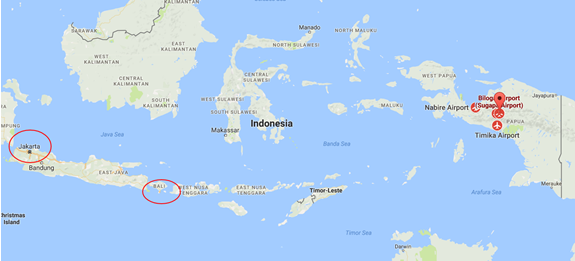
Here is American climber and blogger Alan Arnette crossing the traverse. The descent involves rappelling or abseiling down the fixed lines.
Carstenz Pyramid/Puncak Jaya itinerary
The itinerary is a guide only, it is necessary to allow extra days for flexibility in case of bad weather or local politics which might delay the departure. International flights should be into Jakarta or Bali, with onward flights booked to Nabire for the trekking trips and Timika for the helicopter trips.
From Nabire we will arrange the light aircraft into Sugapa or Illaga where the trekking trip begins. For the helicopter option, the flight lands at base camp and we generally allow three full days to climb the mountain.
Trekking trip itinerary
Helicopter trip itinerary
£11,000.00 for helicopter trip (10 days), based on 4 pax or £11,500.00 for the trekking trip
We try to ensure a minimum team number of four, and sometimes this means joining other teams which makes the logistics and costs easier to manage.
- All permits to climb the mountain and travel in the local area
- Accommodation at hotel in either Timika or Nabire
- Experienced local mountain guides
- Porters trekking (1 Porters each clients Max 17 kg)
- Meals during the expedition
- Group equipment (tents, dining tent, cooking utensils)
- Internal flight or helicopter
- Use of fixed line and Tyrolean traverse on summit day
- International flight to Irian Jaya (Nabire for trekking trip or Timika for helicopter trip)
- Travel insurance covering cancellation and medical/evacuation
- Excess baggage on flights
- Personal climbing and camping equipment
- Personal expenses
- Indonesia entry visa fee ($US25/Person)
This trip is priced in US dollars and we require full payment at least three months in advance of the date of the expedition. It is vital that you purchase travel insurance when booking the trip.
A significant portion of the trip cost is for permits and local payments to government agencies and tribal chiefs. It is possible to refund some of this money if the trip is cancelled prior to arrival but once the trip starts then there is no refund if local politics prevents travel. We will always take advice from local people about the situation locally before making any financial commitment regarding the permits.
Kit list for Carstensz Pyramid
The trekking route its hard and tough, trekking through cloudy-rain forest, hilly terrain, muddy trails, highland swamps, crossing rivers and walking around 7-8 hours a day. Clothing for the trekking part of the trip should be long sleeved and strong enough. If you are doing the helicopter trip straight into base camp then the jungle clothing is not necessary, but it can be cold and rainy and snowing so make sure you have warm clothing to change into immediately.
The climbing section will likely be on cold terrain with rock and snow or ice, so warmth is important. The rock itself is quite sharp so working gloves which you don't mind being ripped will be important. Climbing gear will include a harness, helmet, slings, jumar and descender.
Travel and trekking gear:
- Passport and visa, money
- Duffle bag which is waterproof and lockable
- Trekking clothes for 6 days walk-in and 3 days walk out (shorts, trousers, quick dry Tshirts and tops)
- Trainers, wellingtons, umbrella, poncho (assume wet and humid)
Climbing Gear:
- Climbing harness with belay loop and leg loops
- Locking karabiners and several snap krabs
- Jumar (ascender) with 'cows tail'
- Several slings and prussik loops
Clothing for the climbing section
- Hiking boots, lightweight, ankle high
- Several pairs climbing socks
- Wellingtons or rubber boots for the muddy trails in the jungle
Body Layers:
- Two pairs of climbing/trekking trousers
- Base layers
- Midweight fleece layers
- Warm jacket with hood - can be synthetic down or heavy fleece
- Waterproof shell layer - top and bottom
Headgear and Handwear:
- Leather/climbing gloves
- Lightweight inner gloves
- Heavyweight warm gloves
- Warm hat and buff
Personal Gear:
- Backpack of about 35 litres
- Sleeping bag, rated down to 0 degrees Fahrenheit, in a waterproof compression sack
- Sleeping mat, one inflatable and one closed cell
- Headlamp with spare batteries
- Couple of water bottles or bladders and water purification tablets
- Anti-malarial tablets, insect repellant
- Various waterproof stuff sacks
- Plenty of garbage bags
- Camera, book etc plus charging devices
We will supply tents, stoves, all the group food, ropes and fixed lines, and any gear for protection, a GPS, satellite phone and medical kit.
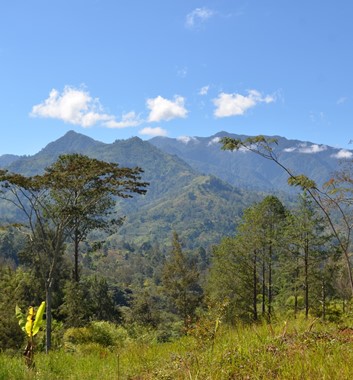
Final payment due 12 weeks prior to departure on this expedition in order to pay for permits.
We run this trip with a minimum of three members. Tailored dates for private groups are welcomed.
- Duration 21 days
- Challenge Strenuous
- Altitude 4884m
- Comfort Camping
- Travel Insurance
- Trekking boot advice
- Acclimatising safely
- Sleeping bag advice
- Mount Aconcagua Horcones route
- Machame Route Kilimanjaro
- Mount Everest, 8848m
carstenz pyramid
Puncak jaya.

- New Zealand
- North Korea
- American Samoa
- Papua New Guinea
- Solomon Islands
- Philippines
- Vatican City
- Dominican Republic
- Liechtenstein
- Personal Development
- How To Start A Blog
Climbing Puncak Jaya: How To Summit Carstensz Pyramid
April 11, 2023 | Views: 6,880
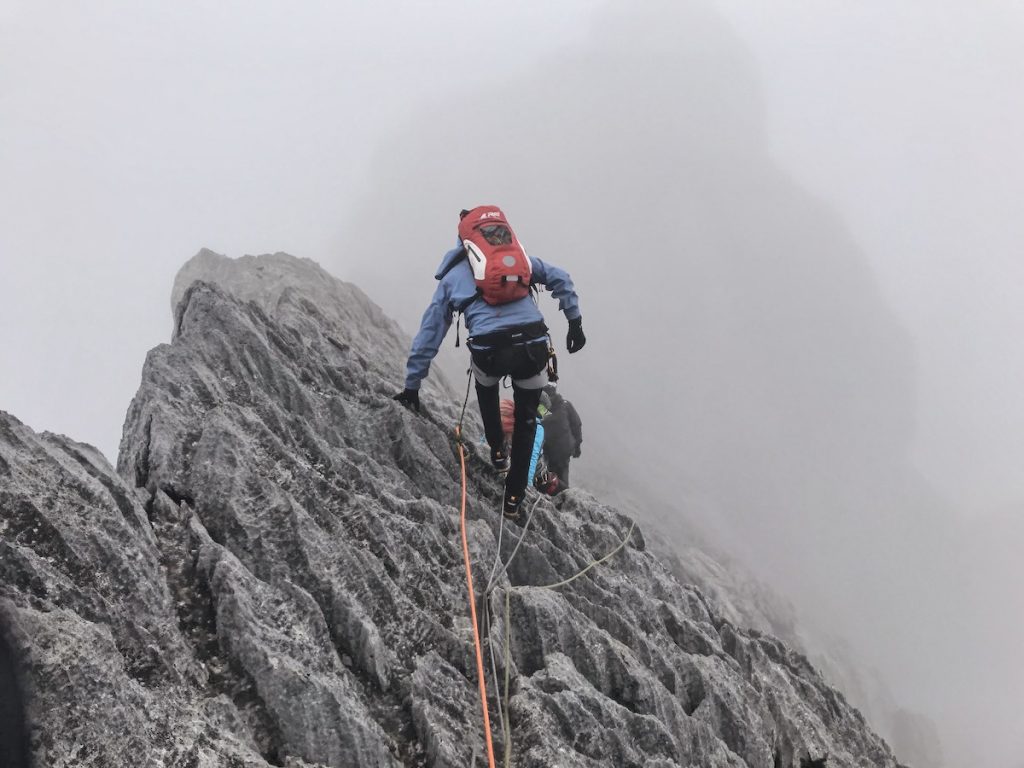
With fewer than 500 people having ever conquered the peak, climbing Puncak Jaya might not be the first name you think of when your mind turns to mountain exploration.
Set in the heart of the highlands within Indonesia’s island of Papua, the pretty peak nails down the bragging rights of being the tallest mountain in Indonesia and Australia (it’s complicated, but don’t worry you’ll get it by the end of this post).
With little information on climbing Puncak Jaya, which is also an official Seven Summits mountain ; I’ll try my best to paint the picture of what it entails, after summiting it myself in 2019.
Table of Contents
Meet Puncak Jaya: The Tallest Mountain in Southeast Asia (& Australia)
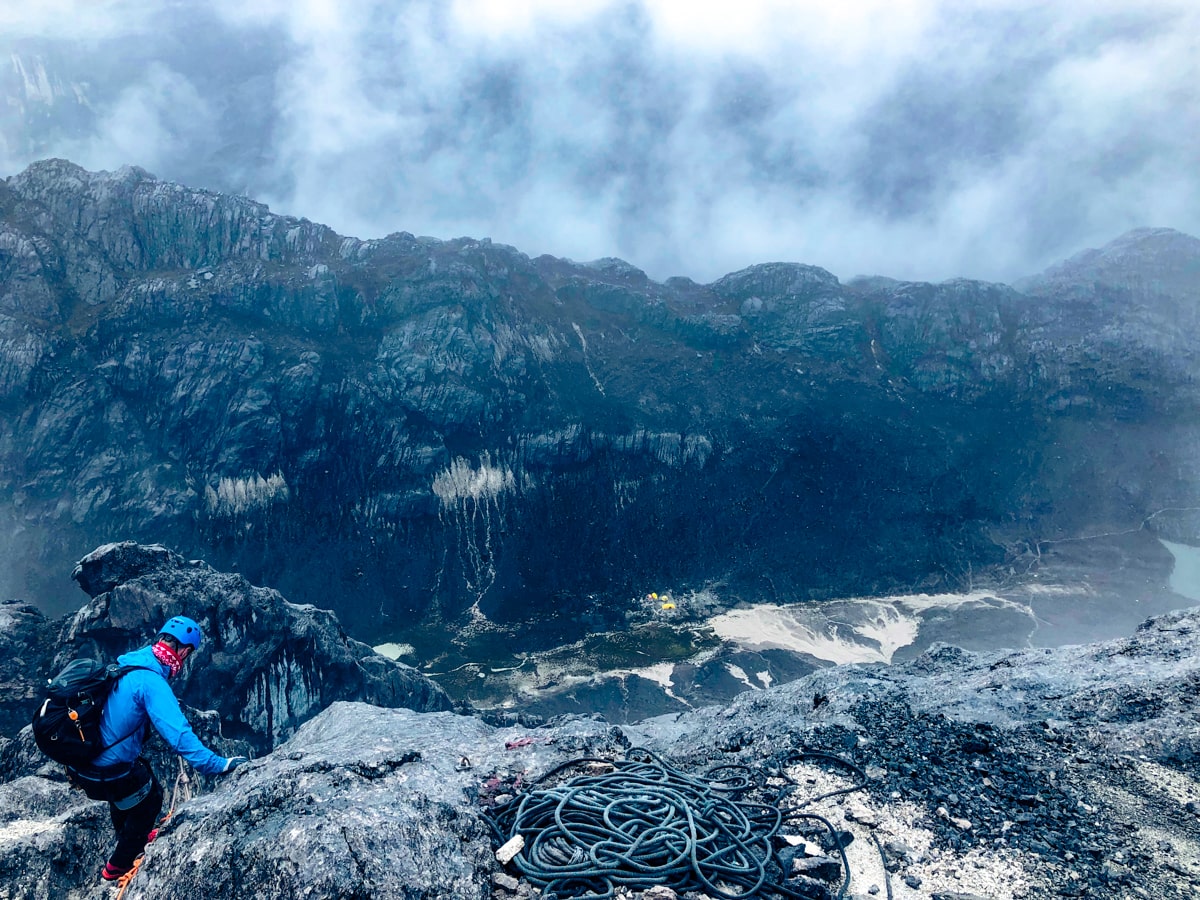
When it comes to major mountain peaks around the globe, most people can name Everest, Kilimanjaro and Mont Blanc straight off the bat. But, the name Puncak Jaya, also known as Carstensz Pyramid will probably have you scratching your head if you’re not heavily involved in the world of mountaineering.
Standing at just over 4,884 metres (16,000 feet), Puncak Jaya is the highest mountain in the region, making it one of the infamous Seven Peaks. The mountain rises from the western half of New Guinea island; the Indonesian half is known as Papua.
The size of this jaggery bump makes it the tallest mountain in Indonesia, and Southeast Asia but also in Australia too.
I can already feel the wrath of reading Aussies screaming; “it’s Kozzie you dickhead” at me. I’m on it, and I’ll explain why Mount Kosciuszko isn’t technically Australia’s highest peak next…
This all might get a little confusing, and you’d be forgiven for thinking so too. Most of us born in my era are used to naming all seven continents and including “Oceania” on that list. Yet that term doesn’t help us much when we’re thinking of continents, as Oceania is actually a region made up of thousands of islands, rather than an official continent.
Continents are geographically defined by their continental plates and the Australian continental plate includes the nation of Australia and the island of Papua – making Puncak Jaya the highest mountain in Indonesia and the continent of Australia.
In short:
- Mount Kosciuszko is the tallest mountain in the country of Australia .
- Puncak Jaya (Carstensz Pyramid) is the tallest mountain in the continent of Australia .
- Indonesia is geographically in Asia, where Mount Everest is the tallest, but the country stretches out to the continent of Australia (which is where Puncak Jaya lives).
Known as “Nemangkawi” to the tribespeople of Papua , the mountain was not known by Europeans until 1623. The first outsider to catch sight of the peak was Dutch Explorer Jan Carstenszoon, from whom the mountain was given one of its alternative names, the Carstensz Pyramid.
It wasn’t until 1962 that a successful climb was made, headed by famous Austrian mountaineer and Tibetologist Heinrich Harrer – known for climbing the north face of the Eiger, his time teaching the teenage Dalai Lama and the lesser impressive accolade of being a former member of The Nazi Party .
Climbing Puncak Jaya is one of the most difficult climbs out of all the Seven Summits for a multitude of reasons. Its sheer isolation in the highlands of Papua presents its own set of obstacles, once including the dodging of violence and kidnapping by tribespeople. On top of this, the steep climb requires the skilled use of rappelling and jumar techniques.
It’s really no easy feat, so I’d recommend preparing well.
How To Get To Puncak Jaya
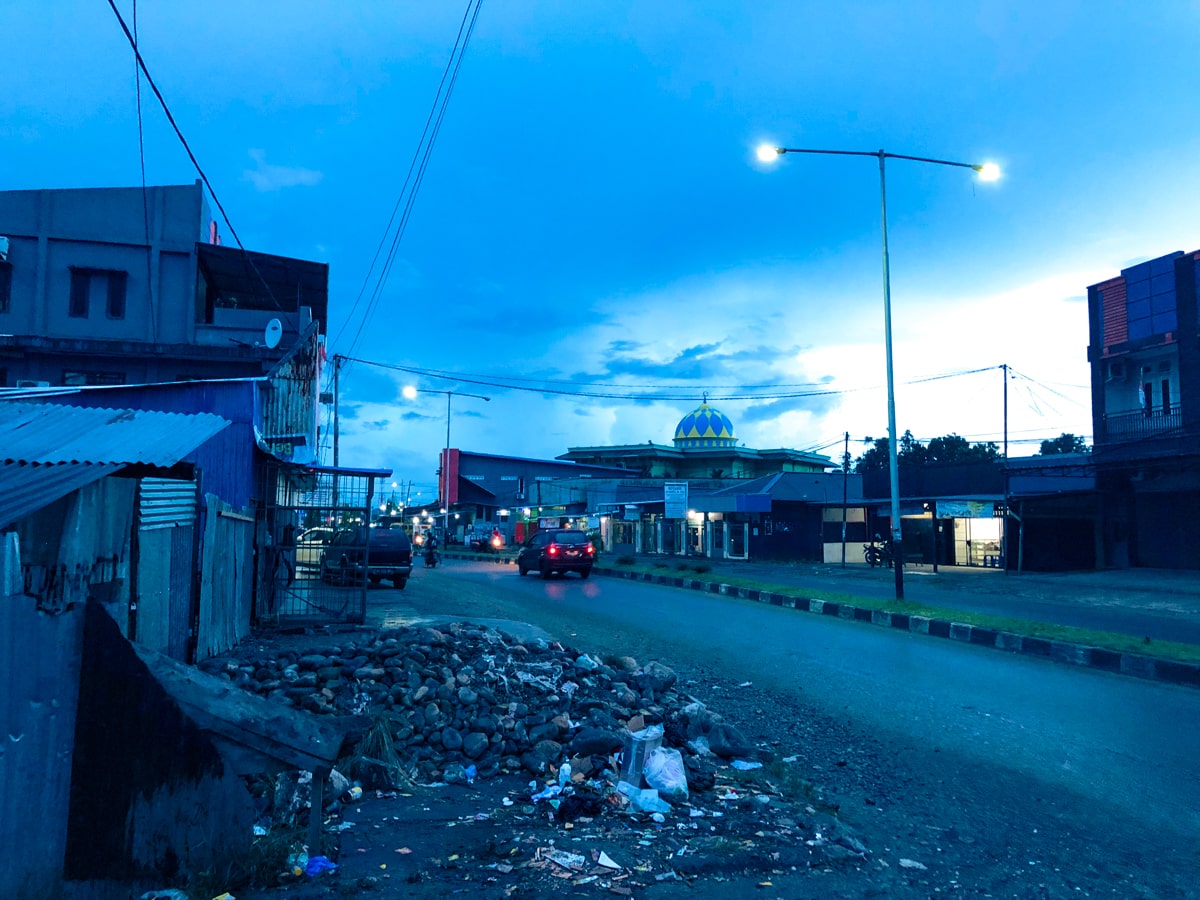
Before attempting the Puncak Jaya climb, you have to make your way to the base camp. This is no easy task for a summit isolated in the highlands of a tropical island and I thought backpacking in Papua New Guinea was hardcore travel!
The first thing you’ll need to do is catch a flight to the Papua town of Timika, on the southern edge of the island and just south of the mountain. This isn’t your everyday commercial destination, and most flights will nearly always have to fly from an Indonesian destination.
The Indonesian flag-carrier flight company is Garuda Indonesia and it is through these that you’re more likely to secure a flight to Tembagapura before taking a 90 minutes drive (provided by your tour company) to Timika Town Centre. To avoid any confusion; Timika Town is outside of the airport, which is in the tongue-twister of a name Tembagapura but the airport is still commonly referred to as Timika.
Bali provides the best jumping-off point to fly to Timika Airport, official name Mozes Kilangin International Airport (TIM).
Once you’re in the town of Timika your route to base camp will largely depend on your guide and your willingness to spend. It used to be common practice, and still is with some guides, to hike your way through the Papua jungle to the base camp, but this is becoming less common due to safety concerns .
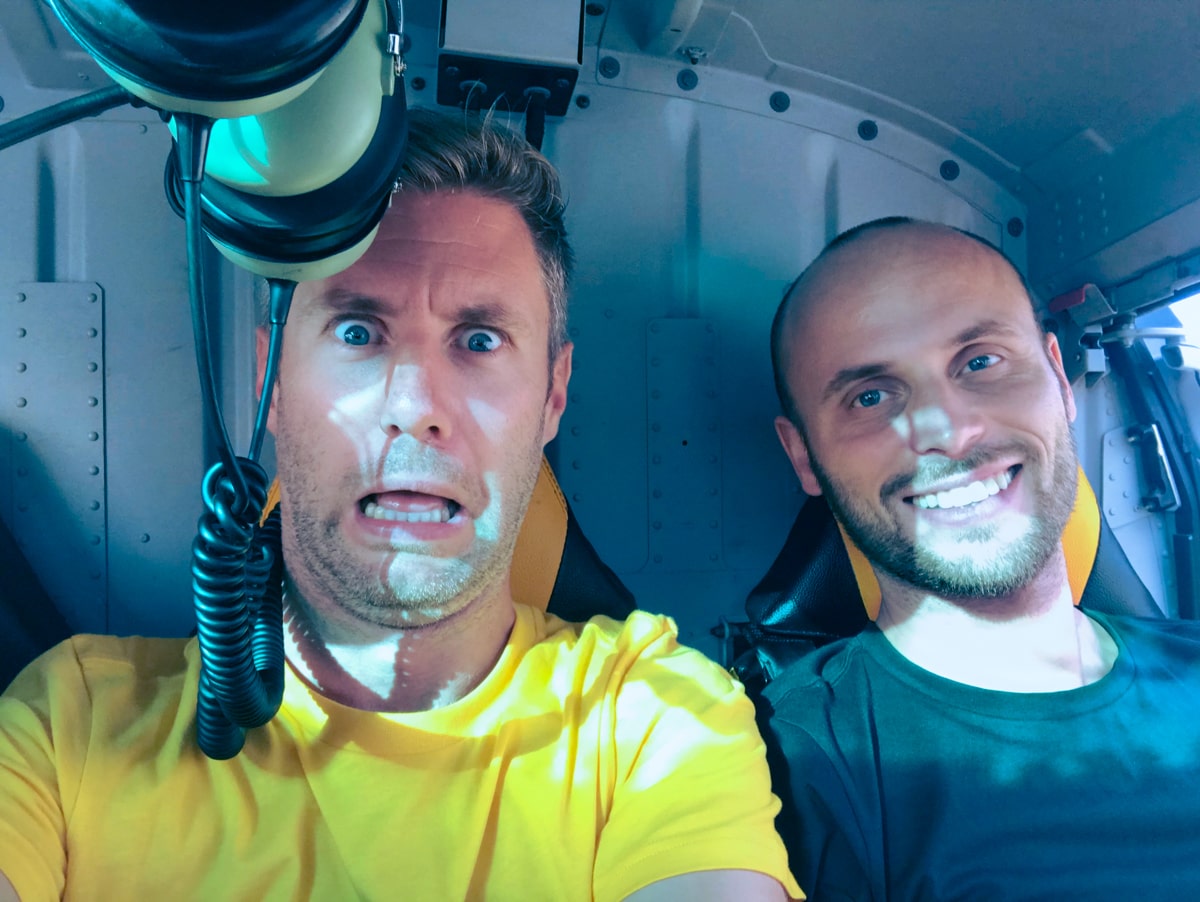
Local guides are becoming more reluctant to make this trek as the indigenous tribes and dissident rebels have noticed they can make a pretty penny by holding hikers hostage until large sums of ransom are paid – previous encounters have even ended in murder when these randoms haven’t been paid.
The other much safer and more expensive option is to charter a helicopter from Timika to the base camp. This, of course, would be far more favourable to many and throws in the chance to see the jaw-dropping landscapes of the jungle, and mountains and fly right over the biggest gold-producing mine in the world .
Best Time of Year To Climb Puncak Jaya
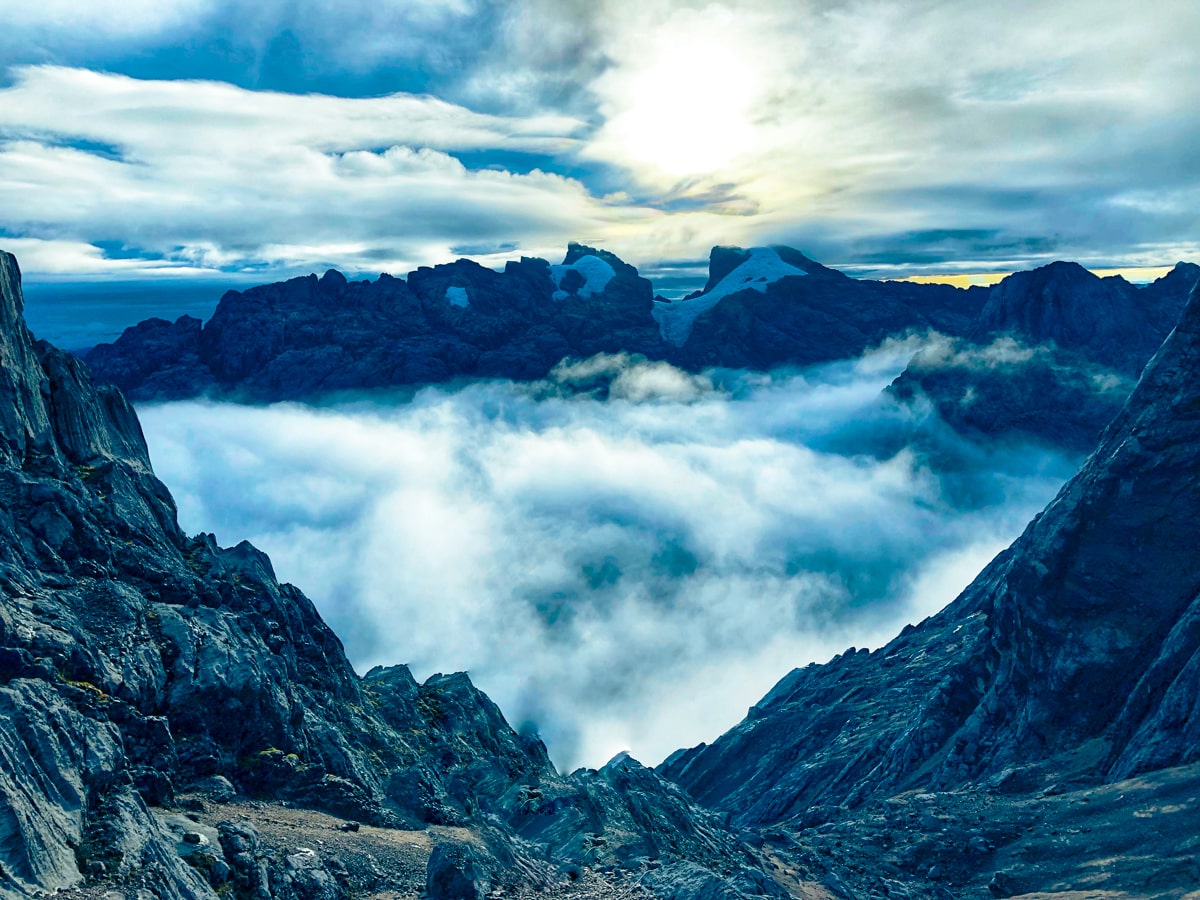
Climbing Puncak Jaya successfully will highly depend on the weather conditions on the mountainside and being so close to the equator, these conditions typically change fast and with little warning on a tropical region mountain.
The positive slant on this makes it an all-season mountain, unlike the likes of Aconcagua ( which I have failed to summit twice at the point of this publication, let’s hope 3rd time’s the charm).
That being said, there is still an optimal time for climbing Puncak Jaya; it’s best to attempt the climb during the region’s dry season. The dry season in this area of Indonesia starts in April and lasts until around October/November time.
While it may be dry season at base camp, weather conditions on the mountain itself can jump from dazzling and sunburning rays to whipping winds and slippery, menacing rainfall (or even glacially ice) near the summit.
The main issue here though is the rain, as it’s a very technical mountain and attempting the climb in dryer conditions makes a much safer climb with a higher chance of a successful summit.
Can You Climb Puncak Jaya Independently?
The short answer to this question is both no and why would you want to?!
You’ll need to get a permit that’s been granted by the centralised government from the Indonesian capital of Jakarta to make the climb in the first place. These are tricky to get, but tour operators will guide you through the process and help you fill in the unruly paperwork.
Besides the red tape you need to power through, there’s the bigger problem of actually navigating the island and the highly difficult climb. If you’re planning on hiking to basecamp, rather than chartering a flight, having a local guide with knowledge of the jungle and its tribespeople will be essential and, quite literally, life-saving – but I can’t make any promises.
The physical climb to the top of Mount Puncak Jaya is one that demands a high level of skill, and without the knowledge of rappelling and jumar climbing techniques, you are doomed to fail without a guide.
Cost of Climbing Puncak Jaya
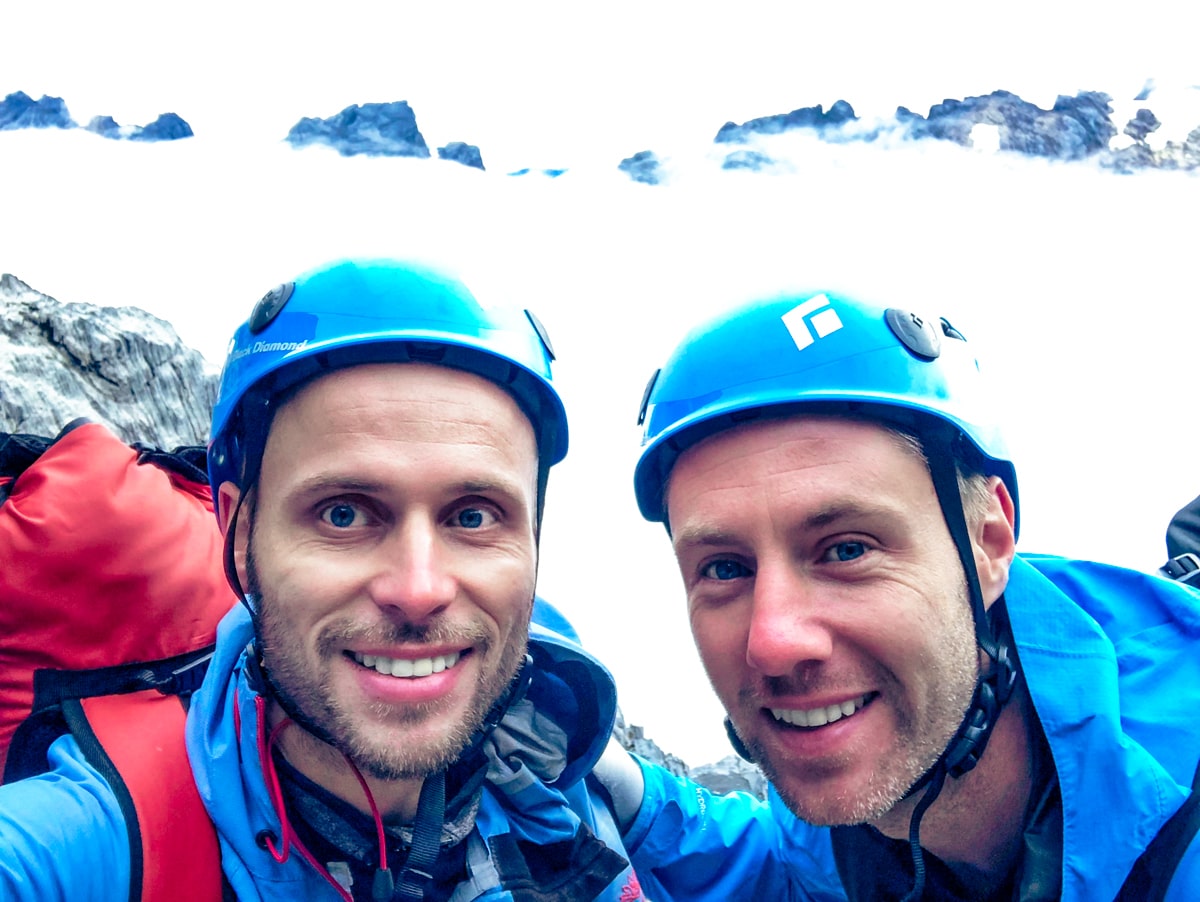
Climbing Puncak Jaya isn’t exactly a cheap hike like the DIY climb of Japan’s Mount Fuji . In fact, it might well be one of the most expensive for you (it was for me and that’s with an amazing discount). But, for those who believe in the notion, the satisfaction of successfully climbing one of the seven summits and such an elusive mountain is absolutely priceless.
It’s not uncommon to be quoted a fee of $20,000 USD per person, sometimes higher. Shopping around and doing a little in-depth research means you may find a local tour operator that will quote you closer to the $8,000 USD mark.
My mate Johnny found this smashing deal with the company Summit Carstensz , but it took him a lot of shopping around and grey hairs to find a price this impressively low.
3 Routes For Climbing Puncak Jaya
There are three distinct routes to climb to the peak of the Carstensz Pyramid, but most opt for the “normal route”. Ultimately, your guide will choose which route you will take to the top based on the day’s weather conditions and your own climbing abilities.
Normal Route (also known as Harrer’s Route)

The most common path to the summit of Puncak Jaya is the route first-ever made by Austrian mountaineer Henrich Harrer and his team in 1962. The total ascent and descent along the “normal route” takes between 12 and 15 hours.
It involves climbing the 600m rock face to the top of the ridge and then traversing along the jagged cliff before using the fitted ropes to scale the extremely steep rock face. This is of course, what I, a mere pleb mountain climber out of his depth, did – but I thought I’d list the other options for any badass pros out there.
East Ridge
The East Ridge route is considered to be the medium-difficult route to climbing Puncak Jaya. The ascent on the East Ridge route is far longer and requires a little more scrambling over sharp rock. With East Ridge, rockfall is also a common problem, and the pathway up the mountain is far more narrow than the other routes you can choose.
The American Direct
The American Direct route is the most challenging when it comes to climbing Puncak Jaya but, as the name suggests, the most direct. A very exposed route, the American Direct takes a direct path up the mountain instead of traversing along the ridge that leads up to the summit.
This route does get more difficult as the climb goes on, with the hardest being the steep Carstensz headwall. This route certainly isn’t for the faint-hearted and will often only be attempted by seasoned climbers.
Packing List for Climbing Puncak Jaya
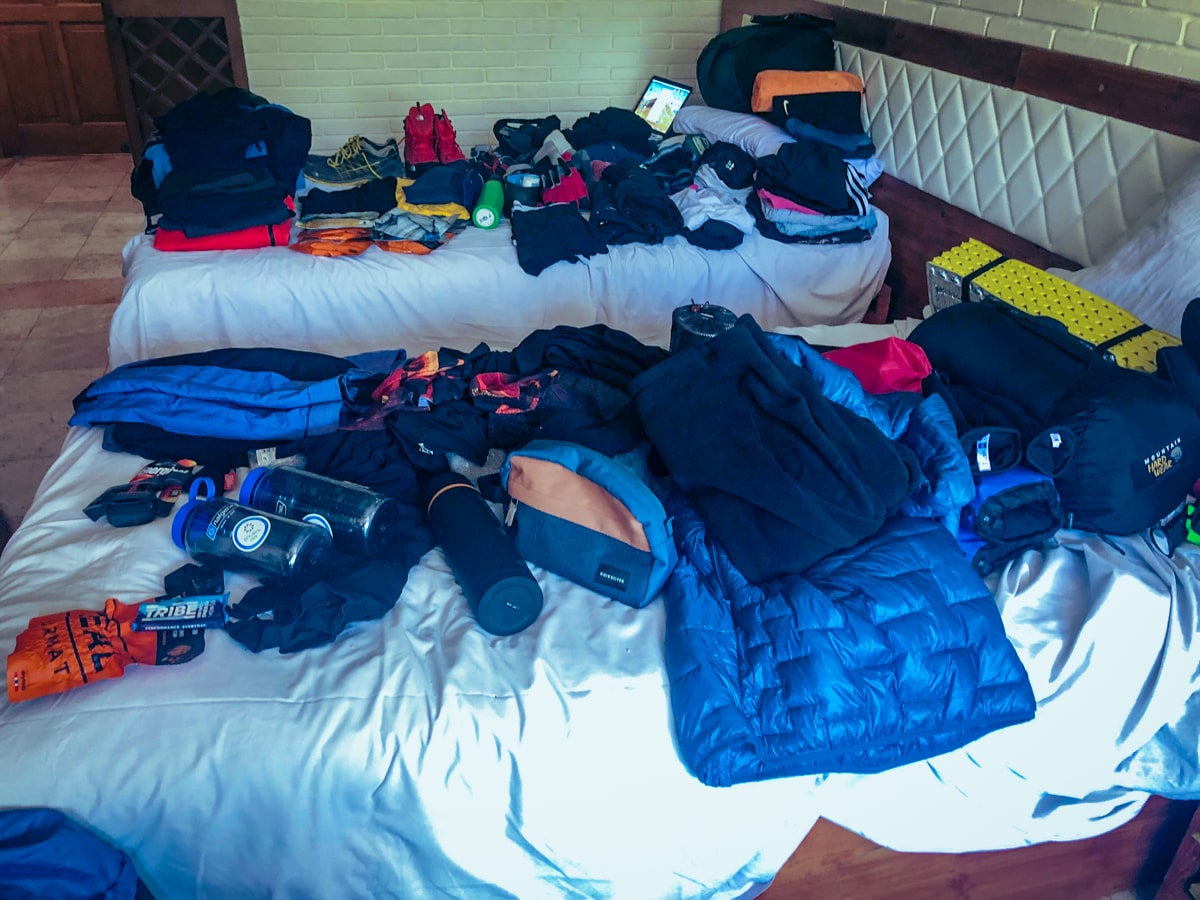
When it comes to climbing Puncak Jaya you need to get the right balance between packing too much and too little, especially when it comes to your summit bag. This is a much shorter expedition to the longer hikes of a mountain that I and others reading this have climbed, so you can get away with more comfort at base camp.
Puncak Jaya offers some of the most difficult climbing in the world for those leaving the ‘beginner’ level and attempting to move on to the next – this, combined with its tropical location will affect the type of gear you need.
You can rent some of the gear when you get there, though it’s good practice to bring your own along so that you are more comfortable. There’s a small mountaineering shop in the town of Timika where you are also able to pick up some last-minute supplies before the ascent, but it’s pale in comparison to the likes of options in Kathmandu or Chamonix.
Being such a small town, supplies aren’t always guaranteed, so ensure you double and triple-check your packing list before you leave.
Here’s an idea of what you might need to pack for climbing Puncak Jaya.
Hand and Headgear
- Hard-Wearing Gloves – A set of hardy gloves comes in handy for traversing the jagged rock and crossing the Tyrolean traverse and rappelling.
- BUFF Headwear – For light insulation under your climbing helmet, protecting you from the sun and excessive sweat.
- Fleece hat – These can fit under your mountaineering helmet for slightly windier parts of the mountain.
Camping and Trekking Gear
- Sleeping bag – Rated to at least 20 F (-5 C)
- Inflatable mattress – Getting a decent bit of shut-eye is key before the climb and mine was heaven, while an annoyed Johnny (who didn’t take one) had to sleep over a huge jagged rock in his back.
- Water bottles – Two 1-litre bottles are best.
- Headlamp – With plenty of extra batteries.
- Summit Bag – You can see mine in the featured photo at the top of this post. Make sure it’s waterproof and hugs your body well.
Climbing Equipment
- Climbing harness – These should be fully adjustable with leg loops
- Locking carabiners – Locking carabiners should be large in diameter.
- Six standard oval or D-shaped carabiners – these will again help with rope-based climbing.
- Ascenders – These will help you ascend any fixed ropes you find along the way.
- Daisy chain – To attach to your ascenders.
- 20ft of 6mm accessory cord – Your guides should help you rig all your cords together beforehand.
- Figure-8 rappel/descending device – This will be used for the larger ropes on your way down.
- Climbing helmet – Ensure it is lightweight and can fit over a thermal hat. Your climbing company can rent you one, but it’s best to have one that fits your nogging perfectly.
- Jumar – Ever heard of one? Neither had I and to be honest, I wish I had prepared and used them more often instead of last-minute fighting with my rented jumar.
- Technical Climbing Boots – Puncak Jaya is incredibly slippy in parts. Don’t scrimp on shoes for this mountain.
- Tropics-Friendly Socks – Too thick will be uncomfortable and unnecessary for tropical weather.
- Base Layer Pair – Try and get a lightweight pair for climbing Punck Jaya.
- Hiking Pants – I bought a couple with strong material, which helped combat scrapes and bruises as I bashed myself off the mountain a lot!
- Hardshell Jacket – This will come on and off as the weather changes often but you’ll be happy you have it.
- Rainjacket – It rained hard for a 2-hour period for us and again later on in short bursts.
For what it’s worth; I rented pretty much all of the above from Summit Carstensz. If I was to do it again, I’d have bought my own gear and practised more – I was really out of my depth up there and I’m incredibly lucky to be able to tell the tale.
Medical & Personal
- Sunscreen – SPF 30 or higher, reapply often!
- Lip balm – SPF 30 or higher, also applied regularly if you have sensitive lips.
- Insect repellent – Small bottle for trekking through the lower parts of the climb.
- Toiletry kit – Toilet paper, toothbrush, and toothpaste will keep your hygiene tip-top while you’re making the climb.
- Small personal first aid kit – Guides will have a more comprehensive first aid kit, but it’s a good idea to have your own too.
- Imodium – The life-saver of embarrassing toilet disasters on the road. It’s so good that I wrote a poem about its glory.
Is Climbing Puncak Jaya Safe? (+ Fitness Levels Advice)

It goes without saying regarding a Seven Summits mountain of this technicality – climbing Puncak Jaya is not without its risks.
It is also no exaggeration to say that climbing Carstensz Pyramid has its own unique and quite real dangers. Puncak Jaya/Carstensz Pyramid is made up of sharp jagged rocks, and sheer rock face climbs, so much so that the whole climb will require roped assistance – this should be an indicator of how hazardous the climb can be.
It’s not so much the altitude of the climb that commonly poses a threat. It is more the complexity of the climb and the isolated location away from cities, towns and villages. Two people recently died on the climb , put down to rockfall and another incident where the climber succumbed to hypoxemia where oxygen levels become thinner.
Where your safety becomes even more unpredictable is if your trip takes the hiking route through the jungle paths to the base of the mountain. With dissident groups and local tribes carrying out random acts of kidnapping, hostage-taking and extortion, it’s not quite the walk in the park you would like before beginning such a hazardous climb.
But the mountain itself? Climbing Puncak Jaya is pretty much all ropes and descending the mountain is actually 10 times more terrifying (and trickier) than going up it. I’ll hold my hands up here and say that I bit off way more than I could chew.
I don’t humblebrag when I say this, or that it was last minute…I had never abseiled in my life and I did it for the first time climbing Puncak Jaya on the most monstrous of drops. You shouldn’t do this if you can avoid it.
In terms of fitness, you don’t want the burden of being sluggish and having poor cardio on this challenge so a decent level of fitness is required. I had completed The Marathon Des Sables race a month prior to climbing Puncak Jaya, so my fitness levels were fine, it was the technical part of the climb that I mainly struggled with.
Travel Insurance vs Extreme Sports Insurance for Climbing Puncak Jaya
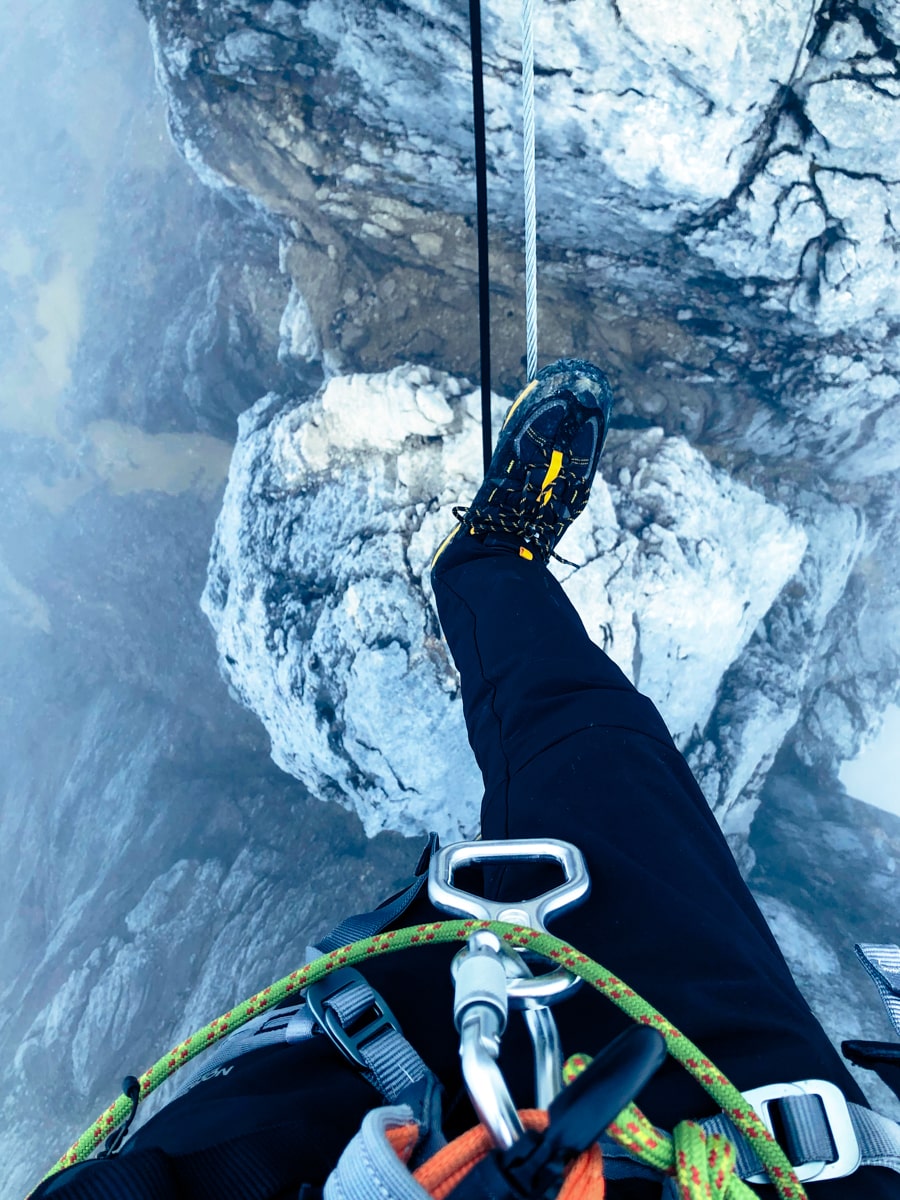
Usually, a trusted travel insurance company would be enough to cover your trip, but when you’re scaling the highest peak in Indonesia, this simply won’t do with most of them. With higher risks and the potential for danger, you’ll need an extreme sports insurance policy to have your back.
Although you will undoubtedly end up paying far more with this kind of policy, it’s better to be safe than sorry.
If you were to require hospital treatment, travel insurance may not pay out if it was the result of climbing Puncak Jaya. Whereas, an extreme sports insurance policy would – and being at the wrong end of a hefty Indonesian hospital bill is not where you want to be, especially when you’re likely to need helicopters off the island of Papua and to the more built-up mainland (which is relatively underdeveloped).
With such a hazardous climb in unpredictable circumstances already ahead of you, extreme sports insurance is essential when you’re planning on climbing Puncak Jaya, but your tour company takes care of that (and if they don’t, they are cowboys).
Climbing Puncak Jaya: My Experience of Summiting The Highest Peak in Australia
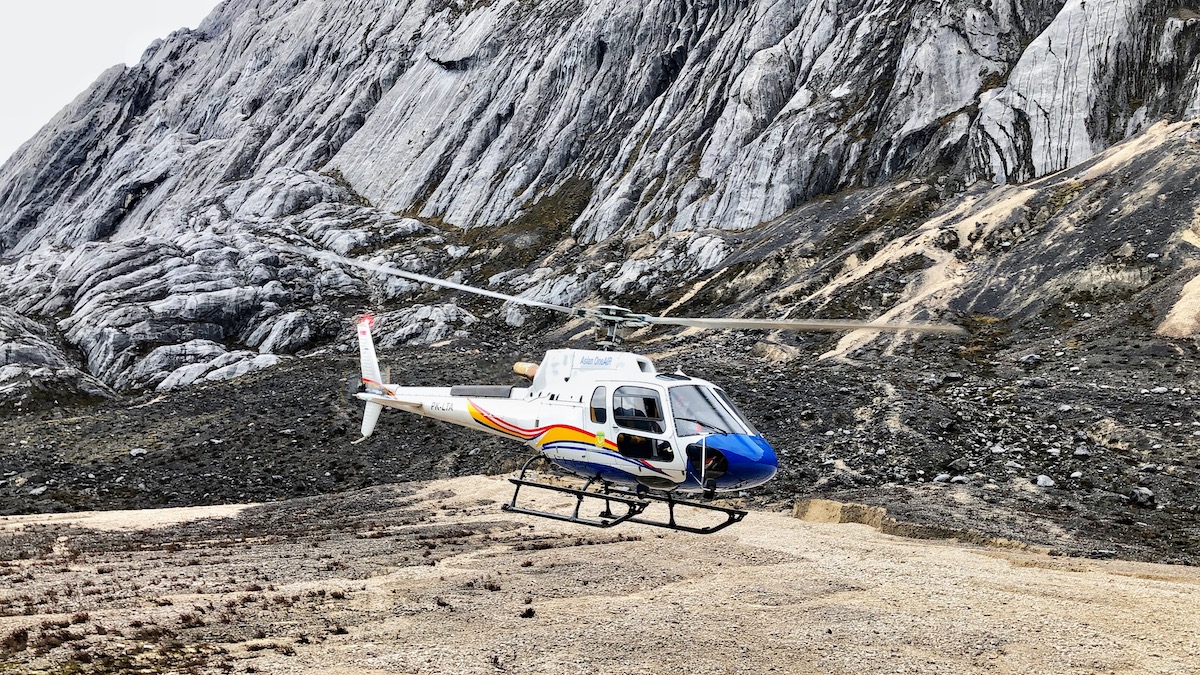
Johnny and I took a red-eye flight at 1:30 am from Bali to the region of the mountain Timika for $590, courtesy of Garuda Indonesia, speculating about whether the blonde lady on the flight was the Norwegian who we were set to climb Puncak Jaya with.
We confirmed with an introduction that she was indeed a member of our team as our hotel picked us up to go and meet the staff of Summit Carstenz.
Blessed with a much-needed positive, strong and fun energy, we knew she’d be the perfect company for the occasion, and she turned out to be an absolutely stellar woman (who only “failed” a Mount Everest summit due to her guide getting sick on the final day. Gut-wrenching!)
Later that afternoon, the guides visited our room to check our gear. After seriously upping my mountain experience recently, this was the first time I’d felt quietly confident with my equipment since the start of this hard mountain climbing journey on Mount Elbrus in Russia .
I felt that I’d come a long way from the novice who would tip his head like a curious Labrador when asked about important mountain gear, by an understandably flustered guide.
I passed my kit exam with maybe a B+ and agreed to get better shoes for climbing Puncak Jaya at a local store. Annoyingly, I had better shoes back home but forgot to pack them!
We were informed during the briefing that if the weather was clear in the morning we would be flying into base camp.
After breakfast the next day, we took our bags to the airport and waited for the 6-9 am window to open up and were happily greeted with the news that the helicopter had given us the green light at 8 am, to throw our bags on and get going.
My stomach jumped, “Operation; climbing Puncak Jaya” was officially underway.
It turned out that West Papua is home to the largest gold mine in the world, coining a cheek-puffing $15 million USD every DAY and we flew directly over it – a massive, striking crater sunk into the ground, that we flew over en route to base camp.
We really were in the middle of nowhere. The lack of safety and the logistical nightmare of getting to Puncak Jaya made it easy to see how it’s not just the high expedition price that keeps people away from this mysterious mountain.
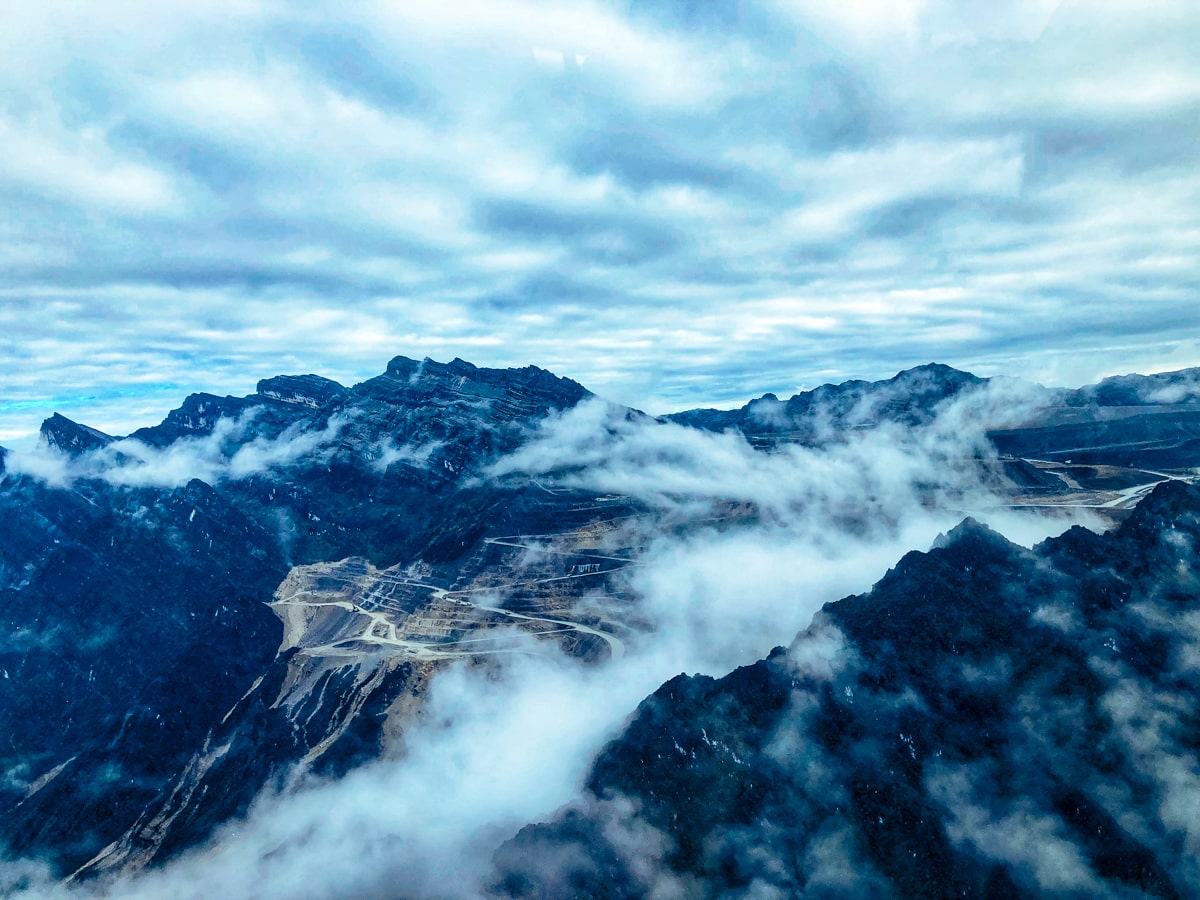
Upon touching down from our scenic helicopter ride we met our porter and guide. Just a few hours later, we were rope training – the very first time I’d used a jumar (a specialist rope-climbing tool) to drag myself up and over large rocks.
I did a double-take on the way back as our guide told us that we would be setting off to the summit in the middle of that very night , weather permitting.
Excitement and nerves kicked in even more. I’d have to learn a lot as I went along, but I was relieved to know that we would be going for it right away, and potentially cutting down our anxiety-laden waiting time on the mountain.
We got to bed around 7 pm and woke up at 2:15 am, with coffee and peanut butter sandwiches as our early, pre-climb breakfast.
Headlamps on, we marched in unison for our nighttime climbing Puncak Jaya expedition. The rain that had been hitting us hard upon arrival had disappeared, the conditions were favourable, and only human error was standing in the way of our success.
The uphill climb with ropes was every bit as saucy as I thought it would be, with jagged rocks biting into my hands as I grappled with them, trying to clamber over them.
Not the most graceful of techniques – think Bambi on ice… but on a mountain.

I was absolutely right when I was concerned that I’d be out of my depth here, but this was no time for trepidation – I simply had to focus, learn from any mistakes, trust in myself, and commit.
What helped was that there were only three of us (four including our guide) on the whole mountain, so there was no human traffic to worry about or bottlenecks to navigate through.
I actually learned more from our new Norwegian friend, Merethe (pronounced “Marieta” in English), than I did from him and I’m eternally grateful to Johnny for teaching me a figure-8 knot on the spot during a really difficult and terrifying part of the mountain, where the guide expected us to do a move that was tantamount to a Matrix fight scene over a large gap between two rocks.
Surprisingly, the infamous rope bridges didn’t test my nerves as much as the abseiling. I was even lucky enough to get a point-of-view shot from the other side as a nice memory – take a look for yourself…
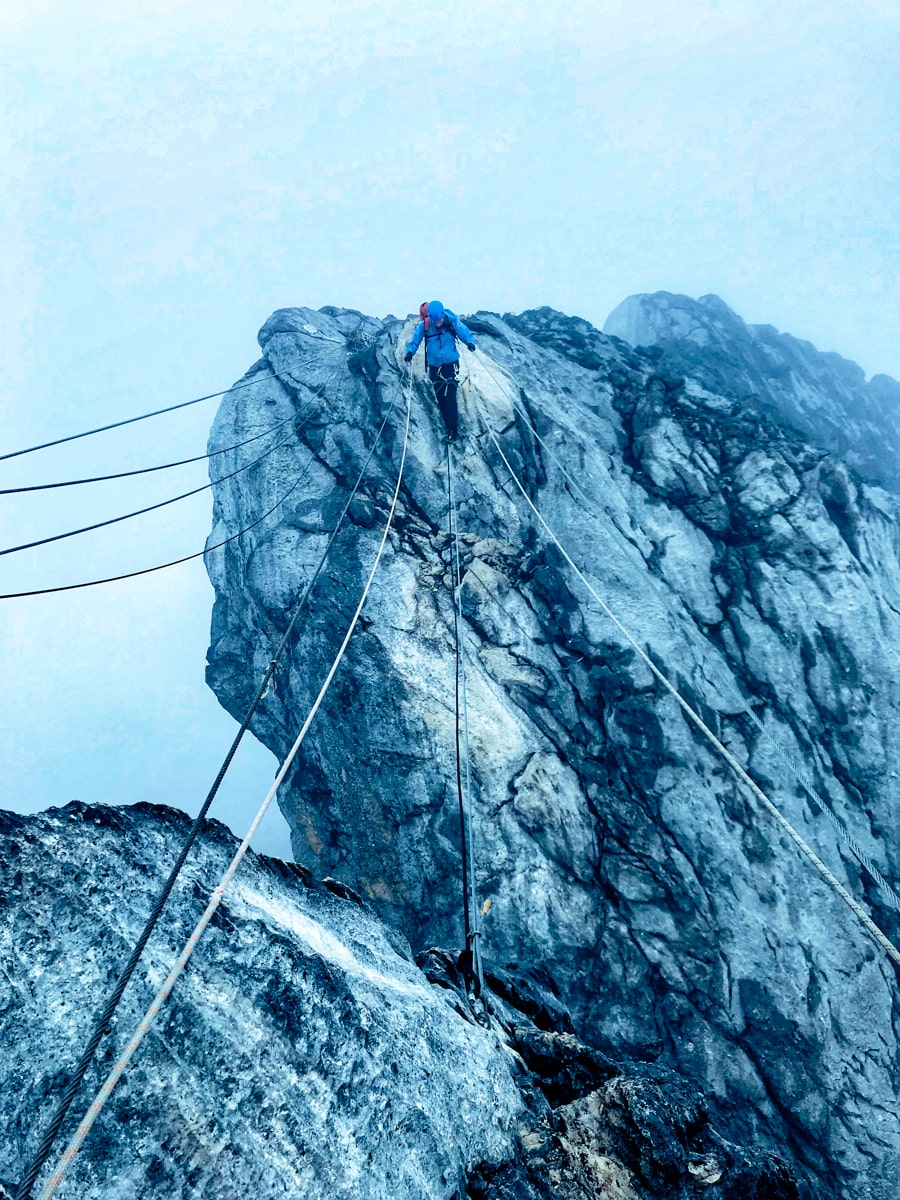
Five hours after stumbling, jumarin’, scrambling and climbing Puncak Jaya, we were standing proud on the summit, 4,884 metres high. The highest point of continental Australia and the region of Oceania – a beautiful feeling, especially after the 1st failed Aconcagua heartache the year before.
But reality suddenly hit and pragmatism killed my fleeting moments of romanticism. We still had to get back down, and if dragging myself up 90-degree angles was tough, going back down safely was sure as shit going to be no picnic.
I was about to lose my abseiling virginity and I was to do it coming down a Seven-frigging-Summit. Typical of me, trying to run before I can walk. I hoped that my luck wouldn’t run out.
Tiredness got to me somewhat, and momentary lapses of concentration could have been catastrophic as I lost control of myself during a dead drop abseil, but I managed to fight and claw myself to safety and regain my composure.
Mount Elbrus was the hardest physical thing that I’d ever done (I did it unfit and with a chest infection) and Marathon des Sables remains a close contest, but climbing Puncak Jaya was a different kind of difficulty, where I had to be successful in mind over matter and remain somewhat calm in order to get down safely.
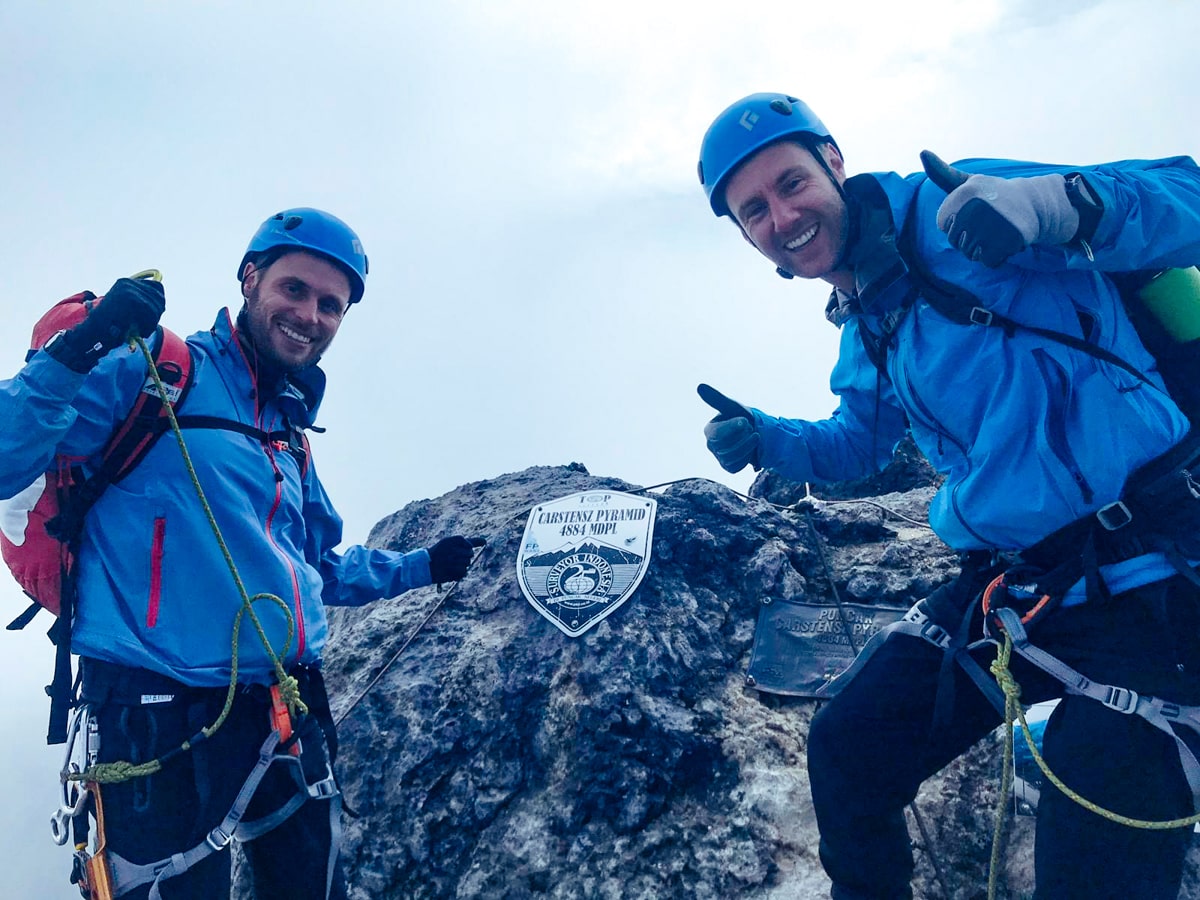
This was a different kind of mental challenge on a mountain and a refreshing (yet frightening) one for me. It was less about slogging through mental pain with physical endurance and more about problem-solving, staying in the “flow” zone and not panicking in terrifying moments.
I felt extremely vulnerable up there, but the experience of respecting the mountain was really good for me and will serve me well for future climbs.
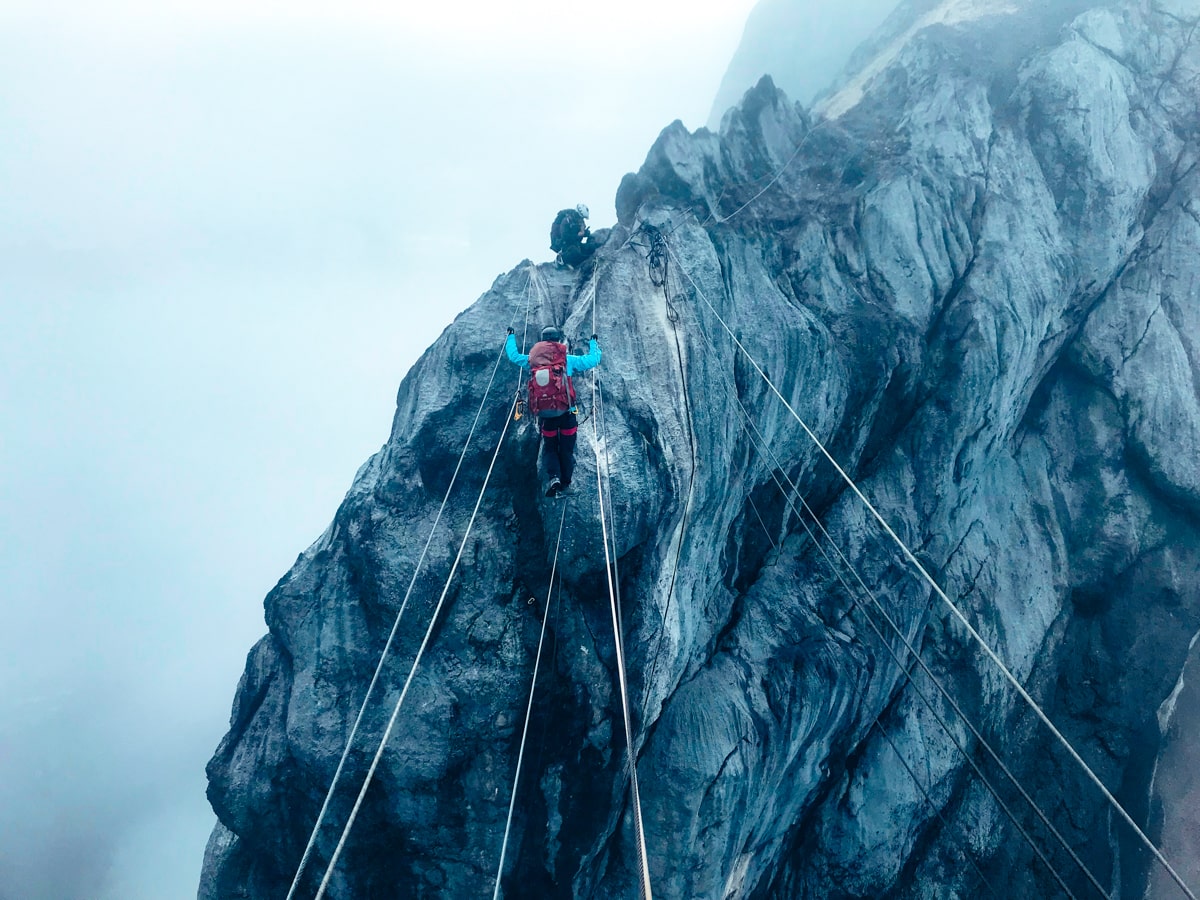
A couple of slips and 7 hours later we were back at base camp, my confidence growing after the humble sandwich force-fed to me by the mountain.
After successfully climbing Puncak Jaya, we headed to Australia to climb Kozzie , so we could say that we had 100% climbed the tallest mountain in the whole of Australia with absolutely no contention.
Before you head to West Papua:
- If you’re into climbing mountains in Asia then also check out these Climbing Mount Kinabalu Tips , everything you need to know about toppling the tallest mountain in Borneo. Good luck with your climbs
- Adventurous man? This post is for you: Best Men’s Travel Gear: Tried & Tested Over 10 Years!
Anthony Middleton
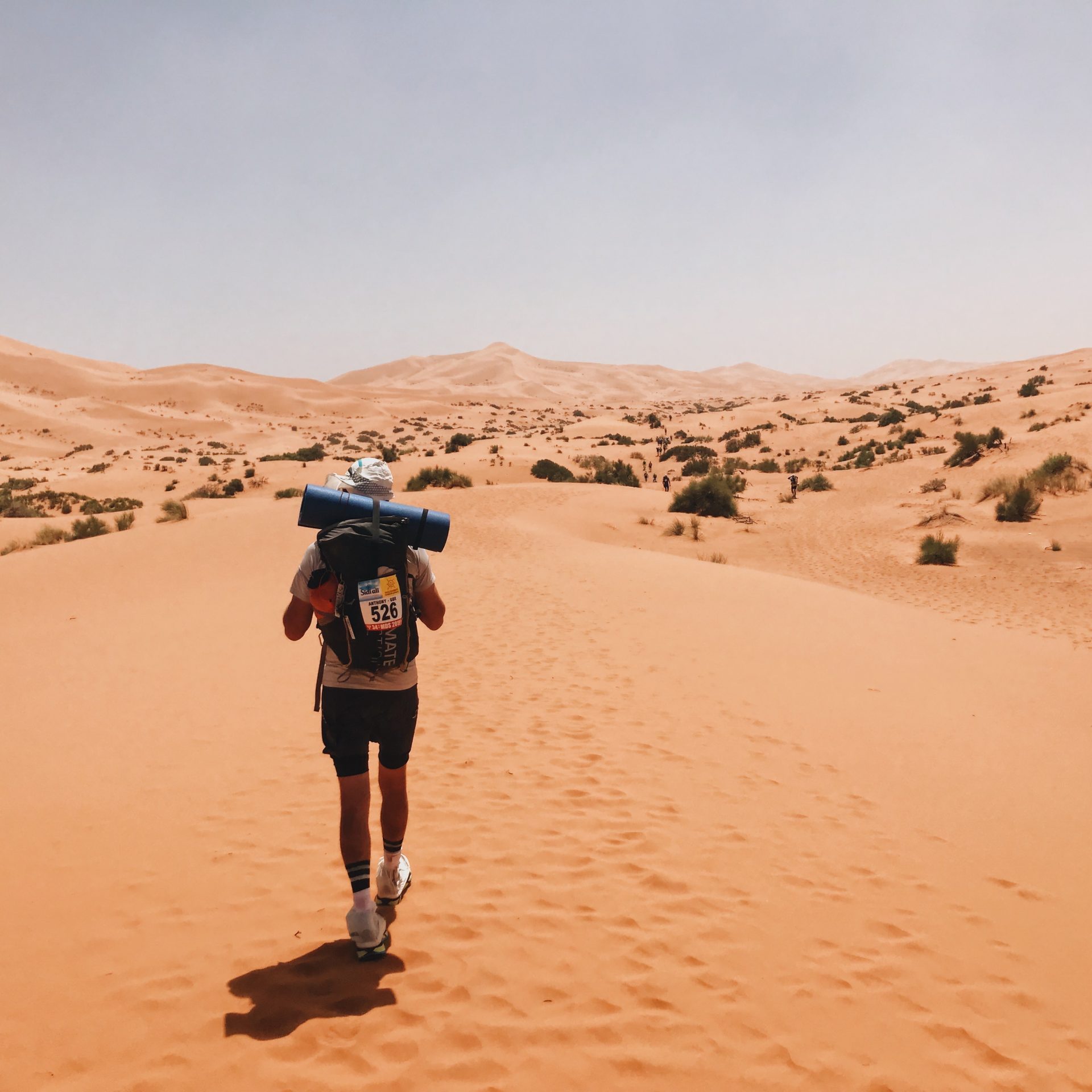
Hi, I'm Anthony!
In November of 2010, I took on a mammoth challenge against the clock in a quest to upgrade my miserable life. I went out of my comfort zone and turned it all around. Ten years later, I’m completely location independent…

Read All About Challenges, Indonesia, and Southeast Asia
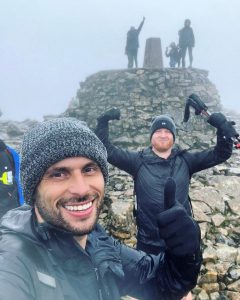
Hiking The UK National 3 Peaks in 24 Hours: An Honest Guide
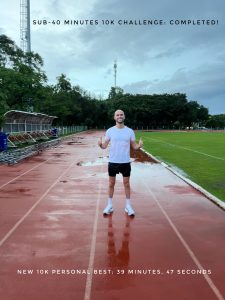
How I Became a Sub-40 Minute 10K Runner in 6 Months (After 10 Efforts)
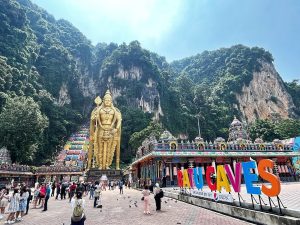
How Many Days Should You Spend in Kuala Lumpur?

- BOOK YOUR NEXT TRIP
- 206.378.1927
- GEAR SHOP ACCOUNT

Carstensz Pyramid
(16,023ft/4,884m) western papua.
- The Mountain
Reading List
Climb carstensz pyramid with alpine ascents - heli in & heli out.
Fantastic expedition. Everything one might ask for from hair-raising flights to jungle bushwhacking to cliff hanging. Full-on adventure. Excellent guides. And an unforgettable experience.
As one of the first outfitters to lead trips to Carstensz Pyramid (1994), we are excited to now offer a fly-in and fly-out itinerary for our Carstensz expeditions. Each season we adjust our trip to current circumstances, working closely with local outfitters to use transport and local support in the best combination. Our most recent seasons have experienced 100% summit success, with Paul Koubek leading, and we have had a 98% success rate since our initial 1994 climb. We look forward to Paul leading our fall 2022 climb.
Why helicopter travel? We choose to use helicopters for our current expeditions because we see this as the best chance to provide a successful expedition while meeting the logistical challenges of traveling in West Papua. Trips that trek into basecamp bear much reliance on local Dani Tribesman, and helicopter transport in general reduces the number of variables in reaching our destination. Additionally, local politics, staying healthy while trekking, and the extremely limited ability to provide emergency assistance on the trek makes helicopter use the best option.
Climb Carstensz Pyramid Pricing
Climb carstensz pyramid schedule.
No Upcoming Departures. Check again soon.
Climbing Skill Level
Climbers should possess basic rock climbing skills and a course like our 5-Day Cascades Rock Climbing Course or equivalent is recommended.
About Carstensz
If we attempt to define exotic, then we may begin with West Papua (formerly Irian Jaya). In the lush jungles of the Beliem Valley, we meet the Dani tribesmen, our guides, who were first introduced to westerners in the 1960’s. This is perhaps the most interesting climb Alpine Ascents offers, weaving a deeply influential cultural experience with a challenging rock climb. All climbs are led by an Alpine Ascents guide.
Located in the western central highlands, Carstensz Pyramid is the highest mountain on the Oceanic continent. We arrive by charter flight, then take a helicopter to Base Camp. After rest and arrival, we will attempt to summit Carstensz Pyramid (Puncak Jaya). Following the climb, we return via helicopter to a local village for further transport out. Regionally, West Papua has had relatively little western influence, the ancient Dani lifestyle and rituals have been able to continue in an authentic manner. Tourism has not arrived in many of these areas, and thus we are extremely sensitive and careful about our impact on the region.
Unlike the other Seven Summits, Carstensz is a rock climb of moderate difficulty. While all short technical sections will have fixed lines, climbers should have basic rock climbing skills. Our past expeditions proved to be fantastic all-around experiences and each climb culminated with nearly 100% summit success (45 out of 46 climbers)! See the Cybercast of our last climb to Carstensz for more.
About The Climb
At 16,023 ft. (4,884 m), Carstensz Pyramid (Puncak Jaya in Indonesian, meaning “Victory Peak”) is located in the western central highlands of West Papua and is the highest peak in Oceania, the Australiasia continent. The English name for the mountain was after Jan Carstensz, a Dutch explorer who was the first European to sight the peak. In 1962, Heinrich Harrer became the first foreigner to summit the peak. His book, “I Come From the Stone Age,” provides excellent reading about climbing Carstensz and other peaks in the area, as well as his experiences of living with the Dani.
The route on Carstensz Pyramid follows a series of gullies up the north face for 500 meters of solid rock before breaking out on the ridge. Riddled with notches, the summit ridge undulates for half a kilometer from this point to the top. One of the gaps is 20m deep, and we rappel this overhanging pitch, then leave a rope fixed to jumar on our return. On our descent, we rappel short distances and down-climb most of the way. The rock is extremely good, rarely loose, and provides good friction even in wet weather.
The rock-climbing difficulty on Carstensz is up to 5.8 for short steps, but most of the climbing is scrambling. It is important that you have basic rock-climbing skills and are comfortable with rappelling and jumaring. Short technical sections have fixed lines allowing you to either free climb or jumar. These fixed lines have been a crucial part of our 100% success rate.
In the highland areas, daytime temperatures should range between 75 and 85 degrees F, with most evenings about 45 degrees F. Expect warm afternoon showers, which may turn cool if encountered on a mountain pass. Closer to Carstensz, snow or inclement weather may occur. Temperatures can range from 28° to 60° F with sunshine occasionally in the mornings, then rainfall in the afternoons and evenings. Winds are variable and can be strong.
A Brief History of Papua
West Papua occupies the western half of New Guinea. This island is located immediately south of the equator, and is the world’s second largest island, following Greenland. West Papua provides a panoply of old world tropical species. This is due to the land bridge linking Australia and New Guinea during the last ice age. West Papua’s climate is primarily a function of topography. The low-lying north and south sides of the island possess great tropical jungles, while the mountain ranges exhibit temperate conditions. The mountains run east to west and rise to 16,023 ft. (4,884 m) at Carstensz Pyramid.
Politically, West Papua is the easternmost province of Indonesia. The area was initially claimed by the Dutch in the mid-1800s as part of their Spice Island empire, but by 1940 they had still not explored further inland than the coastal plains. The Dutch wanted to prepare Irian Jaya for self-government by 1970, but from the late 1950s, Indonesia was exerting pressure to annex the area and, with help from the United Nations, this was accomplished in 1963. This process was not universally accepted by native Papuans and discontent still prevails in certain areas. In 1961, the Harvard Peabody Museum sponsored a major expedition to the Grand A Valley to document the Dani’s Stone Age culture (see Peter Matthiessen’s “Under the Mountain Wall”). Wamena, the site of the valley’s airstrip, has grown into a small town, but in general the only big changes since then are that tribal fighting and cannibalism have ended. The province was renamed Irian Jaya, “Victorious Irian” in 1973. The indigenous movement has since identified themselves as West Papuan.
Beyond the Grand Valley of the Baliem River, many other groups live in smaller valleys. These people were not contacted by the west until the 1960’s and 1970’s, when missionaries began penetrating these regions. In the highlands to the east of the Baliem River, the Yali, Mek, and Kim-Yal people comprise some of the other large tribal groups.
This is a highly recommended shortlist and we would be happy to pass on a longer reading list for those interested. These links will bounce to Amazon.com with reviews.
Under the Mountain Wall: A Chronicle of Two Seasons in Stone Age New Guinea

Indonesian New Guinea: West Papua/Irian Jaya

Carstensz was absolutely other-worldly, a step back in time with barefoot porters and crazy muddy wet jungle trails. The mountain itself was FUN! Thanks, it was a very memorable trip.

ALPINE ASCENTS BLOG

Cascades Conditions Report 9/18/24
Greetings fellow climbers, Autumn is in full swing with cool nights in the mountains and a mixture of sunny and rainy days keeping us on our toes. Our summer climbing operations here in the PNW are slowly winding down for the summer climbing season. On Mount Rainier (Tahoma), our final trip of 2024 summited on […]
Cascades Conditions Report 9/11/2024
Greetings fellow climbers! Fall is in the air with a mixture of cooler temperatures and mountain snow. Over the past week our guides have reported new snow up high on the peaks of Mt Baker, Shuksan, and Mt Rainier. The long term forecast shows a cooler and more typically Cascade weather pattern with a mixture […]

Cascades Conditions Report 9/4/2024
Greetings climbers, Schools are starting up again and the mountains are quieting down as we approach the end of the busy season of Cascades climbing. We kicked off our final 6 Day course on Baker earlier this week, and we have teams of climbers spread across the state from Rainier, to Vesper Peak, to Shuksan, […]
WHY BOOK WITH ALPINE ASCENTS
Knowledge & expertise.
Alpine Ascents International leads expeditions that have become benchmarks of quality in the climbing community. We operate what we believe is the finest mountaineering school in the country. This expertise is based upon years of accumulated experience-not just from individual mountain guides, but through experience on particular mountains where details are fine-tuned over time.
Our guides are an integral part of Alpine Ascents because they understand and share our climbing principles. These individuals are dedicated to sharing their excellence with others. Many of our guides have been with Alpine Ascents for over five years, with a handful of veterans working with us for most of their careers. The quality of our Guide Staff is the primary difference between us and our competitors.
Environmental Reponsibility
Leave No Trace principles are fundamental to our program, and we encourage all who climb and trek with us to understand proper wilderness practices. We help facilitate this effort by passing on Leave No Trace training and literature to every Alpine Ascents climber.
Partners & Accreditations


Carstensz Pyramid
At 16,024 feet, Carstensz Pyramid is the highest point in Indonesia and the highest mountain in Oceania. Locally known as Puncak Jaya, it is a dramatic pinnacle rising from the sheer, serrated ridgeline of the Sundirman Range on the lush island of New Guinea. While it is not the highest or most strenuous of the Seven Summits, it is often considered to be the most technically challenging.
The name “Carstensz Pyramid” comes from Dutch explorer Jan Carstenszoon, who spotted the mountain in 1623. The peak was first climbed in 1962 by an expedition spearheaded by the famous Austrian mountaineer Heinrich Harrer, who was also part of the first ascent party on the North Face of the Eiger and wrote the classic book, Seven Years in Tibet. Today, climbers on Carstensz Pyramid enjoy moderate, technical rock climbing on the peak’s textured white limestone, and then reach the summit after a dramatic Tyrolean traverse. Most climbers take advantage of their time in Indonesia to explore the country’s rich biodiversity and relax in the resorts of Bali after the climb.
Talk to an ADVENTURE expert 425.749.7421
Carstensz pyramid • north face • 11 days.
Our expedition begins in the quaint city of Timika on the south coast of Papua, Indonesia. We spend a day getting oriented and organizing our gear, then we take a spectacular helicopter flight over the rainforest to our base camp in the Yellow Valley in the heart of the Sundirman Range. After acclimatizing, we climb the classic North Face Route, which follows a network of cracks and gulleys to the mountain’s exposed summit ridge. The route is rated roughly 5.6, and requires some rock climbing experience. Cables and a Tyrolean traverse lead to the summit. We celebrate our success, then rappel back to base camp.
Climb Highlights
- Climb the highest peak in Oceania
- Explore Indonesia
- Scenic roundtrip helicopter flights to the mountain
- Welcome Dinner
- 3 hotel nights in Timika
- Enjoyable limestone rock climbing
- Famous Tyrolean traverse
- A spectacular Seven Summits ascent
- Friendly MG office staff will help you prepare for your adventure
Day to Day Itinerary
Day 1 • Meet in Timika Day 2 • Rest Day Day 3 • Flight to Yellow Valley • 13,700 ft Day 4 • Acclimatization day Day 5 • Acclimatization day Day 6 • Puncak Jaya • 16,024 ft Day 7 • Flight to Timika Day 8 • Flight to Bali Day 9 • Extra Day Day 10 • Extra Day Day 11 • Depart Bali
Expedition begins and ends in Timika, Indonesia
Day 1 • Meet in Timika
Meet in Timika, West Papua, Indonesia and relax after a long day of travel.
Accommodations: Hotel in Timika
Day 2 • Rest Day
We allot an extra day to recover from jet lag while we organize our gear, hold a team orientation, and wait for any baggage that may have been waylaid. We enjoy a team welcome dinner then go to bed early.
Accommodations: Hotel in Timika Meals Included: Breakfast, Dinner (B, D)
Day 3 • Yellow Valley Basecamp • 13,700 feet
If the weather is clear after breakfast, we transfer to the airport and take a scenic, 45-minute helicopter ride over the rainforest to our base camp in the Yellow Valley, at an elevation of 13,700 feet. We set up camp and relax while we begin to acclimatize from our journey from sea level.
Accommodations: Tented Camp Meals Included: Breakfast, Lunch, Dinner (B, L, D)
Day 4 • Acclimatization Day • 13,700 feet
Today is an active rest day while we acclimatize. To help our bodies adapt to the altitude, we take a short hike around base camp.
Day 5 • Acclimatization Day • 13,700 feet
After breakfast climbers will once again trek around basecamp in order to get their bodies used to the elevation. Since the following day is our first potential summit day we will spend most of the day training, discussing the climb, and packing for the climb before heading to bed early.
Day 6 • Summit Day • Puncak Jaya • 16,024 feet
We begin our summit bid early in the morning. Moderate, technical rock climbing takes us up the featured limestone of the North Face Route. On the summit ridge, we enjoy a mix of rock climbing, via ferrata, and a Tyrolean traverse en route to the top of Oceania.
Vertical Ascent Climbing: 2,324 feet Climbing Time: 7-10 hours
Day 7 • Flight to Timika
We will take a helicopter from the Yellow Valley Basecamp back down to sea level in Timika. After checking into our hotel we will have a celebratory dinner before departing the next day.
Day 8 • Flight from Timika to Bali
Weather permitting, we begin our flights home, generally through either Bali or Jakarta.
Day 9 – 11 • Contingency Days
Additional days are allotted for weather and other delays, which may alter our flights and climbing schedule. These are not optional days. The weather in the Sundirman Range is notoriously unpredictable. We will try our best to follow our itinerary, but this is true adventure travel and we recommend that you arrive with an attitude, and a flight schedule, that allow delays beyond our 11-day itinerary.
Itinerary Notes Mountain Gurus makes every effort to uphold the scheduled itinerary, although our guides are given discretion to adapt the itinerary for reasons beyond our control or due to the needs of the group. Meal schedule: (B) Breakfast (L) Lunch (D) Dinner

Head and Face
- Warm Hat: Wool or synthetic. Must covers the ears.
- Sun Hat or Baseball Cap
- Sunglasses: Essential eye protection at altitude. Two pair (one spare).
- Balaclava or Face Mask: Must cover all exposed skin.
- Buffs: Two (2) buffs for sun and wind protection
- Sunscreen: SPF 30+
- Lip Balm: SPF 30+
- Climbing LED Headlamp: Bring extra batteries.
- Baselayer Tops: Two (2) synthetic, long-sleeve tops. One lightweight, one medium.
- Mid-layer Top: This is a synthetic or fleece top.
- Softshell Jacket: A breathable but wind-and-weather-resistant jacket. Hoods are highly recommended.
- Hardshell Jacket: GORE-TEX© or a fully waterproof shell. Hoods are highly recommended.
- Insulated Jacket: 700+ fill down. Hoods are highly recommended.
- Rain Poncho: A large, durable rain poncho
- Umbrella: Very effective for rain protection
- Lightweight Gloves: One pair (WINDSTOPPER© is recommended)
- Softshell Gloves: One pair. Leather palms offer durability and grip.
- Leather climbing gloves: One pair for protection from sharp limestone.
- Heavyweight Gloves: Insulated glove or mitten with GORE-TEX or waterproof outer.
- Heavyweight Mittens: Warm mittens with GORE-TEX or waterproof outer.
- Baselayer Bottom: One pair medium weight long underwear. Synthetic, no cotton.
- Climbing Pants: One pair, medium weight. Synthetic, stretchy, non-insulated.
- Trekking Shorts: Synthetic, no cotton
- Hardshell Pants: One pair of GORE-TEX© pants. Full-length side zips are required; you may need to take off your hardshell pants without removing your boots.
- Insulated Pants: One pair that fits loosely and comfortably.
- Trekking Socks: Six pair synthetic medium weight
- Hiking Boots or Trekking Shoes: One pair medium weight hiking boots/shoes large enough to be comfortable with your hiking socks.
- Climbing Boots: Partial shank, synthetic or leather climbing boots, with some flex to be nimble enough for rock climbing. Carstensz receives wet weather. Your boots should be waterproof.
- Sport Sandals or Camp Shoes: For use around camp or in lodges.
- Rubber Boots: For hiking around camp in the rain
- Gaiters: Heavy duty. Must fit over your boots.
- Sleeping Bag: Bring a warm bag rated to -10ᵒ Fahrenheit.
- Sleeping Pads: One full-length closed-cell foam pad and one full-length inflatable pad.
Packing and Backpack
- Backpack: One 30-liter backpack with good support, adequate to carry your personal gear on summit day.
- Duffel Bags: Two (2) large, rugged, waterproof PVC duffel bags for transporting gear.
- Liner Bags: Five (5) large plastic contractor bags.
- Compression Sacks: A variety of stuff sacks and compression sacks for packing gear.
Climbing Gear
- Climbing Helmet: Lightweight
- Alpine Harness : Lightweight alpine harness with adjustable leg loops.
- Locking Carabiners: (3) Large pear-shaped, screw gate locking carabiners.
- Non-locking Carabiners: (2) Wire gate non-locking carabiners.
- Ascender: Left or right handed
- Rappel/Delay device: Figure 8 recommended
- Prussik Cord: 30 feet, 7mm perlon
- Nylon Sling: (3) 120cm nylon slings
- Crampons: 12-point steel with anti-balling plates (for use in case of snow)
- Trekking Poles
- Ice Axe: 55-75cm mountaineering axe
- Water Bottle: Two, 1L wide-mouth plastic bottles. NALGENE©
- Water Bottle Parkas: Two, fully insulated water bottle covers.
Personal Health and First Aid
- Snacks and drinks
- Plastic bowl, insulated mug, and spoon
- Personal toiletries.
- Water treatment (iodine tabs, chlorine tabs, SteriPen or filter kit)
- Small personal first-aid kit and medications
- Drugs for altitude (consult your doctor)
- Toilet paper
- Blue bags or wag bags
- Hand sanitizer
- Book and/or Kindle
- Baby wipes for “washing” on the mountain
- Pee bottle, or pee funnel for women
- Hand warmers (optional)
Program Location: Begins and ends in Timika, Indonesia
Visa/Entry Information: A passport and visa are required. American citizens will be issued a tourist visa upon arrival valid for 30 days.
Health & Immunizations: Check with the CDC for updated immunization information.
Flight Travel Information: Ngurah Rai International Airport (DPS), Bali, Indonesia Mozes Kilangin International Airport (TIM), Timika, Indonesia
International Departures: Itineraries reflect the date and time you will need to arrive in country for a program. Mountain Gurus programs begin and end in-country in the destination city. When booking your flight, you will need to account for travel time and crossing the international dateline if needed. It is easiest to give your booking agent the day and time you will need to arrive.
Meals and Food: All meals are provided as per meal schedule. See itinerary.
Gear: A complete clothing and equipment list specific to your program will be sent to you in the pre-departure packet upon reservation. For your safety and comfort, it is extremely important that you adhere strictly to the equipment list.
Carstensz Pyramid Fitness & Training
Climbing Grade: Intermediate
Although we don’t climb with heavy packs on Carstensz Pyramid, this is a technical rock climb at moderately high altitude with some steep and exposed sections. All climbers should have solid technical rock climbing experience and excellent physical fitness. To safely complete the climb, you should be prepared to climb fixed lines, sections of rock and Tyrolean traverses, and then descend via a series of rappels, all while wearing a roughly 20-pound pack.
If you don’t already possess strong rock or ice climbing skills, we recommend that you take our private Carstensz Pyramid Prep Course. We would be glad to teach you the skills you need to climb the highest mountain in Oceania!
Here’s a suggested progression of climbs before attempting Carstensz Pyramid:
- Carstensz Pyramid Prep Course
- Rock or alpine climbing experience
- Northwest Climb (Mount Shuksan, Sahale Peak, Forbidden Peak)
Things you should know about this trip
How hard is this climb and what technical skills do i need.
The classic North Face Route consists of moderate limestone rock climbing up to about 5.6 in difficulty, at moderately high altitudes. You should have some rock climbing experience, plus rappelling, fixed line, and via ferrata skills. Ice axe, crampon and self-arrest skills may be helpful but are not required. If you want to join this expedition, but lack these skills, please let us know. We would be happy to help you prepare prior to the trip!
Why do we take helicopters to base camp?
The overland route between Timika and Yellow Valley Base Camp is long, wet and strenuous. Flying allows us to focus on the climb, and ensures that we arrive in base camp feeling fit and fresh. What’s more, the helicopter flight is spectacular. For many climbers, flying over the rainforest and into the heart of the Sundirman Range is one of the most memorable experiences of the trip.
Will I have time to explore other parts of Indonesia?
Our expedition begins and ends in Timika. However, most of our climbers schedule extra days to explore more of Indonesia. Most flights go through the world-famous island resort of Bali, and many of our team members relax there with friends or loved ones after the climb.
How much weight will be in my pack on summit day?
Our summit packs will weigh about 20 pounds. We’ll carry warm clothing layers, food, water, and personal climbing gear.
What are the camps like?
On Carstensz Pyramid we use only one camp: our Yellow Valley Base Camp. We provide high quality facilities, including a dining tent with table and chairs, private toilet, and top-quality mountaineering tents for climbers. Tents are double occupancy.
What if the weather interferes with our itinerary?
The weather around Carstensz Pyramid can be wet and unpredictable. We have a very high success rate on the mountain, and we achieve that by adapting our climbing schedule and helicopter flights around the weather. Our 11-day itinerary includes contingency days, but we recommend that team members leave some leeway in their schedules for potential additional delays. Climbing in West Papua is true adventure travel! To make the most of your trip, you should arrive in Indonesia with a flexible and positive mindset.
Will I be able to contact friends and family during the expedition?
In Timika, there is limited cellular and WiFi service. Base camp is remote, with no cellular or internet service. We will bring a satellite phone for emergency use.
Is it safe to travel to West Papua?
The area around Carstenz Pyramid is generally safe as long as we follow common sense travel protocols. We will review safe travel practices at our gear check and ensure that local staff and guides are always available to answer questions. By traveling in a group we mitigate risks.
Need help choosing a trip?
Read our Four-Legged Stool blog post for tips on finding the right adventure for you.
Previous Post Denali
Next post ama dablam.
Comments are closed.
425.749.7421 Email Us
Office Hours 9am-5pm PT / Mon-Fri
305 F And S Grade Road Sedro Woolley, WA 98284

GEAR PARTNERS

- FIND A TRIP
- Walking & Hiking
- Hiking & Trekking
- Mountaineering
- Multi-Adventure

- BOOK A TRIP
- Why Mountain Gurus
- Join Newsletter
© 2024 Mountain Gurus.
- Mount Baker Intro
- Island Peak
- Ecuador Mountaineering
- View All Mountaineering »
- Everest Base Camp
- Mount Kilimanjaro
- Annapurna Base Camp
- Morocco High Atlas
- Bhutan Jomolhari
- View All Hiking & Trekking »
- Japan, Walking Tour
- Nepal, Annapurna Walking
- Everest Lodge-to-Lodge Trek
- View All Walking & Hiking »
- Tanzania, Ngorongoro Safari
- Tanzania, Serengeti Safari
- View All Safari »
- Northern Thailand, Hiking Tour
- Ecuador, Highlands Trek
- Morocco, Bike Tour
- Nepal, Mustang Overland
- View All Multi-Adventure »
- FIND A TRIP »
- INSPIRATION
- Trip Leaders
- Office Staff
- Book A Trip
- Frequently Asked Questions
- 0 Shopping Cart ₹ 0.00 -->

CARSTENSZ PYRAMID
4884 meters | indonesia, 9 november 2023.

Carstensz Pyramid, also known as Puncak Jaya, is the highest peak in Oceania, and one of the Seven Summits. Located in the Indonesian province of Papua, this challenging peak stands at an elevation of 4,884 meters (16,024 feet) and is a popular destination for experienced mountaineers and adventurers. It is also the highest point between the Himalayas and the Andes. The climb to Carstensz Pyramid is not for beginners, as it involves a combination of trekking, climbing, and technical skills such as rock climbing and rappelling. The route to the summit is demanding, with steep ridges, sharp limestone rocks, and dense jungle terrain, which is very challenging to navigate through.
It is recommended that climbers have experience with technical mountaineering skills and high-altitude climbing. However, for those who are up for the challenge, it is an unforgettable adventure that will leave a lasting impression on both mind and soul. Despite the challenges, the reward of reaching the summit of Carstensz Pyramid is incredible. Climbers are treated to stunning panoramic views of the surrounding jungle, as well as the nearby peaks of the Sudirman Range. The sense of accomplishment and adventure that comes with climbing one of the Seven Summits is truly unparalleled.
Day 1: ARRIVAL IN BALI Land in Bali and drive to your hotel. Have some rest for a while. Intro and final preparation before dinner. Our flight to Timika will be at midnight.
Day 2: ARRIVAL IN TIMIKA Arrival at Timika Airport. Transfer you to your hotel. Have some rest before lunch. Later, you can enjoy your free time the whole day to refresh your energy and get your body used to the altitude. Overnight at Hotel.
Day 3: TIMIKA – CARSTENSZ PYRAMID BC Drive from Hotel to Airport and take a flight with chartered helicopter to the Yellow Valley Base Camp (4,300m). Free time while you’re acclimatizing yourself in the base camp.
Day 4: ACCLIMATIZATION Free time the whole day and get an extra day for acclimatization. Walk around base camp, going up to the middle ridge and back. After that, we’ll do some training on the rope. Overnight at the base camp.
Day 5: SUMMIT PUSH Wake up at midnight and prepare for the summit attempt. Start trekking to the summit at 02:00 am. After walking for about 30 minutes, we will break out on the summit ridge where lines will be fixed in preparation for our descent. Our route here follows the ridge crest with grand exposure along the way. We pass four small notches as we rappel and use ascenders to negotiate these tricky sections. Our descent entails multiple rappels and scrambling. We will be on a good, clean rock that provides excellent friction even in wet weather. It will take approximately 9-10 hours round trip
Day 6: BASE CAMP – TIMIKA A helicopter picks up from Yellow Valley Base camp to Timika. Transfer to your hotel in Timika.
Day 7-8: RESERVE SUMMIT DAY In case of bad weather, extra acclimatization on or helicopter flight delays. Note: Sometimes we need more than two days. Depend on the real-time situation/Weather conditions)
Day 9: TIMIKA – BALI Check out of the hotel and take a flight to Bali at 11. 30 AM. Arrival in Bali at 14. 30 PM. Drive you to the hotel. Farewell dinner ready at 18.00 Pm.
Day 10: DEPARTURE Have breakfast. Check out of the hotel and drive to Airport. Fly back.
- Pick up and drop service from airports.
- Domestic flights from Bali-Timika-Bali.
- A round trip-chartered helicopter from Timika to the Yellow Valley BaseCamp.
- Two nights Hotel in Bali (one night before & one night after treks/climb).
- Two nights Hotel stay in Timika (one night before & one night after treks/climb).
- All meals during your climbing.
- RTB fee (return to base).
- Tents, dining tents, tables, chairs, and cooking utensils.
- Experienced Climbing Guide and field assistant.
- Fixed rope on Carstensz Pyramid wall.
- Luggage not more than 15kgs/person for Helicopter.
- All complicated permits for climbing Carstensz Pyramid.
- Satellite phone service is only for emergency situations.
- Radio communication support in the base camp.
- Participants will get an exclusive 15% discount on all Fast&Up products.
- International flight to Bali.
- Personal equipment for climbing and camping.
- Personal insurance & cost for emergency evacuation.
- Personal excess baggage on domestic flights (luggage allowance is usually 20kgs/person).
- Personal expenses (laundry, phone call, mini bar in the hotel).
- Your meals in Timika.
- Costs for delays or extending a trip due to bad weather or other circumstances.
- Costs associated with you leaving an expedition early.
- Costs associated with an expedition finishing early.
- Tips for guide and field assistants.
PREPARATION GUIDE
- Have Previous High altitude Trekking/Mountaineering Experience.
- Weight train the body. Walk uphill or stairs steps with a weighted back pack.
- Strength training for the lower body and core. Do planks, crunches and cycling.
- Climbing UT Kangri requires a fit body and a conscious mind. One needs to be exercising regularly for the past couple of months.
- Any high altitude trek requires you to build a good amount of cardiovascular endurance. Jogging is the best exercise to increase your stamina.
- You need strong legs to success fully finish a high altitude trek. Squats are the best way to build leg strength quickly. Especially your thighs, glutes and knees.
- For detailed advice and coordination, we’ll have a WhatsApp group.
YOU MAY ALSO LIKE
EBC Three Passes

Patalsu Peak

Annapurna Base Camp

Gurez (Patalwan)

SHARE THIS PLAN
Boots & Crampons, registered with the Ministry of Tourism, specializes in providing premium-quality & safe mountaineering experiences around the world. We are committed to protecting & conserving the natural environment in which we operate . Our highly experienced support team & certified guides make for a hassle-free journey throughout.
Important Links
Book a Trek/Expedition Gift A Trek Terms & Conditions Cancellation Policy Sitemap Privacy Policy
Get In Touch
+91 9000 603 444

Puncak Jaya (Carstensz Pyramid)
Puncak jaya (carstensz pyramid): southeast asia's mount everest, summary puncak jaya (carstensz pyramid) indonesia - summary.
Puncak Jaya (Carstensz Pyramid) is Southeast Asia’s Mount Everest
Carstenz Pyramid (Puncak Jaya) is one of the “7 Summits” – the highest points on each continent – it being assigned to Australasia rather than Asia. It is the highest mountain between the Himalayas and the Andes.
First conquered in 1962 by an expedition led by Henrich Harrer (who famously spent 7 years in Tibet and climbed the North Face of Elger). He was joined by a geologist Jean Jaques Dozy who spotted an oddly dark and green-tinged peak that turned out to be the richest gold and copper deposit ever found.
Climbing Puncak Jaya (Carstensz Pyramid) Indonesia - Height and Distance
Natural puncak jaya (carstensz pyramid) indonesia - natural height.
4,884 m (16,024 ft)
Natural Puncak Jaya (Carstensz Pyramid) Indonesia - Hiking Period
The climb to the top of Indonesia’s Carstensz Pyramid will take around a week, depending on where you plan on starting the trek.
There are two options to get to ascend the summit. The first is to reach the base camp by helicopter and climb to the summit, and the second is to trek all the way, including the trek up to the base camp through dense jungles. The first option allows mountaineers to complete the summit in 3-4 days, the second option takes an additional 4-5 days to trek to basecamp from Sugapa.
Difficulty Puncak Jaya (Carstensz Pyramid) Indonesia - Hiking Difficulty
Difficulty puncak jaya (carstensz pyramid) indonesia - terrain.
Despite having the lowest elevation among the “Seven Summits,” the Puncak Jaya climb has one of the highest technical ratings. This is a climb for seasoned mountaineers and peak-bagging enthusiasts.
The climbing terrain is composed of 4 distinct sections, the first of which only needs to be negotiated if you are hiking up from the base of the mountain instead of taking a helicopter directly to the base camp.
Getting to the base camp by helicopter can save you around 4-5 days of trekking through dense rainforests, jungle, swamps and incessant rains. Even after that, the standard climbing route is up the north face and along the summit ridge, which is an all-rock surface.
There are also 3 more challenging summit routes for advanced climbers:
The Harrer Route (the ‘normal’ route) has a UIAA difficulty rating of 3 to 4, the East Ridge Trail which has a more challenging and lengthy ascent on some narrow areas and loose rocky areas, or The American Route (also called ‘The Direct Route’) offers the most challenging climbing experience by going straight up to the summit via the Carstensz headwall.
Difficulty Puncak Jaya (Carstensz Pyramid) Indonesia - Weather
The climate in this region is fairly consistent, making the climb up Puncak Jaya possible all year round. During the day, temperatures range from 12˚C to 37˚C (53.6 ˚F to 98.6 ˚F) in the upper alpine areas, whilst nighttime temperatures drop as low as -8˚C (17.6 ˚F). There’s a little bit of rainfall most days, and you may even experience a little snowfall!
Difficulty Puncak Jaya (Carstensz Pyramid) Indonesia - Equipment
You’ll need advanced technical climbing equipment for this climb, your camping gear, as well as clothing for all weather.
Facilities Puncak Jaya (Carstensz Pyramid) Indonesia - Support Facilities
Facilities puncak jaya (carstensz pyramid) indonesia - rest stops & facilities.
There are no trail facilities, but you will find food and potable water at the trailhead, and only portable water along the trail at the summit base camp.
Facilities Puncak Jaya (Carstensz Pyramid) Indonesia - Guides and Porters
Both guides and porters are required and necessary. Make sure to book head.
Accessibility Puncak Jaya (Carstensz Pyramid) Indonesia - Accessibility and Safety
Accessibility puncak jaya (carstensz pyramid) indonesia - location.
You’ll most likely need to fly first to Nabire Airport on the north coast of Irian Jaya / West Papua, and from there you can take a local flight to Timika to the South of Puncak Jaya.
If you’ve decided to take the helicopter trail, now is when you’ll be taking your chopper to Lake Valley Base Camp. If you plan on starting from the rainforests, you’ll have to take another flight to Sugapa from Timika. The starting point of your trek is a quick motorbike ride from the Sugapa Airport.
Accessibility Puncak Jaya (Carstensz Pyramid) Indonesia - Safety
It’s always advised to avoid the first few days hiking through the dense forests as it has been reported that local tribes and paramilitary tend to extort tour guides for thousands of dollars and tourists have even been beaten and kidnapped over the years. When attempting the rest of the hike, you’ll need to also keep in mind how technical of a climb this is.
Irian Jaya, also named West Papua, also has an ongoing independence movement. So, It’s best to avoid talking politics, not that there will be many people to chat with up the mountain.
Climbing Puncak Jaya (Carstensz Pyramid) Indonesia - Gallery

Scaling the upper treeless reaches of Carstensz Pyramid

Mário Simoes, who bagged "Peak Jaya" in 2015
Weather right now.
Climbing the Mountains of Indonesia & Malaysia
Puncak Jaya (Carstensz Pyramid)
- Elevation: 4,884 m (16,024 ft)
- Prominence: 4,884 m
- Ribu category: Sangat Tinggi
- Province: Papua
- Google Earth: kml
- Other names: Carstensz Toppen, Jaya Kesuma, Nemangkawi, Gunung Sukarno
Bagging It!
This Ribu is the highest point of the huge Sudirman Range, the highest mountain in Indonesia, the highest peak on an island in the world and one of the famous Seven Summits world peaks. It was named after the Dutch explorer, Jan Carstensz who, in 1623, observed glaciers on the higher slopes of the mountain. Satellite imagery suggests that these glaciers have been retreating rapidly over the last few decades. The nearby Ngga Pulu icefield actually used to be higher than Carstensz Pyramid.
A government permit is required for access and the nearest airport is in Timika. The main problem with access is that there are a very limited number of tour operators for this mountain and so prices can be incredibly high – several thousand dollars minimum! Let’s hope things improve before too long. A helicopter can be chartered from Nabire to the Puncak Jaya basecamp but this is a very expensive option. Alternatively, the two main access points with airstrips are Sugapa (to the north) and Ilaga (to the east), but negotiations with village leaders in both places can be very, very difficult, particularly for foreigners and there have been failed attempts to do so. Ricky Munday is leading a team there in October 2011 so we look forward to hearing about his trip and wish them all the best!
From Sugapa, it takes 5 or 6 days of arduous hiking from the traditional Moni village of Pogapa to reach the base camp in Meren Valley. Then the trail leads on to the stunning Yellow Valley. It is claimed that more people have climbed Everest than Puncak Jaya! Rock climbing skills are necessary in order to traverse several deep notches near the summit of the mountain.
Local Accommodation
Featured guides.
If you are a reliable local guide and would like to be featured on this page to increase your bookings, or a tourist who would like to support the development of a local guide business, please email [email protected] with the following information: Mountain name, guide name, guide location, guide contact details, and at least one English language review from a previous hiker who was pleased with the guiding services. An example is given below for reference. We have a maximum quota of 3 featured guides for each mountain page on the site. The fee for this is £20 (British pounds sterling, typically via the Wise app or PayPal) for a period of 1 year and helps to pay towards the ongoing development of the Gunung Bagging project.
- Name and location: Pak Budi, Surabaya, East Java.
- Contact details: +62812xxxxxxxx, [email protected], https://www.instagram.com/budi_mountain_guide/
- Review from previous client: “ Budi was a brilliant guide for our September 2023 trek up Gunung X and I would definitely recommend him to other tourists “, John, USA.
Practicalities
- Getting there: A number of different but equally arduous routes in. See above.
- Permits: Government permit required for access
- Water sources: Unknown – assume none
Local Average Monthly Rainfall (mm):
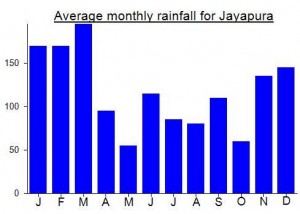
Origins and Meaning
‘Victorious peak’ in Indonesian. The highlands surrounding the peak were inhabited before European contact, and the peak was known as Nemangkawi in Amungkal. Puncak Jaya was named “Carstensz Pyramid” after Dutch explorer Jan Carstensz who first sighted the glaciers on the peak of the mountain on a rare clear day in 1623. When Indonesia took control of the province in the 1960s, the peak was renamed ‘Puntjak Soekarno’ (Simplified Indonesian: Puncak Sukarno) or Sukarno Peak, after the first President of Indonesia, later this was changed to Puncak Jaya. (Wikipedia, 2011)
Links and References
Wikipedia English Wikipedia Indonesia Wikipedia. 2011. Puncak Jaya. Accessed from http://en.wikipedia.org/wiki/Puncak_Jaya
10 thoughts on “Puncak Jaya (Carstensz Pyramid)”
I have seen the above comments that others has given and read the comments that describes about Carstensz Pyramid Expedition. I congrats you for proving the such a wonderful information.

Fascinating account by Bob Kerr about his 2008 ascent of Puncak Jaya… http://www.bob-kerr.com/?page_id=61
I heard of a trip to Puncak Jaya made by a friend of a friend in a group of (presumably) several Europeans. It didn’t exactly go to plan. On approach to the mountain they were held hostage by locals who threatened to murder them unless their financial demands were met.
The group was trekking with an established company who have taken climbers up Puncak Jaya many, many times before. Anyway, they ended up having to pay $10,000 per person to avoid being murdered. I have no idea how it was all arranged and feel lucky that I wasn’t part of it as not all of us are that rich.
After being freed by the disgusting locals who had captured them they decided, in mad bagging style, that they because they had got this far they ought to continue to climb the mountain itself! And so they did. It could have turned out a lot worse though. No wonder more people have climbed Everest than Puncak Jaya.
Article on a trip to Carstensz Pyramid which went a little wrong…
http://www.cqnews.com.au/story/2011/10/28/peak-of-terror/
JUST hours after Emerald coal miner Luke Richmond stood on top of the world, the adventurer’s euphoria was tempered by terror as he suddenly faced decapitation by machete or surrender to militant security forces in the jungle wilds of West Papua.
With virtually no chance of survival if he resisted, Luke and his fellow mountaineers played the odds and found themselves detained in a cramped shipping container on a ragged rock face for six days while cannibalistic tribal elders debated whether to kill one of them in a primitive form of justice.
“I’ve sort of been in a few situations like that before and it’s all about not losing your mind,” Luke said.
“You’ve just got to do stuff in your mind, because if you just sit there, that’s when you’ll lose it.”
What began as another step toward becoming the first Australian to climb the world’s seven highest mountains became a harrowing experience after a freak rock fall crushed one of the local kids that had set out with Luke’s group up the 4882m Carstensz Pyramid in Papua New Guinea.
For six days, the 10 climbers and about 50 local villagers hacked their way through some of the thickest jungle in the world just to reach the base of the mountain.
After 14 hours of what Luke called a “perfect climb”, the group stood on Australasia’s highest peak and thought the hardest part was over.
“It was a perfect climb. Six days through the jungle and one day on the mountain – it was incredible,” Luke said.
“But on that night, that’s when the problem started.”
When a rock, about the size of a body board, landed on the young porter, the village chief thought he had been killed instantly and sought justice according to local tribal law.
“The head villager ran down to our camp with his machete and began yelling for blood,” he said.
“He was waiting for someone to show himself so he could level the score.
“In that part of the world, the local people have a fairly simple way of thinking: ‘the climbers brought us here and we are hurt, so now they must be hurt’.
“An eye for an eye.”
The group’s mountain guide confronted the chief, finally convincing him to hold off killing one of the mountaineers, at least until after a discussion the next day.
They were told to return to the scene where they were greeted by mixed emotions – some of the villagers shook the westerners’ hands, some smiled, while others glared with intense resentment at the ‘murderers’ when they asked to see the porter.
“We took one look at his rising chest and told them he was still alive,” Luke said.
“We immediately mustered everyone together and built a stretcher out of old timber and then used one of their tarps to wrap the stretcher with the boy inside into something that could be carried steadily.”
The closest available medical help was at a nearby mine where 10,000 Papua New Guinean miners were on strike and violent riots had broken out.
Although fearful, the group had no option as the boy needed help, and if he died, one of the westerners would be killed.
“By dinner that night it was clear that we could not take the chance and head back into the jungle with this team of porters, it was simply too risky,” Luke said.
With no helicopter evacuation possible, the group surrendered to mine security who detained the group, confining them to a small shipping container perched on the edge of the mine.
For six days they ate only one meal of cold rice and chicken as they tried relentlessly to contact trek organisers Adventure Indonesia for evacuation.
On the morning of the sixth day, a Russian helicopter finally arrived at the mine and the hungry, tired and stressed mountaineers were flown to the nearby Timika, only to be evacuated again as rioters and striking mine workers took over the town.
Eventually the group made it back to Bali, safety and freedom.
“I was stoked,” Luke said.
“Until that point when we landed in Bali, nothing was set in concrete and could change at any time.”
Now back in Sydney, Luke summed up the trek simply as “hectic”, and has no intention of near-decapitation and possible cannibalism stopping him from conquering the seven summits.
In a few weeks he leaves for Thailand to begin training for his next mission – Vincent Massif in Antarctica.
Luke has already tackled Denali in Alaska, Aconcagua in South America and Kilimanjaro in Tanzania.
He will return to Russia next July for his second attempt at Elbrus.
“Four from five isn’t bad, not bad at all,” Luke said.
This just in from Ricky Munday…
Dear Friend,
I hope all is well.
I’m just writing to ask for your support and to let you know that my forthcoming Carstensz Pyramid Glacier expedition has been shortlisted to win the Berghaus Adventure Challenge. http://www.berghaus.com/en/adventure-challenge/shortlists – if I win, I get £1,000 towards the expedition, plus £1,000 worth of Berghaus kit, which would be a huge boost. It would be great if you could take a few moments to visit the Berghaus website and vote. Just click “Vote for this entry” on my expedition, easily register your email address, password and name, and you’re done!
I would also really appreciate if you were able to spread the word on Facebook/twitter etc or forward this email to your friends and family. Voting closes on 20th September so there are only a few days for people to vote.
The objectives of the expedition are to:
– safely climb Carstsensz Pyramid via the normal route up the north face. At 4,884m, CP is the highest mountain in Australasia, Indonesia and New Guinea and the highest island peak in the world. – compile a photographic record of Papua’s few remaining and fast-receding glaciers for analysis by climate change researchers in the UK, US and Australia
For info, I’m promoting the expedition using the following media:
Facebook: expedition Facebook page ( http://www.facebook.com/aus3peaks ) Twitter: expedition Twitter page ( http://www.twitter.com/aus3peaks ) and my own Twitter page (www.twitter.com/rickymunday) Website: the expedition website has been updated ( http://www.aus3peaks.com ) Blog: the expedition blog has been revamped and updated at: http://www.aus3peaks.blogspot.com Vimeo: I have been hard at work editing the video footage shot on an earlier expedition to Papua last year, but due to work demands in Bangladesh, have had limited time. In the interim, I have uploaded an introduction that summarises my previous Africa 3 Peaks expedition here: http://www.vimeo.com/26230409 ,
I will again raise funds for Raleigh International’s Youth Partnership Programme, which gives underprivileged young people the opportunity to experience a life-changing expedition overseas. People can donate £5 to Raleigh by texting AAWZ67 £5 to 70070. Or, visit http://www.justgiving.com/aus3peaks to donate online
Many thanks for all your support. I really do appreciate it.
wow the pictures taken from robert cassady are amazing.its a shame its cheaper to climb everest than take on this one.what with all the red tape etc..
Unfortunate news from Ricky Munday’s team……
RICKY MUNDAY FORCED TO ABANDON ATTEMPT TO SUMMIT CARSTENSZ PYRAMID – NOW FOCUSED ON PUNCAK MANDALA
Blogs reveal terrifying experiences climbing and descending Puncak Trikora and an alarming confrontation with armed locals on the return trek
Papua Province, December 9 2010 – Ricky Munday reported this morning that he has been forced to abandon his attempt to summit Carstensz Pyramid after his international agent cancelled his joining an existing expedition with just three days notice. Munday will now make his way back to the Star Mountains to attempt Puncak Mandala (4,640m). This is a huge disappointment for the 33 year old climber who has been holed up in Jayapura waiting for news on joining the Carstensz Pyramid expedition.
The full story of Munday’s hair raising ordeal climbing and descending Puncak Trikora is revealed in his blog posted on December 7 on the Australasia 3 Peaks Blogspot page (www.aus3peaks.blogspot.com). Climbing solo on slippery limestone rock faces, grasping foliage to prevent falling hundreds of feet into chasms, mountain sickness and dehydration, getting lost in the rainforest and hunger have made the expedition extremely gruelling. A threat from armed locals unsympathetic towards Munday’s driver was an additional scare on the way back from Trikora.
Ricky’s expedition report is now available on his website… http://www.aus3peaks.com/
Im only 16, but i enjoy climbing mountains and volcanoes in Java. I was just wondering how difficult the rock climbing is and how much it costs now.. is there snow on the top still? I hope I can climb it some day, but i have never climbed a mountain that you have to axe your way up or one with snow and this has both of those.. cheers and good luck to the team that will climb it in December!
Indonesian and American scientists are conducting a climate study on Puncak Jaya, article from The Jakarta Post here…. http://www.thejakartapost.com/news/2010/05/20/ri-us-launch-climate-study-puncak-jaya-glaciers.html
Leave a Comment Cancel Reply
Your email address will not be published. Required fields are marked *
A website about a really different tour guide in Papua
- Puncak Jaya-7th Summit
Brief Information About: #CarstenszPyramidExpedition”-7th summit-Asia Pacific
Puncak Jaya or Carstensz Pyramid (4,884 m) is the highest peak of Mount Jayawijaya in the western central highlands of Papua Province, Indonesia. At 4,884 meters above sea level, Carstenz Pyramid is the highest mountain in Indonesia. This is also the highest point between the Himalayas and the Andes, and one of the seventh highest peak in the world.
Puncak Jaya was named the “Carstensz Pyramid” after the Dutch explorer Jan Carstenszoon who first saw glaciers on a mountain peak on a rare day in 1623. The sighting was not verified for more than two centuries, and Carstenszoon was ridiculed in Europe when he said he had seen snow near the equator. The Carstensz Pyramid peak known today was not climbed until 1962, by an expedition led by Austrian mountaineer Heinrich Harrer with three other expedition members – New Zealand mountain climber Philip Temple, Australian rock climber Russell Kippax, and Dutch patrol officer Albertus (Bert ) Huizenga. Temple previously led an expedition to the area and spearheaded access to the mountains. Access to the top requires government permission. The mountain was closed to tourists and climbers between 1995 and 2005. In 2006, access was made possible through various adventure tourism agents.
- Professional experienced mountain guide
- Porters to bring team equipment
- T-Shirt for Team
- Certificate of Summit from Company
- All expedition permit fees needed include permission to the Indonesian Police
- Shuttle from the airport and transfer to Hotel Timika
- Charter (helicopter) flights to the Yellow Valley base camp II (base on 350 kg pay load)
- Car transportation during the trip
- *Single or twin share accommodation in Timika based on itineraries
- Accommodation based on twin / double share in Timika if there are delays in travel or additional days Camping gear (shared dome tent with 2 people per tent) or private tent
Day by day Activities :
Day-1 Arriving at Timika Airport is adjusted according to the arrival schedule, and I will pick you up in the arrival room to meet the Immigration Officer with the documents on me, then we will go to your hotel in Timika, and get breakfast in the hotel. The team will prepare expedition equipment including logistics, expedition trip permit document processing, etc. 13.30 PM I will pick you up from the hotel and we go to Immigration to sign the immigration documents and take picture officially. Rest and overnight at a hotel in the city of Timika
Day-2 In the morning at around 5:00 a.m. I will pick you up in the hotel I prepare the takeaway breakfast from the hotel 05.30 am You will depart from the helipad to Yellow Valley Camp by helicopter depends on the weather. Arrive in Yellow Valley in the base camp of Carstensz, my mountain guide will pick you up and bring you to the tents and you will served for hot drink and hot breakfast. Continue with the process of acclimatization, the physiological adjustment process in order to adapt to the new environment. Lunch at 1:00 p.m. Dinner at 7:00 p.m. local time and free program 9:00 p.m. You rest and stay in basecamp tents
Day-3 Breakfast at 07:00 WIT, acclimatization Climbing and falling exercises with rock climbing tools, can climb to the Nggapulu Peak (Puncak Sukarno) Lunch at 1:00 p.m. Simulation at the foot of the Carstensz peak 19:00 WIT dinner and free program At 8:00 p.m. break and stay at the basecamp tent
Day-4 Summit attack starts from basecamp Wake up at 00.30 am Eat lightly and prepare climbing equipment Around 2:00 a.m. starting for the summit attack, using your rock climbing equipment, the normal time to reach the summit is around 7-8 hours 10:00 WIT until at the highest peak of Indonesia (4,884 masl – CARSTENSZ PYRAMID) After the summit attack, back down to the basecamp at 11:00 WIT, it usually takes 5 hours and coffee breaks on the track Lunch, arrived at the basecamp at 16:00 WIT Rest and free program Dinner at 7:00 p.m. Overnight in a basecamp tent
Day-5 Extra Day For Summit!
Day-6 Breakfast and packing then you must be ready in the Yellow Valley for helicopter. You must remember, the good weather usually come on 6-10 am every day in the highland, that’s why you must strict with time for helicopter. The return trip from Yellow Valley Basecamp to Timika by helicopter. Arrive at Timika airport and head to the hotel Lunch and free program Evening, we will go out for dinner to celebrate your summit to Carstensz Overnight at Hotel in Timika.
Day-7 Breakfast at the Timika hotel We will visit the Kamoro Tribe and enjoy the traditional welcome dance and musical from the Tribe. You can enjoy to play game with children and give books and stationery for them from my foundation, TEMATA FOUNDATION. This is our way to develop local people every where we are through TOURISM, so local people get benefit from your coming and your heart will full of memories about the tribe’s culture. We also have another program for Charity to the Basic School in Timika. You can play games or sing together with children and also give some knowledge to them. You can choose the best option for your team.
Day-8 Breakfast at the Timika hotel Transfer from hotel to Timika Airport to fly back to Bali or Jakarta The end of the trip
- Professional experienced mountain guide Porter for the team
- Camping gear (shared dome tent with 2 people per tent) or private tent
- Cooking, food and beverage equipment during the expedition
- Satellite phones are only for emergencies and SMS.
- First aid kit
- Ticket airplane / transportation to Timika (round trip)
- Additional costs for excess cargo on flights Climbing equipment needed : ⦁ 1 sit Harness ⦁ 1 Jumar (Ascender) ⦁ 1 Descender (Figure of Eight) ⦁ 4 Carabiners Screw Gate and 2 Carabiners non screw ⦁ 1 Climbing Helmet ⦁ 3 Prusik ⦁ Double Lanyard (cowstail) ⦁ 1 Head Lamp ⦁ Crampon and Ice axe needed if want to climb gletser in the Nggapulu Peak (Sukarno Peak)
- Camper equipment (sleeping bag + air mattress)
- The cost of using a satellite telephone for personal use
- Additional snacks, food and drinks
- Any costs that arise as a result of delays or completion of the expedition earlier
- Personal equipment
- Personal expenses
- Personal medicine
- Private porter
- Souvenirs Need to know: ⦁ Schedule can be change without any prior notice due to unforeseen weather circumstance, force majeur or other safety reason ⦁ Plan your travel date at least 3-6 month ahead ⦁ This trip can’t give you fix date trip guarantee, you still can book at your convenience date. The vendor will confirm you the fix date around your available or convenience date ⦁ If the travel date didn’t match your availability time, you have a right to arrange travel date for max 1 (one) year ahead. Or you can do trip cancellation for refund with charge 25% from the total price. ⦁ Please bring all the equipment in exclude list for your convenience ⦁ Do not littering ⦁ Please obey the rule and instruction from your guide ⦁ Stay focus and keep safety first do not hesitate to inform your guide for any troubles during trip ⦁ Please inform your health condition before the trip start for your convenience
Price (base on the capacity of helicopter load 350 kg per trip) : 1 person : US$ 00,000.00/pax 2 person : US$ 00,000.00/pax 3 person : US$ 00,000.00/pax 4 person : US$ 00,000.00/pax
More info about the Trip cost, Please contact us Click

Share this:
Five reasons to contact us if you want to experience papua:.
- Baliem-Valley
- “Iki Pale”-Dani tribe |Wamena
- 3 Days Adventure-Papua
- 3 Days Dani trekking
- 4D/3N Baliem Valley Hiking
- 5 days Baliem valley Treks
- 5 Days Baliem valley | Papua
- 5 days trekking in Baliem
- 5 Top-Rated Tourist Attractions in Wamena
- 6 Days Baliem Valley Treks
- Baliem Cultural Festival-2025
- Baliem Gorge Treks
- Baliem mini Adventure
- Baliem Treks
- Baliem Valley Annual Festival 07 –09-2025
- Baliem valley Festival-2025
- Baliem valley gorge treks
- Baliem valley tour Guide
- Baliem valley trekking
- Baliem valley Treks
- Cultural tour-Baliem valley
- Dani Best Program
- Dani Culture Fetival-2025
- Dani tribe adventure, Papua
- Dani tribe Treks
- Festival Baliem-2025
- Five days in Dani tribe
- Indigenous Melanesians
- Info Baliem Valley Festival 2025
- 10 days Korowai Tribe
- 11 days Dani & Korowai Tribe adventure
- 15 days Korowai-Asmat Adventure
- 4 Days Momuna-Korowai tribe
- 8 Days Korowai-Asmat
- Asmat Festival | 2024
- Asmat tribe-Papua
- Asmat-Baliem valley Festival
- Asmat-Rock Korowai
- Go visit Momuna-Experience Sago
- Indigenous Tribe, The Korowai
- Into the wild: Korowai
- Korowai Batu-Southern Papua
- Korowai tour, Papua
- Korowai Tree House Tribe
- Korowai Tribe-9 Days
- Korowai tribe-Papua
- Korowai Trip Highlight
- Korowai-Rock
- Merauke-Korowai-Kepi-Asmat
- Papua, Korowai tribe
- Remote Korowai Trip
- Rock Korowai-Asmat
- West Papua’s Ancient Tribes
- Lani & Dani tribe Adventure
- Mt.Hagen Festival-2024
- Mt.Wilhem Treks-PNG
- Papua Honeymoon Tour
- Papua Optional Trips
- Papua Orchid Bilum
- Papua Photography adventure
- Papua private guide
- Papua Smoked Mummy
- Papua Tour 2025
- Papua: Trekking to the Dani
- Raja Ampat Tour
- Remote & authentic tour
- Southern Dani treks
- The Dani Tribe, Papua
- The Remote Tribes
- Tour Mamberamo | Papua
- Trek Trikora Peak
- Wonderful-Baliem
- Yali remote treks
- Baliem valley mini trip
- 15 days Birds Photography
- 19 Indonesians Protected Endemic Butterflies
- 3 Days Raja Ampat
- 4 days Raja Ampat Trip
- 4 Days Visit Kei islands
- 5 days Manokwari-Arfak Birding
- Asmat Festival-2024
- Baliem valley-Raja Ampat
- Baliem-Raja ampat tour
- Cyclop Mt.Nature Reserve
- Fak Fak Tourism
- Fallen Paradise Islands
- Heaven for Divers
- Honeymoon-Raja Ampat
- Kaimana Triton Tour
- Kei islands
- Nabire Sharks
- Nabire Sharks trip Papua
- Ngurtafur beach-Key islands
- Raja ampat adventure
- Raja Ampat Trip
- Sowa Beach-Nabire Whale sharks Trip
- Trip Pyanemo-Raja Ampat
- Waigeo Birds Park
- Waigeo Islands Birds
- Whale shark-Nabire Papua
- Whale Sharks Tour Papua
- Yapen Islands tour With Leo
- #Papua Birds Photography
- 10 days Nimbokrang-Arfak Birding
- 11 Days Seram Birding
- 15 Days Birds Photography
- 4 days Arfak Birding
- 5 days-Raja ampat Birds Photography
- 6 kinds of Paradise bird
- 6 Nights-7 Days Mt. Hagen Birds Watching
- 8 Days-Arfak Birds Photography
- Arfak Birding
- Arfak Birds
- Arfak Birds Tour Highlight
- Arfak bow birds photography
- Arfak Endemic Birds
- Arfak Foot hills birding
- Arfak foothills birding
- Arfak foothills Wildlife-West Papua
- Arfak Wildlife Reserve
- Aru island Apoda Paradise
- Aru islands Birding
- Badi Gaki-Aru Islands
- Biak Numfor island Birding
- Biak-Supiori Wildlife Trip
- Bird Watching The Birds Of Paradise
- Birding in Dugum Hills-Wamena
- Birds of Paradise
- Black Sicklebill-Arfak
- Global Birding
- Lorentz National Park Birds
- Lorentz Park Birding
- Lorentz Park Lines
- New Guinea Paradise
- Nimbokrang-For Birders
- Normanby Birds Photography
- Papua birds Photography
- PNG 7 Days birding
- PNG Festivals 2024
- Pondok 3-Yabogima-Lorentz Park
- Seram Birding-Wallace
- Snow Mountain-Lorentz Park
- Solomon Island Birds
- Sulawesi-Wallace Birding
- Wallace Bird Photography
- Wasior Birding Tours
- Yapen Island Birds
- #PapuanBestFoods
- #PuncakJaya-7th Summit
- 12 days upper land Yali
- 15 days trip into deep Papua
- 16 Days Lani Tribe Trip
- 2 days Jayapura Tour
- 2024 lake Sentani Cultural festival
- 3 days tour in Baliem valley
- 4 Nights Dragon Islands
- 4D/3N Jayapura-Baliem Valley
- 5 days trekking to Dani region
- 7 Days Tour Sepik-PNG
- 7D/6N itinerary in Baliem valley
- 8 Days Cultural Tour & Festival
- Adventure in Yali tribe
- Bauzi Tribe-Face your Fears
- Bromo-Batur Volcano Trip
- Carstensz Pyramid Expedition
- Eco Land Management Project
- Explore Yali Tribe
- Festival Budaya Lembah Baliem
- Gallery of Rinjani Treks
- Giluwe Treks_PNG
- Giluwe Treks|WHP| PNG
- Habema-Mount Trikora
- Hagen Cultural Festival-2024
- Hagen Festival & Treks
- Hagen sing-sing Festival 2024
- International Noken Day
- Into the wild: Yali country
- Itinerary to Korowai
- Jayapura CusCus
- Jayapura mini adventure
- Kalam Festival-PNG-2025
- Karimui Show Village
- Key Islands Tour
- King Birds of Paradise
- Major Festivals | PNG
- Mamberamo Insects
- Mamberamo Short Trip
- Mamberamo Tribe Adventure
- Mamberamo-Bauzi
- Mamberamo-Fuyu Tribe
- Mandala Peak
- Megalithic Site-Doyo Lama
- Mount Hagen Cultural Show
- Mt.Bromo Tour-3D/2N
- Mt.Giluwe Hikes |PNG
- Mt.Giluwe Peak |Short Program
- Mt.Giluwe Treks |PNG
- Mt.Giluwe |Mt.Wilhem Trekking
- Mt.Giluwe-Volcano Peak-PNG
- Mt.Hagen Sing-sing Festival-2024
- Orangutan-Pangkalan Bun
- Orangutans Adventure
- Paniai Tribe Adventure
- Papua adventure programs
- Papua cuisines Filming
- Papua Jungle Expedition
- Papua optional tour programs
- Perang Dunia Ke-2 di Goa Jepang
- PNG-West Papua Tour
- Puncak Gunung Trikora
- Puncak Jaya Papua
- Puncak Mandala
- Rinjani Trekking packages
- Sentani Lake mini adventure
- Sepik Highlands Tour
- Southern Baliem Valley Trekking
- Stone Burnt Party, Papua
- Tanjung Puting-National Park
- The Asaro Mudmen
- Tomako Batu-Sentani,Papua
- Treks – Mount Wilhelm
- Trikora Peak hikes
- Trikora Peak Treks
- Tumbuna Festival Tour-2024
- Wabudory Waterfalls-Supiori
- Yali lowland Treks
- Yali Pocket Dictionary-Papua
- Yali tribe treks
- Yali tribe treks Gallery
- Yoboi village
- Yoboi-Sago Worms Festival
- The Yali tribe tour, Papua
- Sentani Lake Festival 2025
- Papua Filming Fixer
- © trek-Papua | All right reserved
Blog at WordPress.com.

- Copy shortlink
- Report this content
- Manage subscriptions

- How to Climb Puncak Jaya; Oceania highest mountain

Puncak Jaya (or Carstensz Pyramid as it used to be known) is the highest mountain in Indonesia, and Oceania highest mountain. I have wanted to climb Puncak Jaya since committing to climbing all seven summits, the highest mountain on each continent ( if you’re wondering what are the seven summits, you can check those out here ). Puncak Jaya is also the highest mountain in Continental Australia, it’s located on Papua island, Indonesia.
In May 2019, I finally managed to climb Puncak Jaya and for a fraction of the cost of the normal prices, which are often quoted at $13k to $20k USD. Ouch. I did it for well under $10k. Read on and see how I did it (and how you too can do it!).
Table of contents
- How Much Does it Cost to Climb Puncak Jaya?
Puncak Jaya Deaths
What is puncak jaya’s altitude, so where is puncak jaya and how do you get there, how to book a cheap puncak jaya climb:, climbing puncak jaya; my personal experience, jumar training, summit attempt, day 5 (& an unplanned day 6 & 7), what’s next, is it called puncak jaya or carstensz pyramid, final thoughts on climbing carstensz pyramid (puncak jaya).
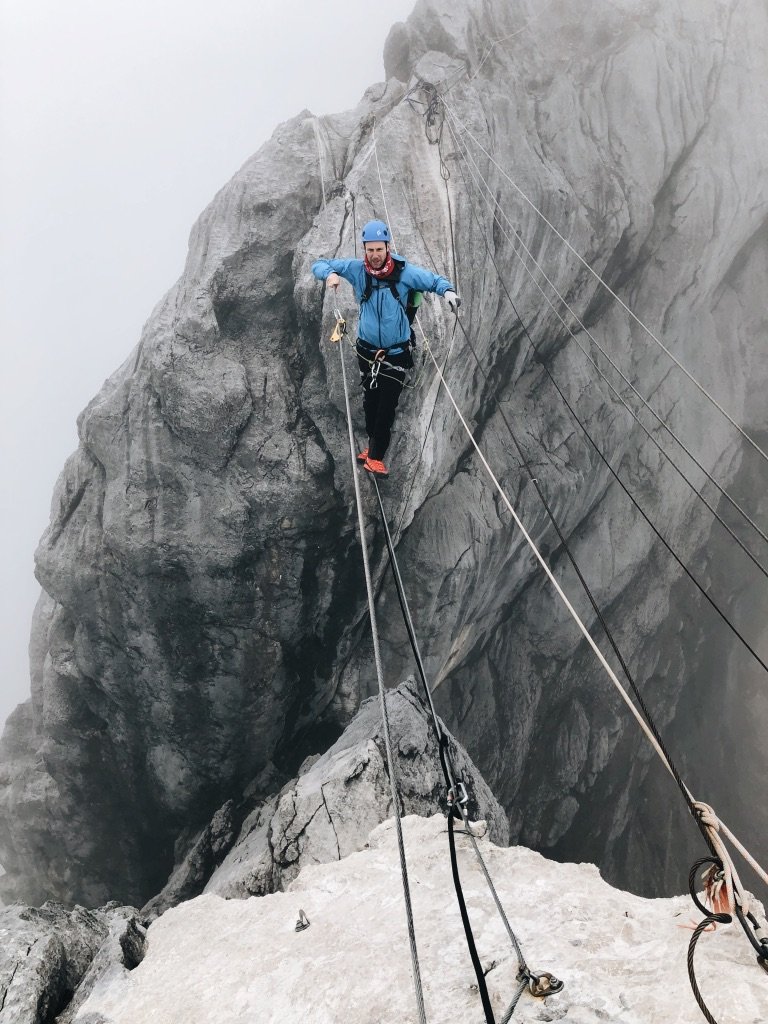
How Much Does it Cost to Climb Puncak Jaya?
I had been researching all the big mountain operators, and everyone was quoting super expensive prices so I delved a little deeper, and spent weeks trying to find what local operator the big guys were using until finally, I found Reagan, the owner of Summit Carstensz , on FaceBook. After chatting for a couple of weeks, making sure he wasn’t a scammer, I finally committed to climbing with him.
The price? $7500. Over $10k cheaper than the big Western operators. I had to send a $2k deposit, which I was a little wary about, but after traveling so much I’ve discovered it’s better to trust people than not so I proceeded, and it worked out great. Eventually, I flew to Bali, met one of the Summit Carstensz staff and we were on, a week later I was perched on top of the highest point on the continent. Money well spent.
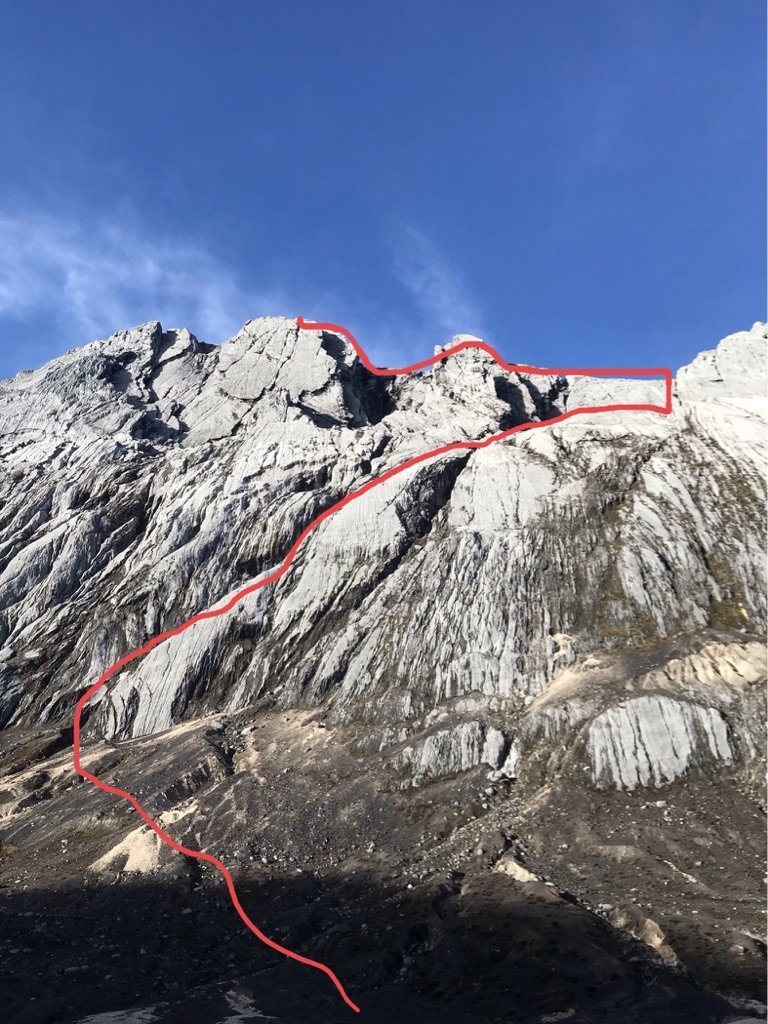
So, having now successfully climbed Puncak Jaya, let me help you guys do the same thing with recounting my experience and some FAQs too:
Is it Dangerous To Climb Puncak Jaya?
It can be. It is Oceania highest mountain afterall! Previously, climbing Puncak Jaya was super dangerous. You’d arrived in Timika airport, in southern West Papua (as I did). After checking your gear etc, the next day you’d start a week-long hike through the jungle to get to Puncak Jaya Base Camp. This was hugely dangerous. West Papua is full of legitimate tribes, bows, arrows and spears type tribes, fascinating but terrifying. These tribes used to hold a lot of hikers hostage, demanding ransom from the guides, so the guides would have to pay thousands (sometimes up to $30,000!!). Recently, two expeditions had people murdered for not paying ransoms. This is what has made Puncak Jaya so expensive, and so dangerous. Since that, the hike has been closed, and you take a helicopter from Timika to base camp instead, which is what I did.
The actual climb, is it dangerous? A little. 2 people recently died due to rocks falling. And the climb itself, while only taking 2 days (one of which is acclimatization), is short, it’s hugely steep. It’s quite technical, 90%+ using rappelling and jumar techniques, so either be ready with that skillset or be prepared for a sharp (and scary) learning curve! Only 500 or so people have ever summited Puncak Jaya, due to the remoteness of the mountain, and of course, the dangers associated with the tribes, but if you’re careful, and you take the helicopter, then I’d say you’re pretty safe.
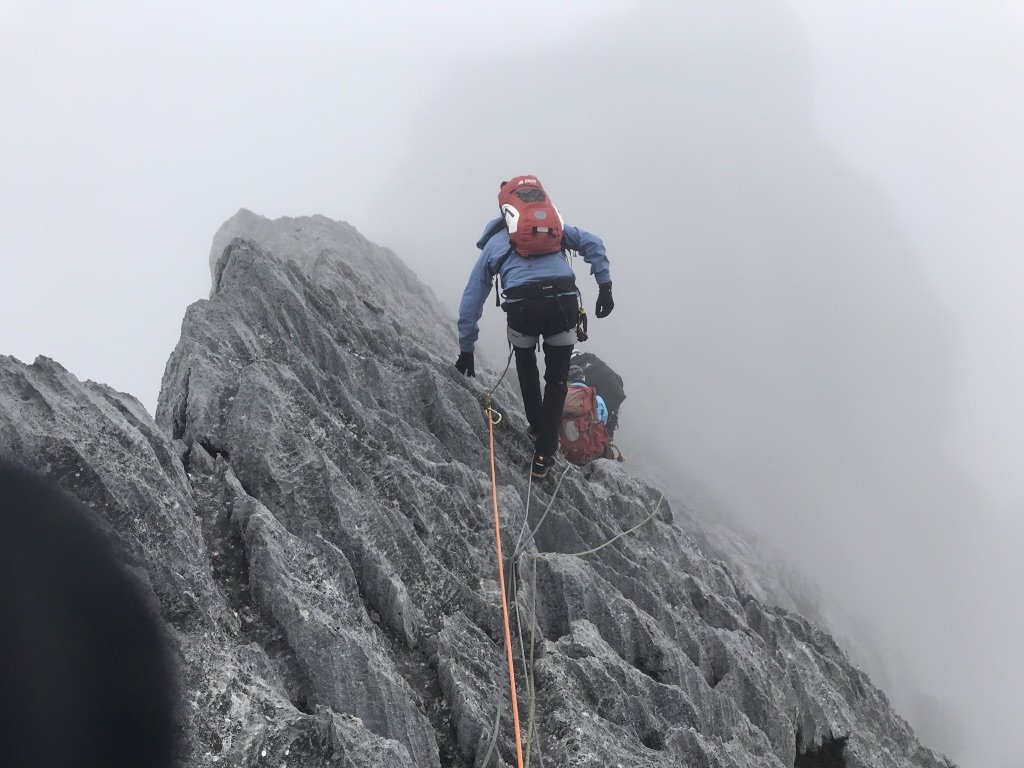
4,884m / 16,000 feet. But the altitude is not what makes Puncak Jaya difficult in all honesty. That comes down to both how remote the location is, the cost and most importantly, how technical the climb is. Base camp is located at 4300m, so the Summit Attempt doesn’t cover THAT much altitude gain, although at nearly 5000m, oxygen isn’t in abundance and things are a little slower.
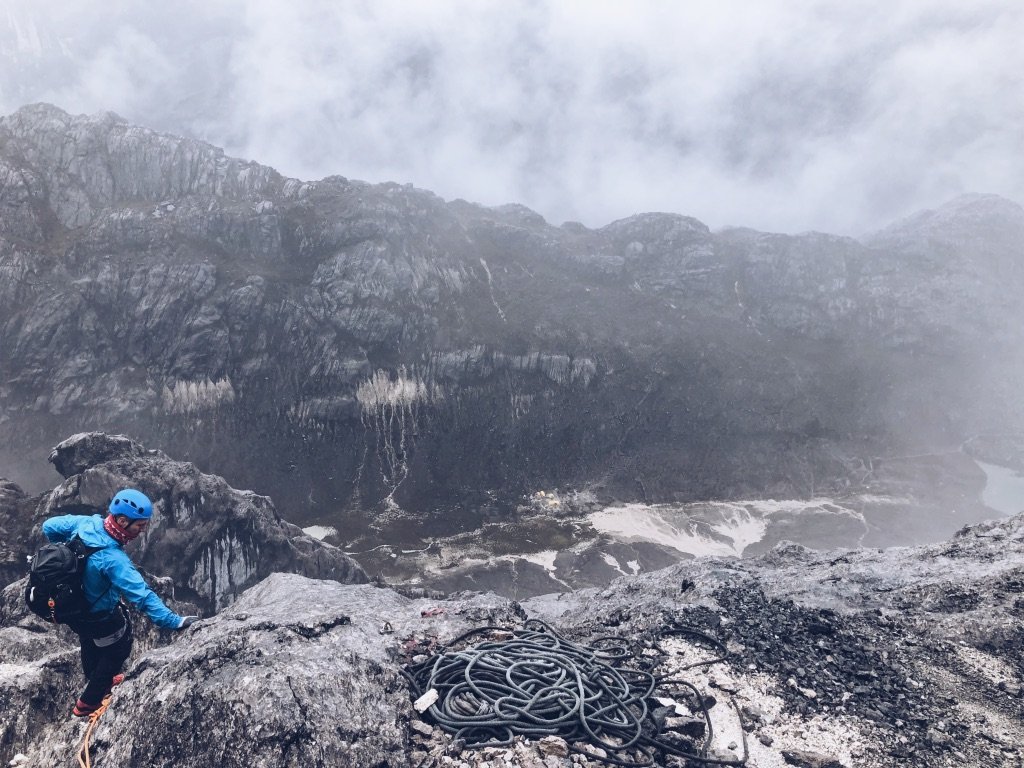
Good question. It’s on an island in South East Asia called ‘Papua’, the same island as Papua New Guinea but this half of the island belongs to Indonesia. Although that’s a political issue I don’t want to get in to.
Once in Papua, you’ll be in the South, in the city of Timika. To get there, you first fly to Bali, Indonesia, then take a domestic flight to Timika (this was included in my climb with Summit Carstenz). Timika is a small town, but there are actually a couple of mountaineering stores there, so if you need a headtorch or any other last-minute gear you forgot, you may be lucky! There’s not much going on in the town, so you’ll stay there for 2 nights, check your gear, and then hopefully on Day 3, weather depending, you’ll go back tot he airport early in the morning and hop into the helicopter to base camp, about a 30-minute ride.
If you look online, you’ll find dozens of mountain operators quoting prices around $20k USD. Not cheap. However, I’ve done the leg work for you guys, and found the operator directly at the source – Summit Carstensz . With these guys, the price is around $7700USD, starting from Bali, still not cheap but a considerable saving from the big operators and this is the cheapest I’ve ever heard of. Not only that, they were really easy to deal with.
The expedition allocates 10 days, so give yourself a buffer for your return flights. The helicopter is often delayed due to clouds and wind, although my expedition went quite well and total time was about 7 days all-in from Bali until I was back in Bali.
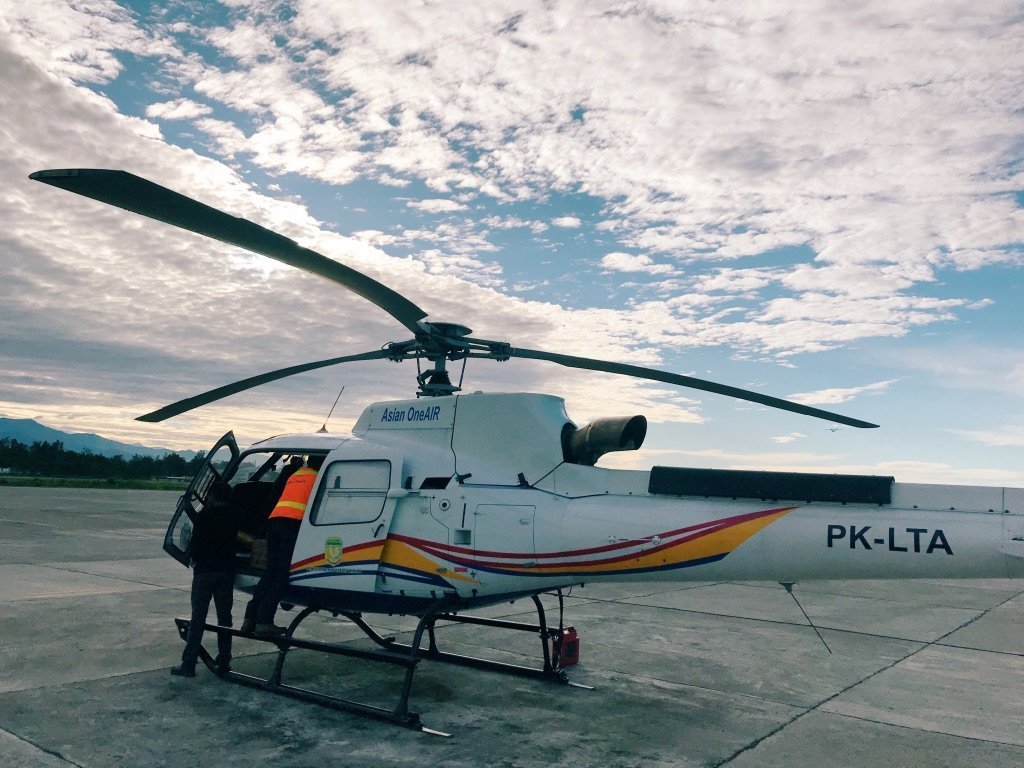
I wouldn’t call myself a mountaineer by any stretch, but I’ve been gaining a little bit of experience over the last 18 months or so with climbing Mount Fuji for charity with my mum, summiting Europe’s highest mountain, Elbrus , trying (and failing) to climb South America’s highest mountain in Argentina , (EDIT 2020 – I WENT BACK TREKKING ACONCAGUA AND REACHED THE SUMMIT!) and climbing Kilimanjaro (more of a hike in all honesty!) . I’m signed up for Aconcagua again in January 2020, and Denali – North America’s highest mountain in May 2020 but all those days added up together barely reach 2 months on mountains. So I don’t really know what I’m doing!
That doesn’t normally stop me signing up for things though, like running the North Pole marathon having never run a marathon before , or the Marathon Des Sables Ultra Marathon – 6 marathons in 6 days in the Sahara, having never run an ultramarathon before , and I managed to squeeze through those. Just. So with a view to climbing all Seven Summits , I had to climb Puncak Jaya one day, so why not sooner rather than later? After finding Reagan, owner of Summit Carstenz , online, I had signed up, paid my deposit, dragged my fearless (read: stupid) my buddy Anthony into the fray, and we had about 100 days to get our gear and our minds ready for it.
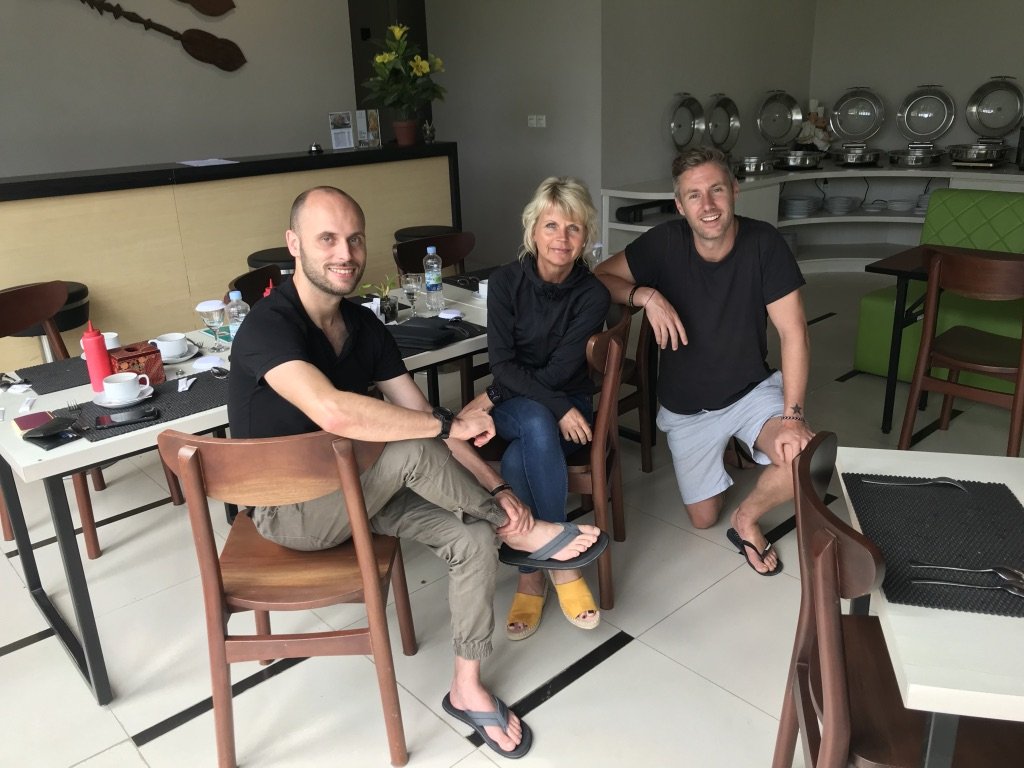
The climb was scheduled just a month after the Marathon Des Sables , so I knew I’d be quite good fitness-wise, but I’d be weak. So I hit the gym for that month, and that was it – ready to go. I had all my mountain gear from the climbs I’d been doing over the last 18 months, so aside from actual rock-climbing stuff, I was pretty set. I flew to Indonesia about a month early, as I was building a library with my Mudita Adventures non-profit , so once our volunteers flew home from that trip, I was already in Bali and ready to climb Puncak Jaya.
DAY 1
From Bali, I flew directly to Timika, a 4.5-hour flight, where I spent 2 nights in a hotel there. The hotel was decent, wifi, air-con, hot water. Here we met the 3rd member of our group, an amazing woman called Merethe, and a grandmother no less! She was more experienced in mountains than both Anthony and I and had actually almost summited Everest a couple of years previously but her Sherpa got hill and they had to turn back.
Anyway, after the first night, we wandered around Timika that day, checked out gear. It was also the last chance we had to pick up any snacks or rent any other things that we need. I rented all my rock climbing gear from Reagan, the harness, ropes, helmet, figure 8, jumar (total price was $180USD to rent all that). Back to bed for another night, and you just hope that the weather will allow the helicopter to fly the following morning.
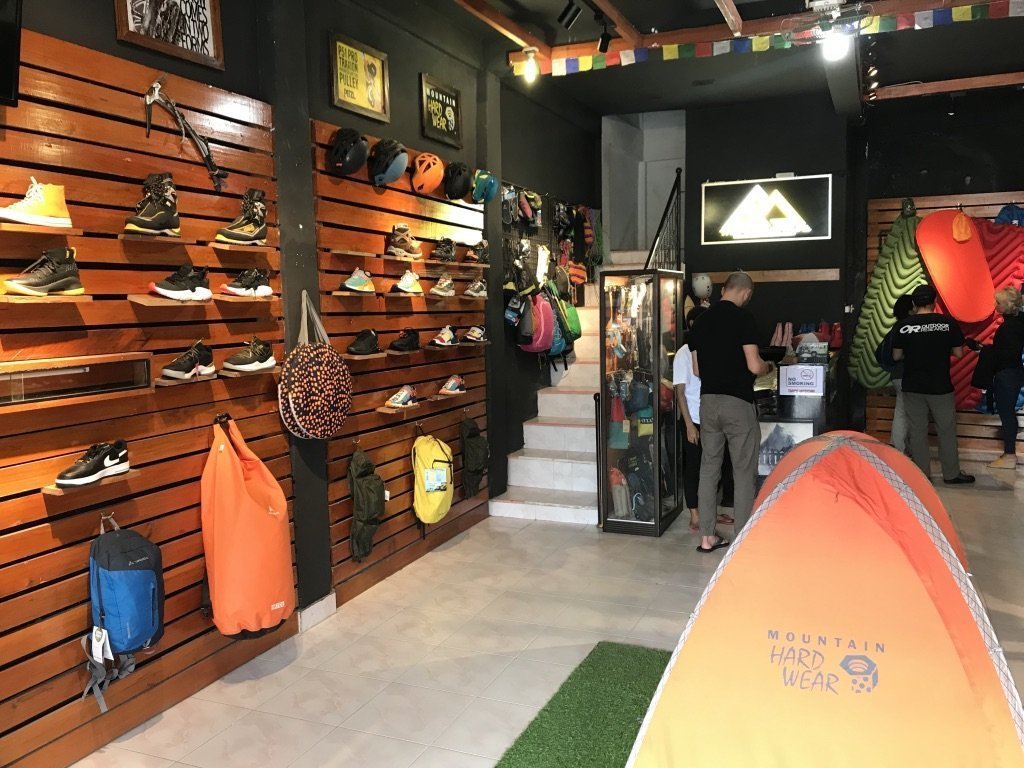
We were onto Day 3 of the expedition; We woke up at 4.30 am for a 5.30 am departure to the airport. The weather wasn’t great and so the helicopter pilot had asked us to get to the airport early, perhaps they’d be a break in the weather. There wasn’t. We hung around the airport for 3 hours or so, and it looked like we’d have another day to kill in Timika, but out of nowhere the clouds cleared.
The team at Base Camp had given the all-clear, so we rushed to the helicopter and off we went. The helicopter ride is awesome, you fly over the biggest gold mine in the world, and the views are spectacular. Also, knowing about the tribes beneath you and how dangerous it is to hike through the jungle left me feeling blessed to be able to live a life like this, one where you can hop in a helicopter and skip the danger. Before long, we touched down at base camp, and it was spectacular.
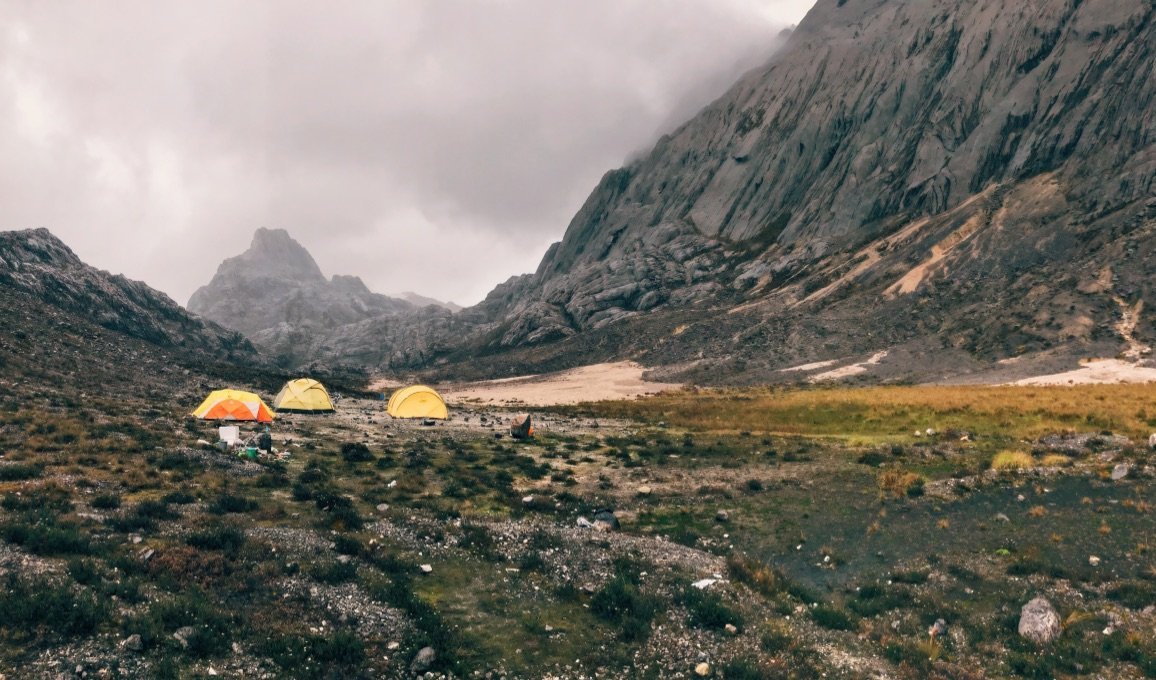
Summit Carstensz, our operator, had already sent the 2 guides to Base Camp the day before. So the dining tent was already set up, as soon as we landed and the helicopter left us, the 2 guys quickly set up our tents too. It was about Midday now, and the plan was to spend the day doing rope/jumar training, sleep in our tents, then the following day would be spent acclimatizing, before going to sleep in the tents again but waking up at 2 am for the climb attempt. All good with us.
Training began, and neither Anthony nor I had ever used a ‘jumar’ before. It’s kind of like a handle, that’s attached to the harness around your waist. You clip it onto the fixed ropes that lead the way up the mountain, and as you move it forward, it traps the rope so you can apply all your weight to it and it won’t fall. Really effective, but quite tricky to get the hang of. That being said, the training went well and we were feeling vaguely confident.
The weather wasn’t great, and the guides were worried that moving forward it could take a turn for the worse. If bad weather came in, we’d be stuck at Base Camp, on rations, until the weather clears. Not ideal for anyone (not to mention my Indonesia visa would expire in 5 days time). So they proposed something a little crazy. They knew we had some mountain experiencer, they could see we were quite fit, and after testing our oxygen levels on the Oximeter, we decided that we’d skip the next day and go straight for the summit tonight, at 2 am. Let’s do it!
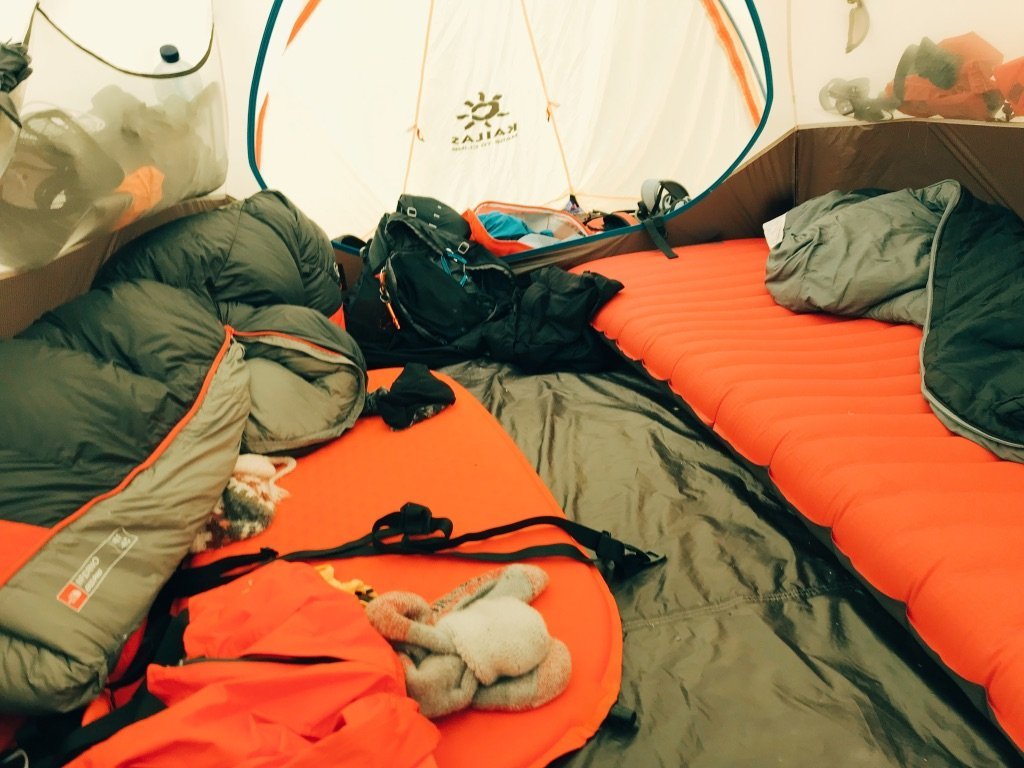
So we milled around Base Camp for the evening and tried to go to bed early, knowing our alarms were set for 1 am. But as anyone who has been at altitude can testify, when you gain a lot of height in a day, it’s so hard to sleep. So a restless evening in the tent ensued before the alarm was buzzing and we were ready to go. Pitch black, about 5 degrees in temperature, harnesses on and summit bag packed, we were off.
The entire Base Camp to Summit is an almost sheer cliff. It’s fixed ropes the whole way, hence the rappelling and jumar skills required. Lot’s of the climbing requires full trust in your upper body strength and the integrity of the equipment. At times you’re required to balance on razor-thin sections of cliff, with all your weight on one hand on the fixed rope, with sheer drops beneath you. In a way, it’s almost good to start at 2 am because you can see very little and the fear doesn’t get a chance to accumulate.
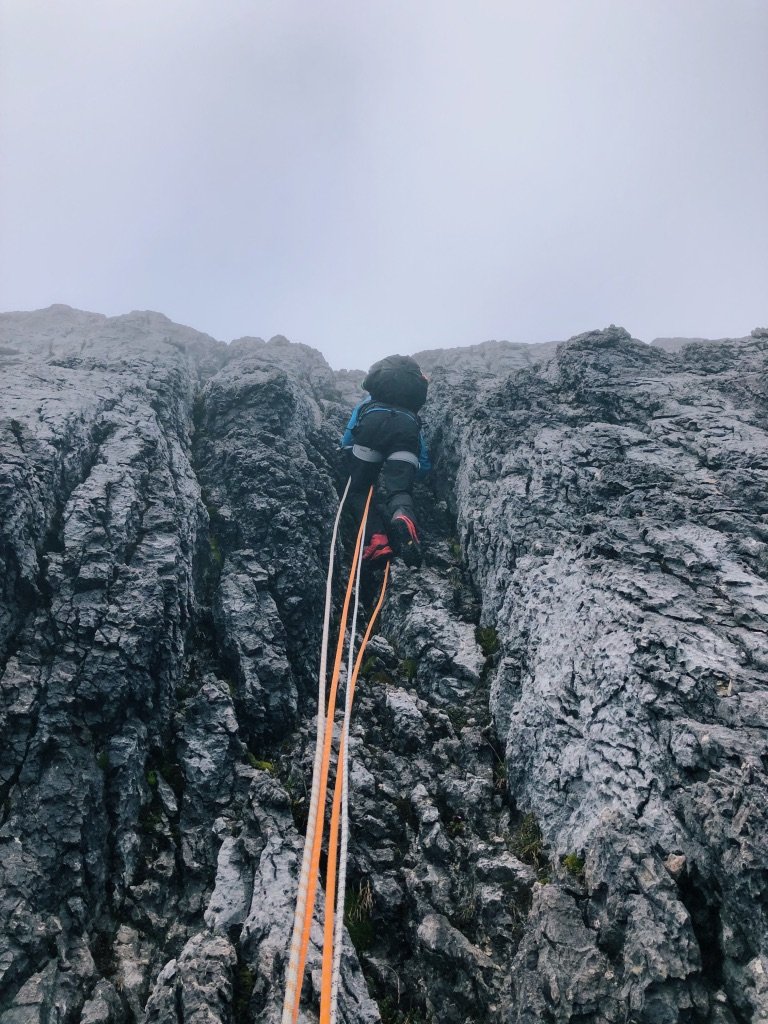
Everyone 20 minutes or so, we take a quick breather. Around 5000m in elevation, you always get tired alarmingly quickly. 100ms feels like 500m. But I like it in a weird way, and we were making progress. 2 am became 3, which became 4 and 5 and 6 until finally, the sun started to rise. Now the task at hand suddenly dawned on us. Sheer drops were now visible, and wow what a view.
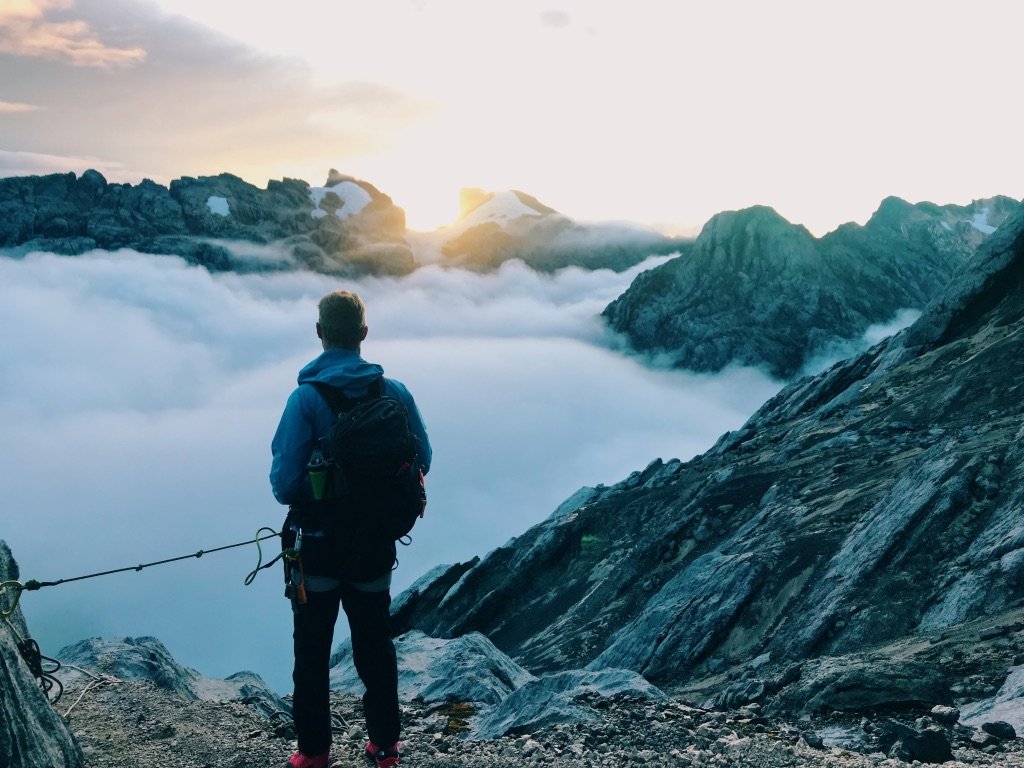
We were the only people on the mountain, privileged to see how beautiful this part of this isolated island was. You’re forced to take a moment and appreciate where life has brought you, but I snapped out of quickly and pressed on. One miss-clip of a fixed rope, forget to attach the safety, and you’re dead. Black and white. This is why Puncak Jaya is the most technical of the Seven Summits.
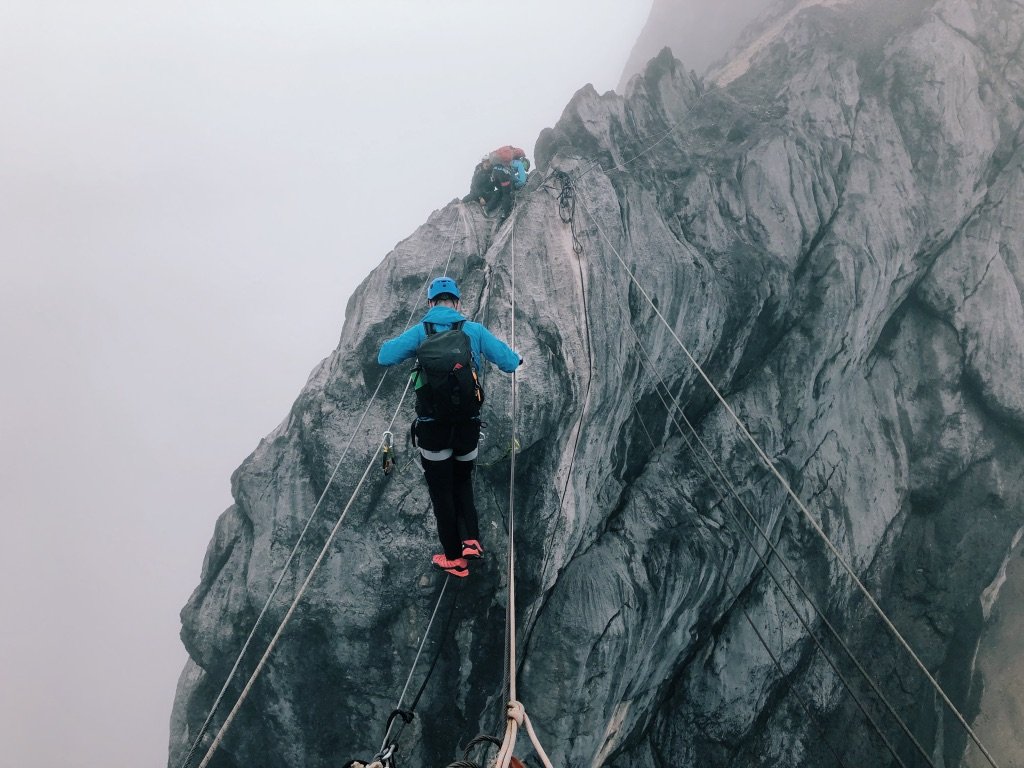
We were hoping to be at the Summit by 8 am but we missed that deadline by quite a stretch. After crossing the infamous wire bridge on Puncak Jaya, we finally made it to the Summit around 10.30 am. On that last stretch, it’s always a weird feeling. Having set a physical goal, committed to it, paid for it, trained for it, to suddenly know that you’re actually going to reach it. It’s such a buzz. Pride, relief. Happiness. I guess that’s what we do it for, that and the glory. And then we were there. A top the highest point of Continental Australia. Boom.
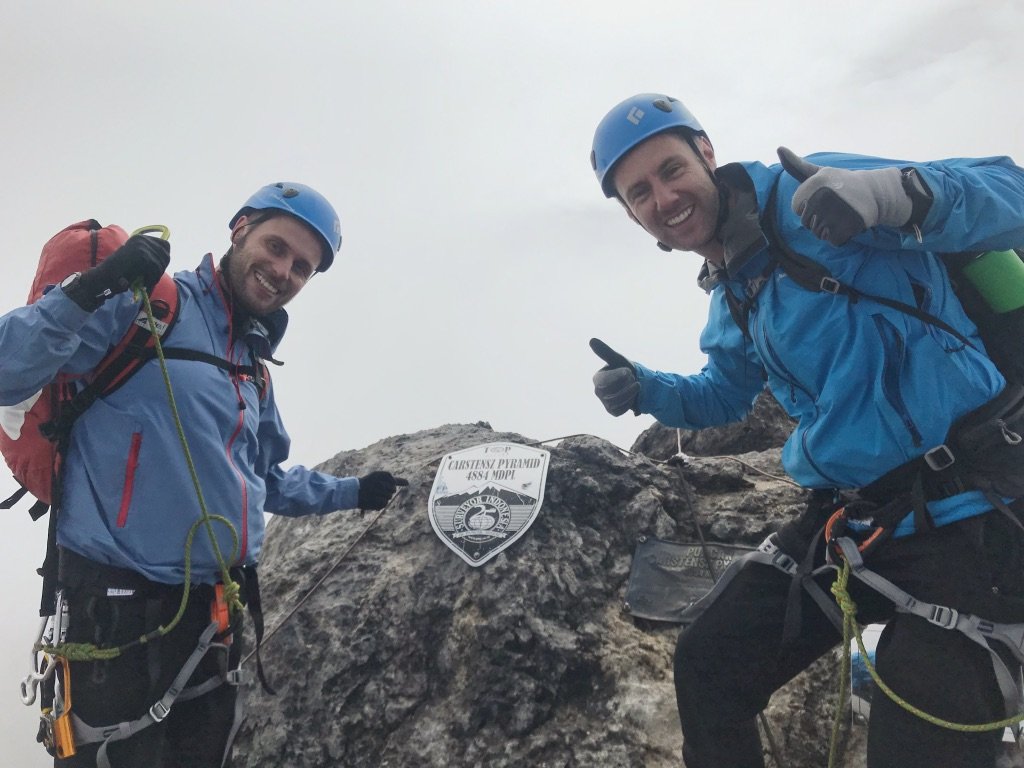
Selfies, pics, high fives. But of course, at that point, you’re only ever half-way there when it comes to mountains. Now you have to get down the bloody thing. On normal mountains, that’s strenuous, on this sheer cliff face, it was a stressful prospect indeed! It took us about 5 hours to descend the mountain. The weather turned and we were soaked. But after summiting, nothing can affect your mood. So we carefully made our way down. Arriving back to base camp is a treat indeed. Hot coffee, change out of your soaking summit-gear, chat about all the stuff you kept to yourself on the climb. The fear, the fatigue. None of it matters know, we did it!
From there, we spent one more night at basecamp. When we woke up the next morning you hope that the weather is clear once again, so the helicopter can collect you. Luckily for us, that was the case. We were whizzed back to Timika before lunchtime, a day ahead of schedule! We were thinking maybe we could even connect straight to Bali the same day, cutting our 10-day expedition down to 6, but reality bites.
A volcano had erupted in Indonesia and our flight to Bali was cancelled, and no replacement was available for a week. We ended up taking 5 separate flights over 48 hours. Dotting around islands across Indonesia before finally getting back to Bali spot on time, a week after leaving Bali. But as I said, we summited, so I couldn’t care less about that!
So what’s next? I had planned to fly back to Bangkok. But after discussing the Seven Summits with Anthony, we knew that there was a school of thought that Continental Australia’s highest peak was actually Mount Kosciuszko , near Canberra, in Australia. Not Puncak Jaya/Carstensz Pyramid. So rather than sleep in Bali, we hopped to a burger joint, jumped on the Wifi, and flew that Night to Sydney.
The following morning we connected to another flight to Canberra. We rented a car and drove 3 hours to Mount Kosciuszko and had a crack at that instead, but that’s another blog post here . In the meantime though, here’s the pic fro the top of Kosciuszko. 7 flights in 48 hours, followed by a hike. Never again, still though, what an adventure. Life’s for living, right?
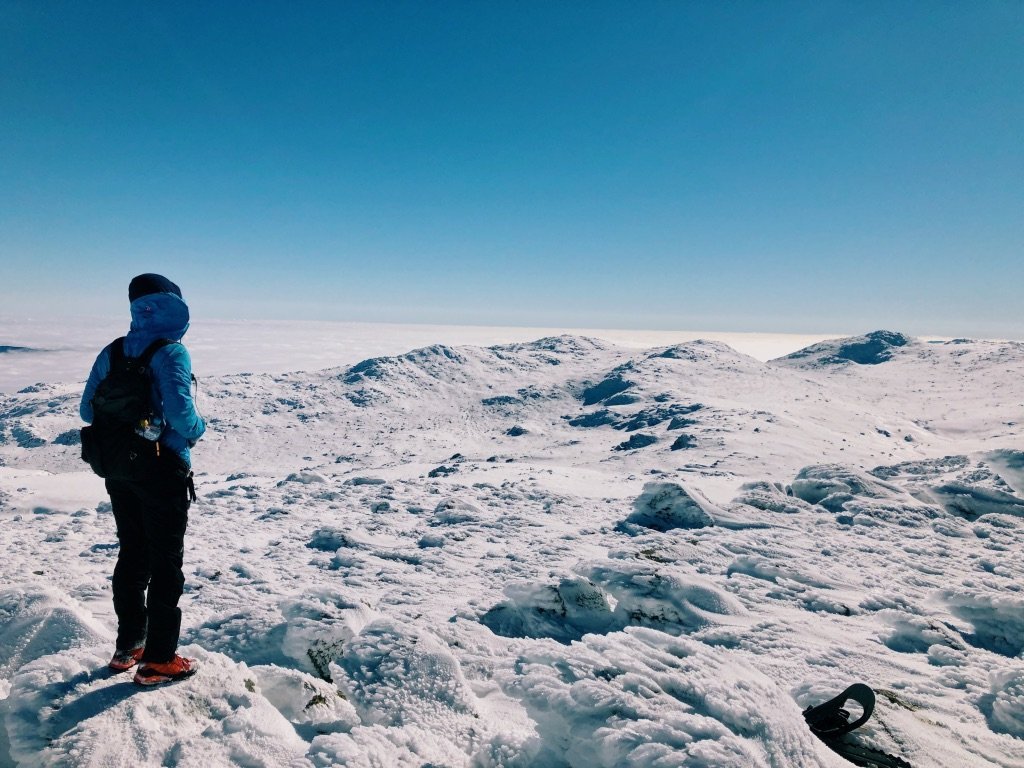
I know, it’s confusing. But Puncak Jaya and Carstensz Pyramid are, in fact, the same mountain. In 1623, Dutch explorer Jan Carstenszoon was the first foreigner to see the mountain. The first expedition to climb it in the early 19th century used ‘Carstensz Pyramid’ as the name. So the mountaineering community adopted that name. But in 1963 Indonesia took control of Papua, and since then it’s been Puncak Jaya. In some mountaineering circles, however, it’s still referred to as Carstensz Pyramid. Either way, it’s undoubtedly Oceania highest mountain.
Climbing Puncak Jaya, another Seven Summit, was an amazing experience. Bagging Oceania highest mountainClimbing Puncak Jaya though, it doesn’t come cheap, and it’s not easy. But it’s certainly doable for people with a decent level of fitness and even a little mountain experience. The area that the mountain is located in is unreal too, so beautiful and completely untouched by tourism. I’d recommend West Papua to any intrepid travellers too. But Puncak Jaya? Do it. Ignore the costs you read online, they’re crazy, go through the guys I used – Summit Carstensz , save yourself a fortune and send me a pic from the top. Good luck!
Remember, never travel without travel insurance! And never overpay for travel insurance!
I use HeyMondo . You get INSTANT quotes. Super cheap, they actually pay out, AND they cover almost everywhere, where most insurance companies don't (even places like Central African Republic etc!). You can sign-up here . PS You even get 5% off if you use MY LINK ! You can even sign up if you're already overseas and traveling, pretty cool.
Also, if you want to start a blog...I CAN HELP YOU!
Also, if you want to start a blog, and start to change your life, I'd love to help you! Email me on [email protected]. In the meantime, check out my super easy blog post on how to start a travel blog in under 30 minutes, here! And if you just want to get cracking, use BlueHost at a discount, through me.
Also, (if you're like me, and awful with tech-stuff) email me and my team can get a blog up and running for you, designed and everything, for $699 - email [email protected] to get started.
Do you work remotely? Are you a digital nomad/blogger etc? You need to be insured too.
I use SafetyWing for my digital nomad insurance. It covers me while I live overseas. It's just $10 a week, and it's amazing! No upfront fees, you just pay week by week, and you can sign up just for a week if you want, then switch it off and on whenever. You can read my review here , and you can sign-up here !
So if you’re ready to…..
1) change your life 2) travel the world 3) get paid to travel 4) create a positive influence on others 5) be free of offices and ‘real world’ rubbish, then sign up below and let’s get started, previous post 10 things to see in mauritius, next post ayutthaya day tour; bangkok’s best day trip, follow me on instagram @onestep4ward.

Popular Posts
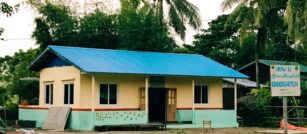
How I donated $300,000 Thanks to My Blog
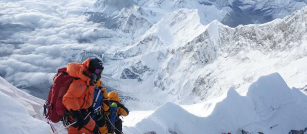
Climbing Mount Everest – Everything You Need to Know from My Experience. Costs, Difficulty Etc
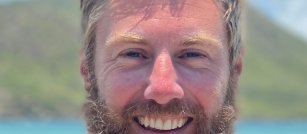
Rowing Across the Atlantic Ocean; My Experience
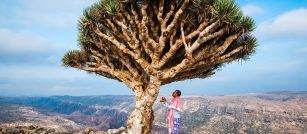
JOIN MY TOUR TO SOCOTRA – April 2024

How To Start A Travel Blog in 2024 from ZERO
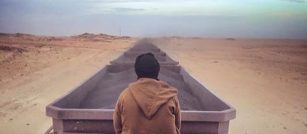
Riding the Iron Ore Mauritania Train across the Sahara Desert
Juicy links.
- About Johnny
- Central Asia
- Destinations
- Getting Started with One Step 4Ward!
- Join a Trip
- My Partners
- One Step 4Ward Blog
- Privacy Policy
- Public Speaking
- Thank you for ordering!
- Travel Resources
- Waiting List
- Where I’ve Been…
- Travel Tips
- My Lifestyle Design
- Travel Bucket Lists; A List of travel things to do before you die!
- Inspirational Quotes
Thanks for deciding to subscribe to my blog, it means a lot to me that people trust a normal guy from Ireland.
You should be proud you're taking a new step to changing your life.

Take ownership. Take action, and remember
"If you don't build your dream, someone will hire you to help build theirs"

- +91 9560897780
- Network websites
- Tour Packages
Mount Puncak Jaya (Carstensz Pyramid) Expedition
- Find a Tour
- Select Theme Activity Holidays Adventure In Himalaya Affordable Treks Ayurveda & Spa Bali Tour Packages Beach Tour Packages In India Chardham Yatra Tour Packages Climbing Expeditions Climbing The Seven Summits Coorg Trekking Packages Corbett Tour Packages Culture & Heritage Cycling Trips Dalhousie Tour Packages Darjeeling Tour Packages Dharamshala Tour Packages Do Dham Tour Packages Dodital Trek Tour Packages Domestic Expedition Domestic Programs Dubai Tour Education Tours Eight Thousand Summit Expats Travel Expedition Calendar Experiential Tours Fairs & Festivals Fam Tours Family Tour Packages Fixed Departure 2024 Gir Tour Packages Golf Tours Hemkund Sahib Tour Packages High Altitude Treks 2024 Himachal Trekking Packages Holidays Outside India India Honeymoon Tour Special India Pilgrimage Tours International Expeditions International Honeymoon Tours International Tour Packages Kailash Mansarovar Yatra Kanha National Park Tour Packages Kashmir Trekking Packages Ladakh Tour Packages Luxury Holiday Packages Luxury Trains Tour Manali Tour Packages Mountaineering Course In India Mountaineering Course India Mountaineering Expeditions In The Indian Himalayas Mountaineering In Himalayas Nagaland Trekking Packages Nepal Trekking Packages North East Tour Packages Overland Jeep Safari Packages For NRI Photography Tours In India Ranthambore Tour Packages Religious / Spiritual Tours River Cruise Rotary International Seven Summit India Shikhar - Trending Programs Of 2024 Shikhar Adventure Institute Shimla Tour Packages Short Break Sightseeing Tours Sikkim Trekking Packages South India Honeymoon Packages South India Tour Packages South India Trekking Packages Special Domestic Packages Special Interest Tours Special Offers For Expats In India Sundarban Tour Packages Tea Tour Of India Thailand Tour Packages Trek To Famous Mountains Trekking In Ladakh Trekking In Uttarakhand Trekking Tours In India Weekend Tours From Delhi Wildlife Tour Packages In India Winter Treks In Indian Himalayas Yamunotri Tour Packages
- Select Destination America Andaman And Nicobar Islands Andhra Pradesh Antarctica Argentina Arunachal Pradesh Assam Australia Bhutan Bihar Chhattisgarh Delhi Goa Gujarat Haryana Himachal Pradesh Indonesia Karnataka Kashmir Kerala Best Ladakh Madhya Pradesh Maharashtra Maldives Meghalaya Nagaland Nepal Odisha Pondicherry Punjab Rajasthan Russia Sikkim Tamil Nadu Tanzania Kilimanjaro Thailand Tibet Turkey United Arab Emirates Uttar Pradesh Uttarakhand West Bengal
- Select Days / Nights Upto 3 Days Packages 4-7 Days Packages 8-12 Days Packages 13-16 Days Packages 17-21 Days Packages 22-30 Days Packages
- Select Departure January February March April May June July August September October November December
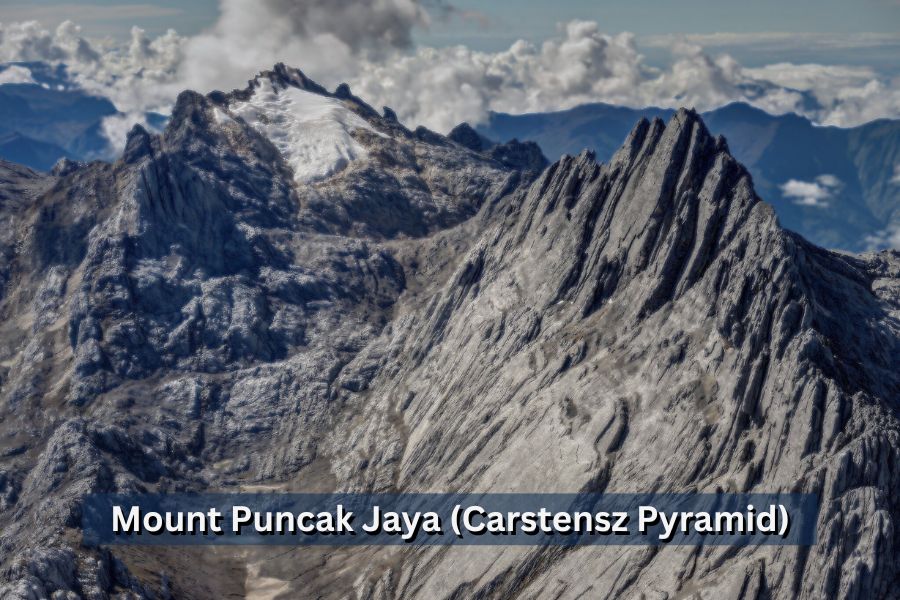
08 Oct
29 Sep
Tour Highlights
- Rickshaw ride in Chandni Chowk Old Delhi.
- Visit to seven wonder of world The Taj Mahal.
- Jungle safaris in search of royal Bengal Tiger, Bandhavgarh, Shivpuri & Ranthambore.
- Visit to UNESCO world heritage temples of Khajuraho.
- Experience Rajasthani Culture.
- Visit to seven wonder of world The Taj Mahal
Puncak Jaya, also known as the Carstensz Pyramid, is the highest peak in the Australasian continent. The name "Carstensz" was given to honor Jan Carstensz, a Dutch explorer who first sighted the magnificent white peaks in 1623. Carstensz Pyramid, also known as Puncak Jaya, is a renowned peak among the 'Seven Summits' located on the Indonesian island of Papua New Guinea. It stands out as the only rock climbing peak among the Seven Summits, requiring a trek through remote jungle to reach the base camp. The peak is situated in Papua Province, Indonesia (formerly known as Irian Jaya) on the vast island of New Guinea, the second largest in the world. Climbing Carstensz Pyramid is a challenging endeavor that has been undertaken by relatively few individuals. The area's history of political instability, coupled with its remote and dense jungle location, has contributed to the limited number of climbers. Expect diverse and often demanding conditions, including trekking through the hot jungle and climbing in snowy terrain. The rock itself offers good climbing opportunities but is known to be very sharp, emphasizing the need for sturdy gloves. Despite being the lowest of the Seven Summits, Carstensz Pyramid presents an exciting and dramatic expedition, earning its reputation as one of the most difficult summits to conquer. Regardless of the time of year, Carstensz Pyramid offers a thrilling climbing experience for adventurers seeking a unique and challenging ascent. Ascending Puncak Jaya is an incredible feat that showcases both physical endurance and technical expertise
- Price Inclusion
- Similar Itinerary
Mount Puncak Jaya (Carstensz Pyramid) Expedition itinerary
Tour highlight.
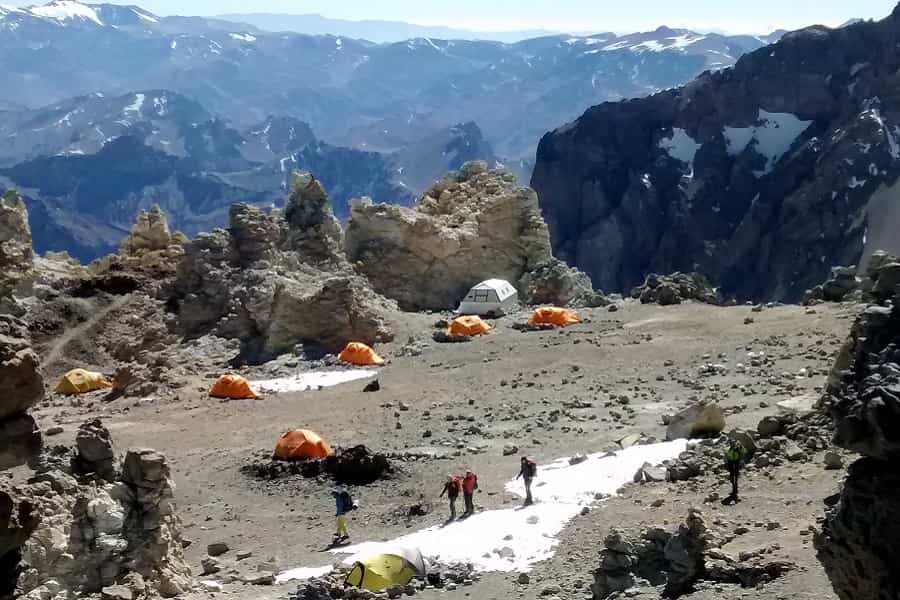
- View Details
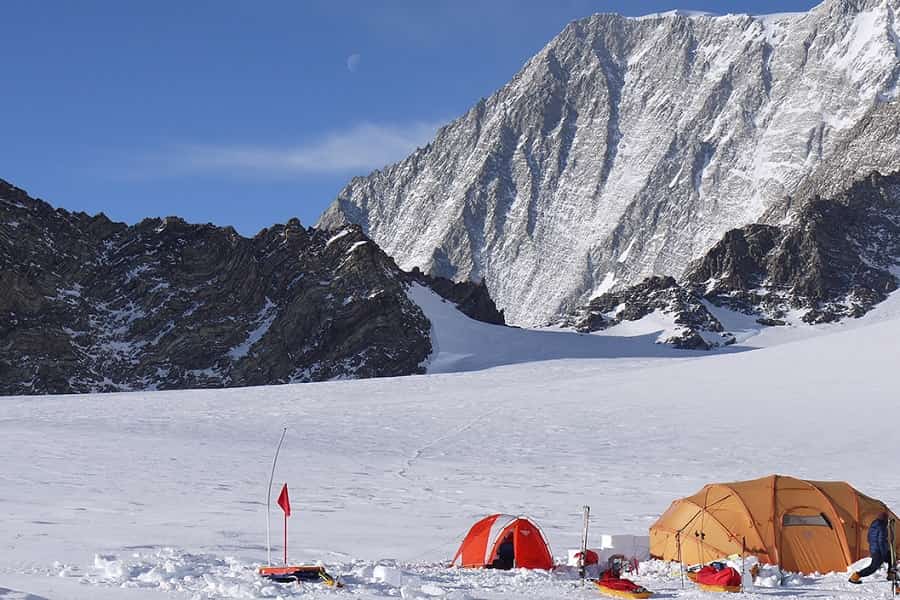
- High Operating Standards
- Friendly and Knowledgeable Staff
- Personal travel consultants
- Tailor made holiday packages
- Private Tours for individuals and groups.
- Guarantee Fixed Departures
- Flexibility in organising and bookings
- Recognised by Government of India
- Save time and effort
- Licensed and Recognised Tour Operator

Recognised by Ministry of Tourism, Government of India as Inbound Tour Operator & Adventure Tour Operator. Registered with Indian Mountaineering Foundation.

- Incentive Ideas
- Activity Holidays
- Fixed Departure
- Luxury Holidays
- Destination Wedding
- Partner Company
- Life on the Planet Ladakh
- Airline Ticketing
- Transportation
- List of Expeditions Handled
- Women Only Travel
- Festivals of India
- Corporate Social Responsibility
- Term & Condition
- Covid Guidelines
- About Shikhar
- Awards & Achievements
- Useful resources
- Press Media
- Group Websites
- Insurance Partner
Sign-up to receive special deals, update and newsletter.
- Elbrus individually
- Elbrus from the South, 9 days
- Elbrus from the South, 7 days
- Elbrus from the South in 1 day
- Elbrus from the North
- Elbrus Two Summits
- Elbrus Traverse South to North
- Elbrus Traverse North to South
- Elbrus "Cross" from South
- Elbrus "Cross" from North
- Kazbek+Elbrus
- Elbrus from the West
- Elbrus by helicopter
- Elbrus holidays, 9 days
- Elbrus holidays, 7 days
- Elbrus by weekend
- Kilimanjaro, Marangu
- Kilimanjaro, Lemosho
- Margaret Peak (Stanley)
- Kazbek from South
- Kazbek from the North
- Ararat in 3 days
- Volcanoes of Mexico
- Island peak
- Island Peak+Mera Peak
- Aconcagua, 7 days
- Aconcagua, 17 days
- Aconcagua + Ojos Del Salado
- Ojos del Salado
- Chimborazo and Cotopaxi
- Denali (Mc.Kinley)
- Khan-Tengri
- Muztagh Ata
- Gasherbrum I and II
- Peru: Ancient Inca culture
- Everest base camp
- Everest base camp via Gokyo
- Everest base camp in a week
- Annapurna circuit
- K2 base camp
- Morocco + Toubkal
- Bhutan. The Tour of Dragon Trails (Druk-Path Trek)
- The route № 30
- Lake Kardyvach
- Oshten+ Kardyvach
- Trekking Gwandra
- Tour to Morocco for New Year
- Morocco: Toubkal and the mysteries of the Sahara
- Peru: Machu Picchu and Amazonia
- Brazil: Amazon
- Brazil: Pantanal, Iguassu, Rio
- Iran: Ancient Persia from Tehran to Isfahan
- Chile: from the Atacama to Tierra del Fuego
- Safari Tanzania
- Safari Kenya
- Safari Uganda
- Bhutan, the Tour of Dragon Trails
- Our records
About the tour.
The lowest and most remote of the Seven Summits, Carstensz Pyramid (or Puncak Jaya) is also one of the most technically challenging. Flanked by glaciers, the peak rises like a shark’s fin from the jungle. Those considering a climb of Carstensz Pyramid should bear in mind that the expedition involves a degree of uncertainty and may require last-minute changes to the itinerary due to possible political instability in the region. Climbing Puncak Jaya can therefore be classified as a perfect ‘adventure trip’, full of achievement and discovery, with the promise of rare cultural experiences and classic rock climbing The route traverses challenging terrain. It is a tough, long trek to and from base camp. The main challenge of the Carstensz Pyramid climb is technical rock climbing and not just (or not so much) high altitude climbing. All group members need to be familiar with the techniques and master the skills of ropework and rock climbing. The round-trip from base camp usually takes 12-14 hours. The trek from Sagapa village to base camp is 67km. On the north face and up to the summit ridge, the route follows fixed ropes over slabs and corners. The lower part of the route involves scrambling and rock climbing of the ‘difficult’ category. There are three notches on the ridge, the first of which requires the use of a Tyrolean traverse. Physical fitness required to climb Puncak Jaya. All participants in the Carstensz Pyramid Climb must be in excellent physical shape and condition in order to integrate properly into the team and to enjoy the trip personally. Physical fitness is also required in the interest of both personal success and safety. Adequate training and experience of carrying heavy packs (approximately 30 lbs or more) for several days is required to achieve the appropriate level of fitness.
7-day itinerary of the Carstensz Pyramid Climb with guide (helicopter drop).
Day 1. Meeting at Timika airport, transfer to the hotel, meeting with the guide, check of equipment and receipt of permits. Dinner and instructing the group. Overnight at the hotel. Day 2. Helicopter flight to the base camp of Carstesz Pyramid (4100m), easy acclimatisation walk, test of equipment use. Day 3. Testing the use of the equipment, acclimatisation. Day 4. Climbing the Carstesz Pyramid (4884m), 10-12 hours of climbing of varying difficulty, the region often has rainy weather – be prepared for this. Day 5. Reserve day. Day 6. Flight to Timika. Day 7. Departure.
Included in the price of the ascent of the Carstensz Pyramid:
- Experienced English speaking guide.
- Local guides.
- Helicopter transfers to and from base camp.
- Double room accommodation in hotels.
- Necessary permits for climbing.
- Equipment, wages and insurance.
- Meals (three meals a day) and fuel during the trek and at base camp for participants.
- Ecological fees.
- Dining tent.
- Fixing of ropes.
- All transfers according to the program.
- Equipment for the group (ropes, ice screws, radios, first aid kit, satellite navigator/GPS).
Not included in the price of the Carstensz Pyramid Climb:
- International Flights to Timika (Indonesia).
- Indonesian Visa.
- Local porters.
- Medical insurance.
- Private equipment.
- Expenses in case of early termination of the expedition.
- Expenses in case of flight delay or cancellation.
- Overweight on aeroplanes.
- Change of hotel or individual accommodation.
- Any costs caused by the changing of the programs
Equipment for climbing Carstesz Pyramid peak:
- Valid passport.
- Flight tickets.
Personal equipment:
- Backpack. 50-60l.
- Sleeping bag, comfort temperature from -15C to -5C.
- Sleeping mats.
- Trekking poles.
- Carabiners, 5 pieces.
- Mountaineering lanyard.
- Belay device.
- Cup-Spoon-Bowl.
- Climbing helmet.
Clothing and footwear:
- Trekking boots.
- Trainers (for cities).
- Waterproof layer – jacket + trousers. The industry offers a wide range of products, from simple 5000/5000 membranes to Gore-Tex products.
- Fleece suit.
- Thermal underwear layer – top and bottom.
- Thick gloves.
- Thin gloves.
- Neckerchief.
Miscellaneous:
- LED Headlamp.
- Sunglasses.
- Sunscreen and lip balm.
- Chemical heaters (not essential, but can be very useful).
- Personal first aid kit.
- Elastic bandage and/or support bandage.
You may also like
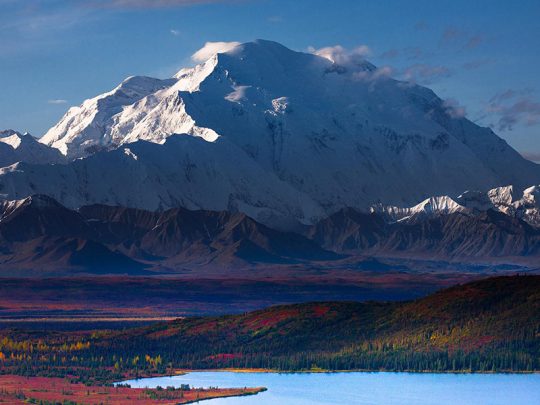
Climb Denali (Mc.Kinley)
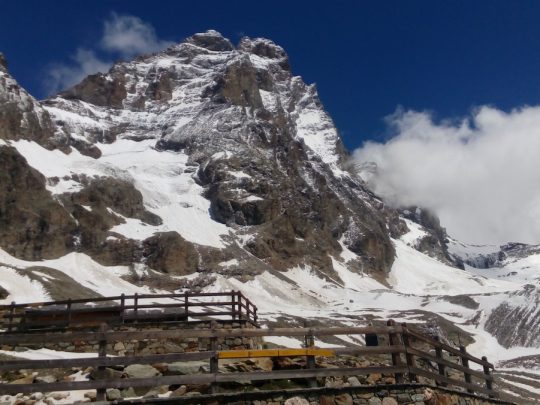
Climb Matterhorn
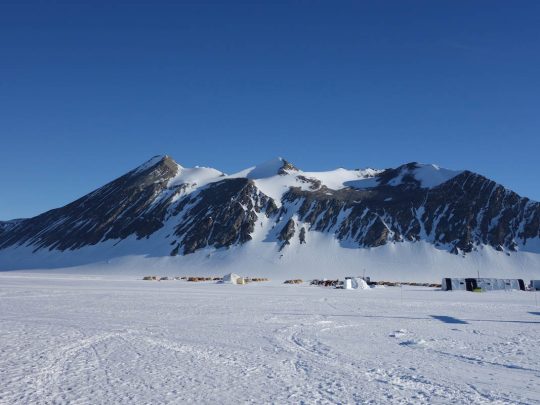
Subscribe to our newsletter

- Trip Reports
- Areas & Ranges
- Huts & Campgrounds
- Logistical Centers
- Fact Sheets
- Custom Objects
- Plans & Partners
- Puncak Jaya and surrounding mountains

- Images (56)
- Climber's Log Entries
- Additions & Corrections
- Overview of Puncak Jaya region
The vast Suridiman Ranges run East to West accross West Papua and the majority are unclimbed as they are particulary remote and very difficult to get to. This map shows some of the immediate mountains and trails around Puncak Jaya
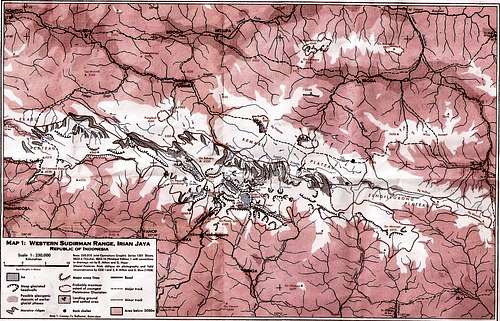
- Getting There
There are numerous airlines that fly to various destinations which will serve as launching points for your Puncak Jaya or surrounding mountains expeditions There are generally three different ways of getting to Puncak Jaya 1. Jakarta-Denpassar-Timika-Illaga, Beoga, Sugapa 2. Jakarta-Manado-Nabire-Enaratoli-Puncak Jaya (Enaratoli-Puncak Jaya helicopter route) 3. Jakarta-Denpassar-Timika-Jayapura-Wamena-Ilaga, Beoga, Sugapa (rarely used way these days as very long and circuitous route) Wamena Trigana Air-Jayapura to Wamena return. Its best to catch the early flights both ways if possible as Wamena is in a valley and quite often fog will descend early in the afternoon and the flights will be stopped. Was around 600K Rupiah each way. Merpati flies to many other regions from Timika and Jayapura. Military Hercules C130 aircraft fly all over West Papua but you need to know someone to get onto these flights. The best way to get into Wamena is via Timika as they fly direct each week and bypass the need to go to Jayapura. Enaratoli Merpati air Charter with Aviastar Nabire If you want to fly to Puncak Jaya (Carstensz Pyramid) one helicopter charter company is PT. Cheysea Aurelia JL. Pemuda No. 14 Nabire Telephone/Fax 0984 26018-23618 Sugapa(Bilogai), Illaga, Beoga. Pogapa Trigana air flies to Beoga each Monday morning at 6am and returns directly after a quick turnaround in Beoga. Charter with Aviastar which is situated at Timika airport though the office is difficult to find unless you know Bahasa and can ask around. Remember when asking around at the airport that it is most manned by employees of Freeport. Mission Aviation Fellowship flies to a multitude of remote villages but it is highly unlikely you will get a seat with them, even if you try to charter a flight. This is especially so out of Timika as they often fly charter for employees of Freeport and it seems they dont like to carry around pesky tourists. In Wamena MAF is more flexible and approachable though you need to catch up with the expat pilots and discuss options, no point trying to negotiate a flight with the MAF office staff. From Wamena you can fly to Illage, Beoga, Sugapa villagers or any other remote village near to the mountain ranges.
- Travel Permit required (SKJ)
West Papua is unusual in that you must have a Surat Jalan (travel permit) to go to all places except for Sentani/Jayapura. All other destinations in West Papua require a SKJ. Interestingly all tour operators will tell you just how hard it is to get a permit to travel in West Papua though it’s a load of nonsense aimed at dramatically inflating the prices of any expeditions or tours. Having said that there are “special” places that do require much more effort to obtain a SKJ. The vast majority of people reading this submission will be those who are purely interested in travelling to Puncak Jaya (Carstensz Pyramid) which is one of those special places. Permits have always been historically hard to get, purely as a result of the influence some tour operators have in Indonesia. They deal with “contacts” who provide the SKJ as required and “special” read bribes are paid to expedite these SKJ. However it is possible to get a SKJ to Puncak Jaya though the difficulty should not be underestimated. Please see my page on Puncak Jaya for more in-depth information on the SKJ process specific to Puncak Jaya. How to get an SKJ for general travel. You will need an Indonesia Tourist Visa granted for most on arrival. In addition you will need 2 passport photos on a red background. Armed with these you can proceed to the Police Station to receive your SKJ to most destinations in West Papua. Some expedition operators are able to bypass some stages of this process. In most cases an SKJ can be issued while you wait. The police generally will not issue an SKJ for Puncak Jaya for Solo travel. It seems that the Indonesian expedition operators have had a word in their ears and the police will say for Puncak Jaya you need a group of around 5. In turn you would call it an International Expedition. When you get your SKJ make sure you take quite a few copies depending upon how many villages you intend to travel via on your way to any mountains. Your SKJ must list all the regions in West Papua you will be travelling through. This includes Puncak Jaya, Ngala Pulu and all the villages you will pass through. It is likely that at most villages a Military or Police person will want to see your SKJ. Especially at your starting points. I have always listed multiple locations and regencies on my SKJ to ensure that I have no problems. Now it is possible to just list specific regencies and make no mention of going to any mountain. For example you can have Nabire, Enaratoli, and then list the regencies, say Puncak Jaya regency, or if you are coming in via Timika list Timika then your next arrival village which for most will be either, Beoga, Illaga and the most usual Sugapa and then Puncak Jaya regency. You must be able to speak Bahasa or have someone with you who can to facilitate your passage through the arrival villages and beyond. You will be approached by Police or Military at Supaga or any of the other arrival villages. In addition you will need to be able to negotiate porters, guides, cooks and also passage through the village. The will be "fees" to be paid and these can vary dramatically. Fees like access and payments to the village chief etc. Military or Police may also wish to extract a "fee" to allow you to pass. Generally with the right attitude you will eventually overcome these hurdles and be on your way to trek to whichever mountain you wish to go to. For all remote destinations in West Papua you will be required to show your SKJ, quite often upon arrival and in nearly all towns it is the Law that Hotels keep a record of your SKJ and must report your arrival to the Police within 24 hours. In remote villages when hiking you will pass via both Police and Military post. It is highly likely that at each of these you will be asked for your permit. In most cases a friendly outgoing nature will go a long way, though in some areas you may be required to pay a "fee" to proceed. This is commonplace and will generally only be a small amount. Remember these guys are paid next to nothing so this will supplement their income. Indonesia survives on bribes and this is commonplace. Once you know a region, say Wamena you soon learn where these posts are and how to avoid/circumnavigate them. I have travelled in all directions from Wamena and have only ever had to show my SKJ once. There are posts everywhere and sometimes your guide will feel obliged/scared/co-conspirator for you to stop and make a visit/payment It is wise to only stop in Timika if that is your entry point for a very limited time to get food stocks etc. There is nothing else to do in Timika and climbers attract attention quickly. Word spreads quickly in these towns. You will have arranged your Aviastar charter flight in advance so it may be that you leave early the very next day. Most flights leave as early as 6am as clouds and poor weather can quickly close any flights to outlying villages. A word of note, the Sheraton Timika is not really a Sheraton Hotel. It is staffed and run by Freeport.
- Puncak Jaya expedition providers
All Western mountaineering sites offering Puncak Jaya will subcontract all preparations to local Indonesian expedition operators. There will be a huge mark up to facilitate this and sadly a lot of climbers fall for the ridiculous fees being charged for Puncak Jaya. Quite often their choice will be based on reports that many Indonesian operators struggle in organising this expedition. I have many years of experience in this region and have known all the major and minor expedition providers both good and bad. The best local outfit is Franky Kowas of Adventure Indonesia who I have known for a long time. His outfit is highly experienced and he has many years experience placing people on the top of Puncak Jaya. Another local operator Carstensz Expedition appears to be having good success There is a one Western Outfit Dr Werner Weiglein who has one of his bases at Wamena though he is primarily based in Germany. He achieves good success though often he is closely associated with Freeport Indonesia and I guess ethical climbers may choose to base their decision upon this fact. At some stage in the not too distant future, trekkers will be able to readily access via the local village of Tsinga. Freeport has spent a great deal of money building an airstrip there which is to be opened on 23 March 2010. Tsinga is within the vast Freeport Contract of Work. Tsinga is only a short flight from Timika and will be readily accessible by light plane. This northerly route from Tsinga is only about 12 kilometres so trekkers will find this route much more affordable and far easier going. However this depends upon who of the above trekking companies exert pressure upon the local West Papuan people. My bet is Dr Werner Weiglein will be pushing very hard to take control over these people as he has too much time and money invested in PJ. time will tell. The route is already surveyed from Tsinga and follows old trails.
- Surrounding Mountains
Ngalu Pulu Puncak Idenburg
- Treks around Puncak Jaya
When you have arrived in the Puncak Jaya region you have the option of setting up a base camp to explore Puncak Jaya, nearby Ngala Pulu and the other 4 glaciers surrounding Puncak Jaya. If you have the luxury of time and able to move base camp then there is inumerable mountains over 4000 metres to scale. All will require a lot of logistical planning and forward planning as they are very remote areas to be climbing. In order to get to mountains in a Westerly direction from Puncak Jaya you will need to trek down past the 4 lakes and down to Zebra Wall (around 1.5 hrs) the ascend the huge Freeport Bali waste dump. You can walk to the top of this safely but remember you are now on Freeport contract of work area and if spotted people will report you. You will need to circumvent the mine area by walking around the waste dumps in an north westerly direction. It is imperative that you are no where near where the Haul trucks are moving or dumping over the edge of these waste dumps. They deliver over 300 tons of rubble and you will be killed. This is why no one should enter the mine area! It is possible with more effort to climb the mountain ridges to the rear of the mine and circumvent the mine area totally. Alternatively you can return to the lakes and ascend the New Zealand pass and then make your way around to the westerly mountain range.
- The road through Freeport Mine (PTFI)
The easiest route to Puncak Jaya, Ngala Pulu and surrounding mountains is by far the PTFI, Freeport road. This road runs from Amamapare at Mile 0 to Mile 74 which is the concentrate mill at the base of the mountains Key points along the road are M24 where there is a security entry point adjacent to Timika airport M38-security post M50-security post located at the base of the mountains M66-security post at Hidden Valley where employees with families reside in houses and apartment M68-Tembagapura M73-Road junction to the HEAT (heavy equipment access trail) which runs up the side of the mountains and brings you out at the ridgeline bordering the giant Grassberg open cut pit. M74-the mills and concentrators at the base of the ridgeline. At this point there is a cable car which climbs around a kilometre to the ridgeline above. From Timika it is only around 2.5 hours by 4WD to get all the way to the cable car at M74 It is possible to utilise and walk this road but this takes determined effort and some serious planning. It cannot be attempted during the day as hikers would be spotted and immediately arrested by Freeport SRM (security and risk management) staff. You will then find yourself in the Timika police cells and eventually escorted onto a Garuda plane to Bali or Jakarta. Hikers who have previously been caught at any point on the mine property have spent up to a week in Timika under custody. There is a 1 kilometre tunnel at Mile 58 and this has a signal controller in a hut at each end. Traffic flows in one direction at a time and is controlled by these men and Stop/Go boards at the huts. Inside the tunnel there is no where to avoid any traffic. Historically with the right contacts it has been possible to "bribe" the TNI (military) or Brimob (special police) to provide escorts up to the start of the puncak Jaya trek at the top of what is known as the Bali dump (where mining waste is now piled 750 metres deep at and way above the Zebra Wall. These guys are not required to submit to any form of security checks and just drive through the Freeport security checkpoints. They are a law unto themselves and not answerable to Freeport. Most recent bribes have been in the vicinity of several thousand $US up and back.
View Puncak Jaya and surrounding mountains Image Gallery - 56 Images
- Areas & Ranges in Haiti
You need to login in order to vote!
Don't have an account.
- Rating available
- Suggested routes for you
- People who climb the same things as you
- Comments Available
- Create Albums

- 3-8 Days Treks
- 9-12 Days Treks
- 13-20 Days Treks
- Chadar Trek
- Expeditions
- Car Tour & Trekking
- Eco-Tour & Wellness Retreat
- Discover Tranquility at Abapa House
- PARADISE Shey
- Ice hockey exchange
- Discovering Us

EXCLUSIVE ADVENTURE PACKAGES
For a truly unforgettable experience this holiday season.
Discover the untamed beauty of Ladakh, where majestic mountains, serene lakes, and ancient monasteries create a journey like no other. Immerse yourself in the rugged landscapes and vibrant culture for a holiday experience that will stay with you forever.
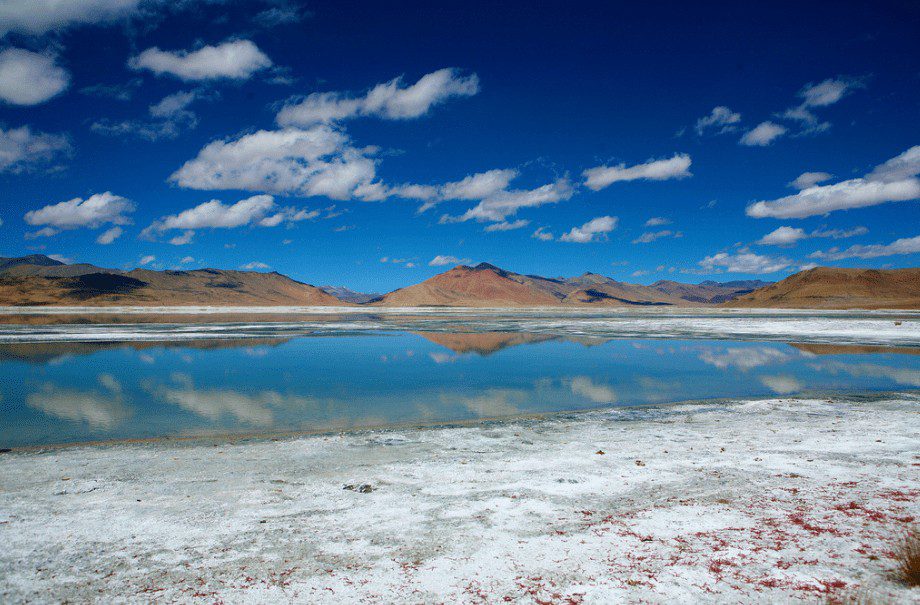
Explore our featured offers
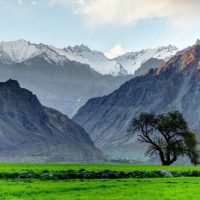
Nubra Turtuk Tour : A 3-Day
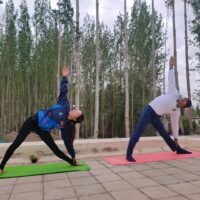
Ladakh Adventure, Meditation, and Yoga : A 11-Day

Padum to Darcha Trek: A 13-Day
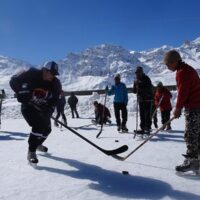
Ice Hockey Cultural Exchange Program
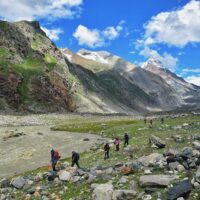
Warwan Valley Loop Trek: 10 Days of Epic Adventure and Timeless Beauty
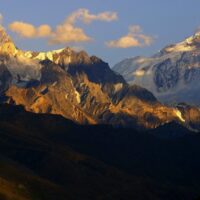
Mount Kun Climbing Expedition (7077 M)

Ladakh Ecological Exploration : A 13-Day
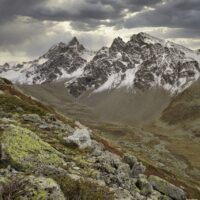
Rangdum to Lamayuru via Kanji La Trek – A 7-Day Ladakh Adventure | High-Altitude Trek
Why choose us, enchanting landscapes.
Discover the breathtaking allure of Ladakh’s untouched wilderness, where towering mountains and pristine lakes paint an unforgettable picture of serenity and adventure
Tailor-Made Journeys
Experience Ladakh on your terms. We craft personalized itineraries that dive deep into the region’s hidden gems, ensuring every traveler embarks on their own unique adventure
Authentic Himalayan Cuisine
Savor the rich flavors of Ladakhi cuisine, steeped in tradition and crafted from locally sourced ingredients, offering a true taste of the Himalayas with every bite
Exceptional Service
Our dedicated team provides seamless, exclusive service from start to finish, ensuring that your journey through Ladakh is as smooth as it is unforgettable
Guaranteed Departures
With our well-established tours, we guarantee fixed departure dates, ensuring your Ladakh adventure happens without a hitch, no matter the season
Immersive Local Stays
Stay in handpicked, authentic Ladakhi homestays and eco-lodges, where comfort meets cultural immersion, and every night is an experience of its own
Exclusive Perks for Guests
From expert guides to VIP access, we offer unparalleled benefits that enhance your exploration of Ladakh’s hidden treasures, making your journey truly special
Unmatched Value
We provide unbeatable offers that combine premium services, breathtaking landscapes, and unforgettable experiences, all while delivering exceptional value for your investment
Tenzin Gyatso, the 14th Dalai Lama

IMAGES
VIDEO
COMMENTS
The Carstensz Pyramid, also known as the Puncak Jaya, is the highest peak in the Australasian continent. The Carstensz name was given after Dutch explorer Jan Carstensz after he recorded his sighting of the glorious white peaks in the distance in 1623. ... The trek to base camp is relatively strenuous, and requires that you are able to walk ...
Puncak Jaya (Carstensz Pyramid) Indonesia, 4884m. Carstensz Pyramid, also known as Puncak Jaya is one of the famous 'Seven Summits' situated on the Indonesian island of Papua New Guinea.This peak is the only of the Seven which is a rock climbing peak and it requires a trek in through remote jungle to reach the base camp.
Puncak Jaya (Carstensz Pyramid) is the tallest mountain in the continent of Australia. Indonesia is geographically in Asia, where Mount Everest is the tallest, but the country stretches out to the continent of Australia (which is where Puncak Jaya lives). Known as "Nemangkawi" to the tribespeople of Papua, the mountain was not known by ...
The Puncak Jaya Expedition is an ideal way to embark on a journey to the summit of a peak. Puncak Jaya, also known as the Carstensz Pyramid, stands tall with a height of 4,484m (4.484km) in Papua Province of Indonesia. It is the highest peak within the Oceania continents. Despite being the smallest one among the seven summits, it still is the ...
At 16,023 ft. (4,884 m), Carstensz Pyramid (Puncak Jaya in Indonesian, meaning "Victory Peak") is located in the western central highlands of West Papua and is the highest peak in Oceania, the Australiasia continent. The English name for the mountain was after Jan Carstensz, a Dutch explorer who was the first European to sight the peak.
Carstensz Pyramid. At 16,024 feet, Carstensz Pyramid is the highest point in Indonesia and the highest mountain in Oceania. Locally known as Puncak Jaya, it is a dramatic pinnacle rising from the sheer, serrated ridgeline of the Sundirman Range on the lush island of New Guinea. While it is not the highest or most strenuous of the Seven Summits ...
Puncak Jaya was named "Carstensz Pyramid" after Dutch explorer Jan Carstenszoon, who was the first European to sight the glaciers on the peak of the mountain on a rare clear day in 1623. [4] ... or spend an additional four to five days to trek to base camp from the nearest town, Sugapa. [14]
Carstensz Pyramid, also known as Puncak Jaya, is the highest peak in Oceania, and one of the Seven Summits. Located in the Indonesian province of Papua, this challenging peak stands at an elevation of 4,884 meters (16,024 feet) and is a popular destination for experienced mountaineers and adventurers. ... Any high altitude trek requires you to ...
Puncak Jaya (Carstensz Pyramid) is Southeast Asia's Mount Everest. Carstenz Pyramid (Puncak Jaya) is one of the "7 Summits" - the highest points on each continent - it being assigned to Australasia rather than Asia. ... The starting point of your trek is a quick motorbike ride from the Sugapa Airport. Accessibility Puncak Jaya ...
Puncak Jaya Papua Go on a trek to Carstensz Pyramid (4884m), the highest summit of Mount Jayawijaya or Mount Carstensz in the Sudirman Range of the western central highlands of Papua Province. During this challenging journey, you will have to tackle a rocky terrain all the way to the summit.
Origins and Meaning. 'Victorious peak' in Indonesian. The highlands surrounding the peak were inhabited before European contact, and the peak was known as Nemangkawi in Amungkal. Puncak Jaya was named "Carstensz Pyramid" after Dutch explorer Jan Carstensz who first sighted the glaciers on the peak of the mountain on a rare clear day in ...
Brief Information About: #CarstenszPyramidExpedition"-7th summit-Asia Pacific Puncak Jaya or Carstensz Pyramid (4,884 m) is the highest peak of Mount Jayawijaya in the western central highlands of Papua Province, Indonesia.At 4,884 meters above sea level, Carstenz Pyramid is the highest mountain in Indonesia. This is also the highest point between the Himalayas and the Andes, and…
Puncak Jaya is also the highest mountain in Continental Australia, it's located on Papua island, Indonesia. In May 2019, I finally managed to climb Puncak Jaya and for a fraction of the cost of the normal prices, which are often quoted at $13k to $20k USD. Ouch. I did it for well under $10k. Read on and see how I did it (and how you too can ...
Puncak Jaya, also known as the Carstensz Pyramid, is the highest peak in the Australasian continent. ... It stands out as the only rock climbing peak among the Seven Summits, requiring a trek through remote jungle to reach the base camp. The peak is situated in Papua Province, Indonesia (formerly known as Irian Jaya) on the vast island of New ...
Much of it was still unexplored by outsiders as recently as the 1930s. The Dutch began serious exploration in about 1898. After the Indonesians defeated the Dutch in 1949 and 1950, the Dutch insisted on keeping Irian Jaya. They finally gave up the colony in 1963, under a combination of military and diplomatic pressure.
Climbing Puncak Jaya can therefore be classified as a perfect 'adventure trip', full of achievement and discovery, with the promise of rare cultural experiences and classic rock climbing The route traverses challenging terrain. It is a tough, long trek to and from base camp.
In order to get to mountains in a Westerly direction from Puncak Jaya you will need to trek down past the 4 lakes and down to Zebra Wall (around 1.5 hrs) the ascend the huge Freeport Bali waste dump. You can walk to the top of this safely but remember you are now on Freeport contract of work area and if spotted people will report you.
Ascending Puncak Jaya is a remarkable achievement that showcases both physical resilience and technical proficiency. Mount Puncak Jaya (Carstensz Pyramid) Expedition Itinerary. Day 1: Bali to Timika, Papua Flight. Embark on a 3-hour flight from Bali to Timika. Upon arrival, finalize preparations for your trek and climb. Stay overnight in a ...
Facts and practical information. Puncak Jaya or Carstensz Pyramid, Mount Jayawijaya or Mount Carstensz on the island of New Guinea, with an elevation of 4,884 m, is the highest mountain peak of an island on Earth. The mountain is located in the Sudirman Range of the western central highlands of Papua Province, Indonesia, in the southwest of ...
Port Kavkaz (Russian: Порт Кавказ) is a small harbour on the Chushka Spit in Krasnodar Krai, Russia, on the eastern side of Kerch Strait.It is adjacent to the village of Chushka, which is now largely deserted due to toxic effects of the port.. The port is able to handle vessels up to 130 metres (430 ft) in length, 14.5 metres (48 ft) in breadth and with draft up to 5 metres (16 ft). [2]
Krasnodar Krai is located in the southwestern part of the North Caucasus and borders Rostov Oblast in the northeast, Stavropol Krai and Karachay-Cherkessia in the east, and with the Abkhazia region (internationally recognized as part of Georgia) in the south. [14] The Republic of Adygea is completely encircled by the krai territory. The krai's Taman Peninsula is situated between the Sea of ...
COPY LINK. Drones struck a train ferry at a Russian railway station and port east of Crimea on Tuesday morning, July 23, leaving one dead and five wounded local authorities said. "The Kyiv regime has once again attempted a terrorist attack on the territory of Krasnodar Krai," Governor Veniamin Kondratyev claimed in a Telegram post.
Krasnodar [a] is the largest city and the administrative centre of Krasnodar Krai, Russia.The city stands on the Kuban River in southern Russia, with a population of 1,121,291 residents, and up to 1.226 million residents in the Urban Okrug. [14] In the past decade Krasnodar has experienced rapid population growth, rising to become the thirteenth-largest city in Russia, and the second-largest ...